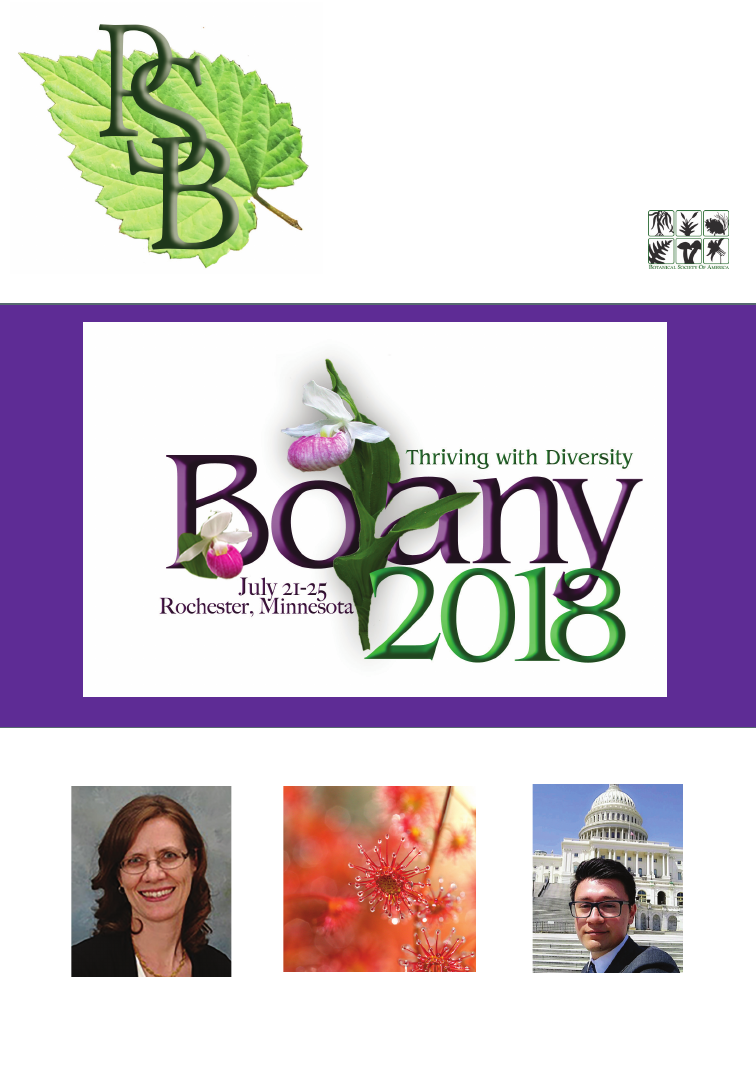
IN THIS ISSUE...
SUMMER 2018 VOLUME 64 NUMBER 2
PLANT SCIENCE
BULLETIN
A PUBLICATION OF THE BOTANICAL SOCIETY OF AMERICA
Rebekah Mohn wins Triarch
photo contest....p. 79
Theresa Culley on the perils of
predatory publishers..p. 96
Report from Congressional Visits
Day participants.... p. 81
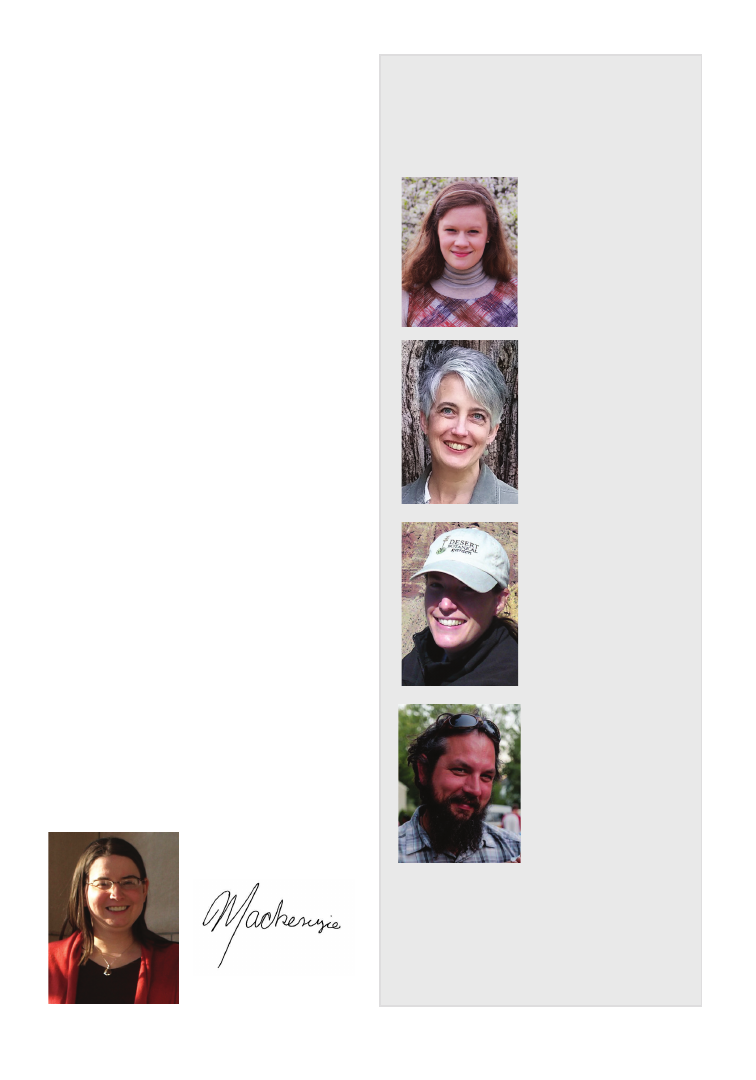
SUMMER 2018 Volume 64 Number 2
PLANT SCIENCE BULLETIN
Editorial Committee
Volume 64
From the Editor
Kathryn LeCroy
(2018)
Environmental Sciences
University of Virginia
Charlottesville, VA 22904
kal8d@virginia.edu
Melanie Link-Perez
(2019)
Department of Botany
& Plant Pathology
Oregon State University
Corvallis, OR 97331
l
inkperm@oregonstate.edu
Shannon Fehlberg
(2020)
Research and Conservation
Desert Botanical Garden
Phoenix, AZ 85008
sfehlberg@dbg.org
David Tank
(2021)
Department of Biological
Sciences
University of Idaho
Moscow, ID 83844
dtank@uidaho.edu
Greetings,
In this summer issue of Plant Science Bulle-
tin, you will find lots of important Society
News. We have information about the up-
coming Botany 2018 meeting in Rochester
and the traditional pre-conference list of
award winners and election results. I am
also happy to bring you this year’s reports
from the annual Congressional Visits Day.
I want to draw your attention to a special
feature in this issue. One of the most im-
portant things many of us do is publish sci-
entific articles; publishing is how we com-
municate new knowledge and, for many
of us, how we prove our worth to tenure
committees and grant panels. However,
publishing can be fraught with challenges.
In this issue, Theresa M. Culley addresses
the danger of predatory publishing and tips
for avoiding inadvertently submitting your
work to questionable journals.
If you would like to discuss these issues, as
well as other strategies for successful pub-
lishing, please note that there will be a dis-
cussion session on publishing held on Sun-
day, July 22 in Rochester, MN.
See you in Rochester!
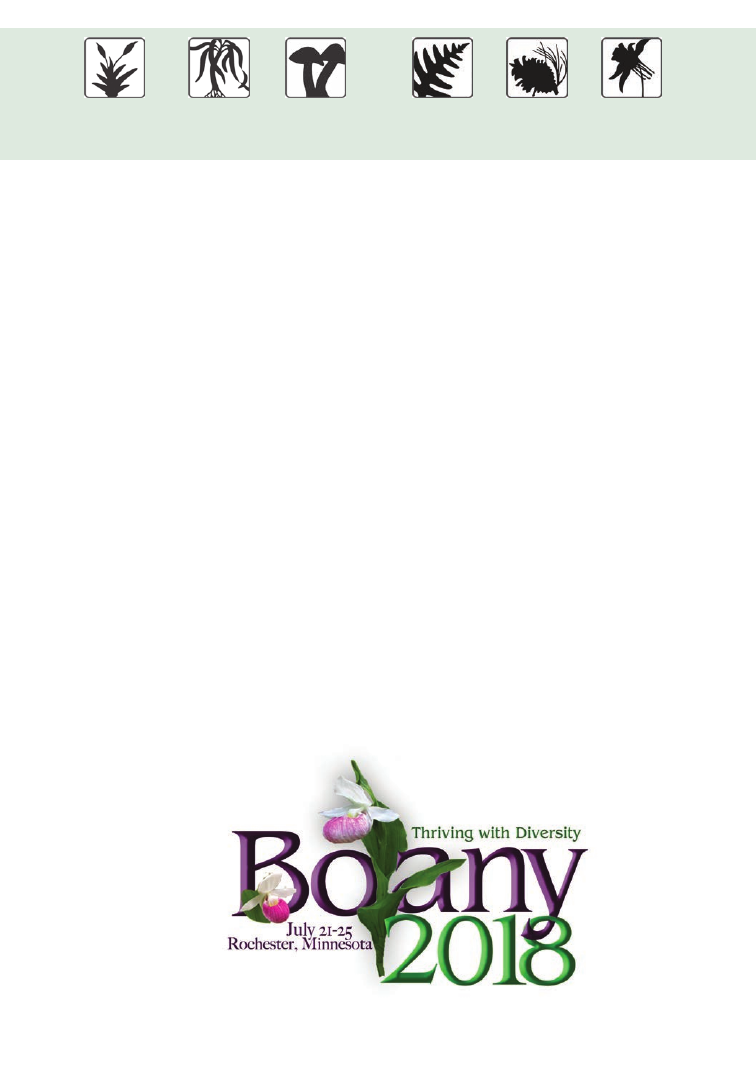
70
TABLE OF CONTENTS
SOCIETY NEWS
Election Results .......................................................................................................................................................... 71
Awards part I ................................................................................................................................................................ 72
Public Policy: Congressional Visits Day ........................................................................................................ 81
Publishing at a Crossroads in a Changing Climate............................................................................... 87
In Memoriam Barbara Webster ....................................................................................................................... 89
In Memoriam Jochen Heinrichs ...................................................................................................................... 91
Get Ready for Botany 2018 ................................................................................................................................. 93
SPECIAL FEATURES
How to Avoid Predatory Journals When Publishing Your Work ......................................................... 96
SCIENCE EDUCATION
Education News and Notes ................................................................................................................................113
STUDENT SECTION
Navigating BOTANY 2018: A Guide for Student Members ...............................................................118
BOOK REVIEWS
Ecology ..........................................................................................................................................................................122
Economic Botany .....................................................................................................................................................125
Historical .......................................................................................................................................................................130
Systematics ...............................................................................................................................................................132
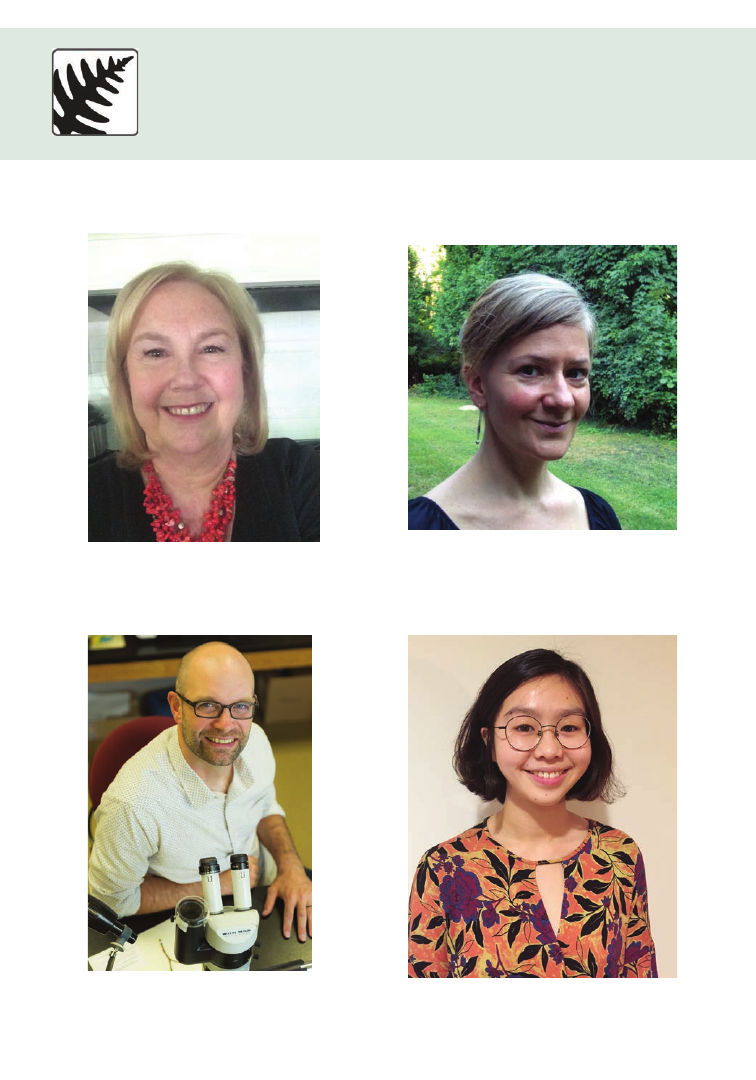
71
SOCIETY NEWS
BSA 2018 Election Results
President-Elect
Linda Watson
University of Oklahoma
Secretary
Rachel Spicer
Connecticut College
Director-at-Large Education
Chris Martine
Bucknell University
Student Representative
Ya Min
Harvard University
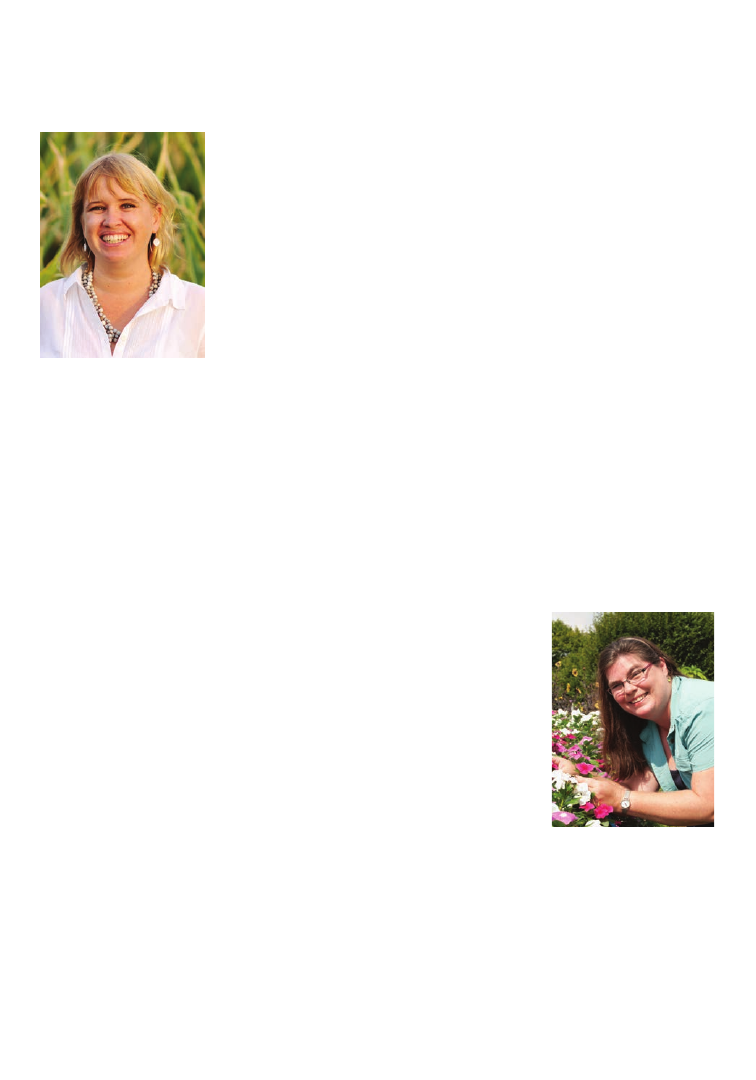
PSB 64 (2) 2018
72
Dr. Madelaine Bartlett
Receives BSA Emerging Leader Award
Dr. Madelaine Bartlett, University of Massachusetts–Amherst, is a
strongly dedicated scientist, driven by her multi-disciplinary research
on plant evolution and development with particularly strengths in
molecular and genomic evolution, plant developmental genetics,
and comparative and experimental plant evolutionary biology. Her
research uniquely combines these various focal areas of expertise,
making her one of the top plant evolutionary and developmental
geneticists of her generation.
Bartlett is fearless in developing cutting-edge research designed to understand fundamental
processes in plant development and genetic evolution, that ultimately play a key role in plant
adaptation and diversification. Through her research, teaching and mentoring, and outreach,
Bartlett has positioned herself to have a major impact on the future of scientific research and
education in botany, plant evolution, and developmental biology. Her scholarship, creativity,
energy, and drive make her the ideal embodiment of a BSA Emerging Leader.
Dr. Lena Struwe Receives
Charles Edwin Bessey Teaching Award
The 2018 recipient of the Bessey Award is Dr. Lena Struwe
(Rutgers University). The following people praised Struwe for her
accomplishments:
“In my opinion, the energy that Lena Struwe has expended on teaching
botany to people of all ages (and the success she has had in her efforts)
is unparalleled. I can’t imagine there being a person who is more
deserving of the Bessey Award.” - Dr. Christopher Martine
“Lena views herself as a learner and participates in communities
that support educators. She reflects on her teaching experiences and
adapts her courses to meet developing educational needs. She has
demonstrated herself as an excellent and effective educator in specific courses, in face-to face
public outreach, and with her online presence.” - Jennifer Blake-Mahmud
“There cannot be anyone more deserving of the Bessey Award than Lena Struwe, who has
inspired me and many others with her passion and creativity for many years. When I was
preparing to teach Plant Systematics, Lena is the person I reached out to for ideas and guidance,
because she epitomizes what I would like to be as a teacher. I can only hope to have a fraction of
her influence on her students, colleagues, and the public. She is everything that is exceptional
and desirable about a teacher—brilliant, positive, creative, engaging, generous
, supportive,
effective—the entire package.” - Dr. Amy Litt
BSA AWARD WINNERS

PSB 64 (2) 2018
73
BSA Public Policy Award
The Public Policy Award was established in 2012 to support the development of of tomorrow’s
leaders and a better understanding of this critical area. The 2018 recipients are:
Tanisha Williams, Ph.D. Student, University of Connecticut
Timothy Batz, graduate student, California State Polytechnic University
The J. S. Karling Graduate Student Research Award
Rebekah Mohn, University of Minnesota (Advisor: Dr. Ya Yang), for the proposal: Dissecting
the Evolutionary History of North American Sundews (Drosera, Droseraceae)
Ecology Section Student Travel Award
Francesco Martini, Guangxi University (Advisor: Dr. Uromi Goodale), for the presentation:
Forest regeneration in a subtropical forest: factors shaping seedling community along elevation
The BSA Graduate Student Research Awards
Jared Beck, University of Wisconsin-Madison (Advisor: Dr. Donald Waller), for the proposal:
Do natural enemies regulate herbaceous plant diversity? Examining patterns of distance- and
density-dependent mortality in temperate forests
Taylor Chae, Miami University (Advisor: Dr. Richard Moore), for the proposal: Differential
gene expression in Carica papaya associated with reverse sexual transition from dioecy to
hermaphroditism
Joseph Charboneau, University of Arizona (Advisor: Dr. Michael Sanderson), for the proposal:
Verifying and screening for chloroplast genome inversions in New World Astragalus (Fabaceae)
Katherine Culatta, North Carolina State University (Advisor: Dr. Alexander Krings), for the
proposal: Taxonomy, Population Genetics, and Status Assessment of Nuphar sagittifolia (Walter)
Pursh (Nymphaeaceae)
Aayudh Das, University of Vermont (Advisor: Dr. Jill Preston), for the proposal: Testing the
influence of extrinsic versus intrinsic factors on the evolution of grass stress tolerance
Andrea Fetters, University of Pittsburgh (Advisor: Dr. Tia-Lynn Ashman), for the proposal:
Pollination gone viral: pollinators as novel agents of plant pathogen transmission

PSB 64 (2) 2018
74
Mahboubeh Hosseinalizadeh Nobarinezhad, Mississippi State University (Advisor: Dr. Lisa
Wallace), for the proposal: Fine-scale genetic structure in rhizosphere microbial communities
associated with
Chamaecrista fasciculata
(Fabaceae)
Stacy Jorgensen, University of Arizona (Advisor: Dr. Mark Beilstein), for the proposal:
Transcriptomic desiccation response in diploid and polyploid xerophytic species of Selaginella
subg. Rupestrae
Christopher Krieg, University of Florida (Advisor: Dr. Emily Sessa), for the proposal: How
understanding the evolution of physiological traits and environmental niche can help save the
world’s most threatened plant group
Katherine Kucera, Northwestern University and the Chicago Botanic Garden (Advisor: Dr.
Andrea Kramer), for the proposal: Characterizing genetic changes in the production of multi-
source seed lots in Penstemon pachyphyllus
Kali Mattingly, The Ohio State University (Advisor: Dr. Steven Hovick), for the proposal:
Assessing the extent of hybridization between the invasive species Lythrum salicaria (purple
loosestrife) and the horticultural species L. virgatum
Samuel McCauley, University of Idaho (Advisor: Dr. David Tank), for the proposal:
Biogeographically-mediated evolution and diversification of Thalictrum (Ranunculaceae)
Juan Isaac Moreira Hernandez, University of Missouri-St. Louis (Advisor: Dr. Nathan
Muchhala), for the proposal: Interspecific pollen transfer and gene flow during the rapid
diversification of Neotropical bat-pollinated bellflowers (Campanulaceae: Burmeistera)
Kirsten Nolting, University of Connecticut (Advisor: Dr. Kent Holsinger), for the proposal:
What makes a ‘biodiversity hotspot’ hot? Trait-mediated species coexistence in seedling communities
in a fire-driven ecosystem
Lindsey Riibe, University of Florida (Advisor: Dr. Emily Sessa), for the proposal: Phylogeny &
biogeography of endemic ferns in a biodiversity hotspot
Gabriella Rossetto, Pennsylvania State University (Advisor: Dr. Peter Wilf), for the proposal:
Araucarian conifer fossils of Eocene Patagonia may reveal an Australasian rainforest connection
Aniket Sengupta, University of Kansas (Advisor: Dr. Lena Hileman), for the proposal: Of central
importance: control of carpel zygomorphy in tribe Antirrhineae by CYCLOIDEA-RADIALIS
interaction
Shengchen Shan, Florida Museum of Natural History (Advisor: Dr. Doug Soltis), for the
proposal: Developmental and genetic dynamics of the inflorescence in reciprocally formed
allopolyploid Tragopogon miscellus (Asteraceae)

PSB 64 (2) 2018
75
Mathew Sharples, University of Colorado-Boulder (Advisor: Dr. Erin Tripp), for the proposal:
Investigating the Origins of Apetaly in the Cosmopolitan Genus Stellaria L. (Caryophyllaceae)
Genetics Section Student Travel Awards
Yi Huang, University of California-Riverside (Advisor: Dr. Amy Litt), for the presentation:
Genetic Variation and habitat differentiation in a group of taxonomically difficult plants:
Arctostaphylos glandulosa (Ericaceae)
Shujun Ou, Michigan State University (Advisor: Dr. Ning Jiang), for the presentation: The
genomic composition and domestication of Asian rice revealed by 3,400 rice genomes
Serena Macias, University of Missouri-St. Louis (Advisor: Dr. Christine Edwards), for the
presentation: Phylogenomics of Passiflora sect. Decaloba reveals strong biographic structuring of
clades
Kali Mattingly, The Ohio State University (Advisor: Dr. Steve Hovick), for the presentation:
Assessing the extent of hybridization between the invasive species Lythrum salicaria (purple
loosestrife) and the horticultural species L. virgatum
Vernon I. Cheadle Student Travel Awards
(BSA in association with the Developmental and Structural Section)
This award was named in honor of the memory and work of Dr. Vernon I. Cheadle.
Glen Morrison, University of California-Riverside (Advisor: Dr. Amy Litt) for the Botany 2018
presentation: “Testing the utility of morphological traits in delimiting a variable subspecies
group, the Arctostaphylos glandulosa complex.” Co-authors: Yi Huang, Natalie Saavedra,
Thomas Stoughton, Dylan Burge, V.T. Parker, and Amy Litt
Farahnoz Khojayori, Virginia Commonwealth University (Advisor: Dr. Wenheng Zhang) for
the Botany 2018 presentation: “CYC2-like genes elucidate floral symmetry evolution following
a major biogeographic disjunction.” Co-authors: Jingbo Zhang, Elena Kramer, Charles Davis,
and Wenheng Zhang.
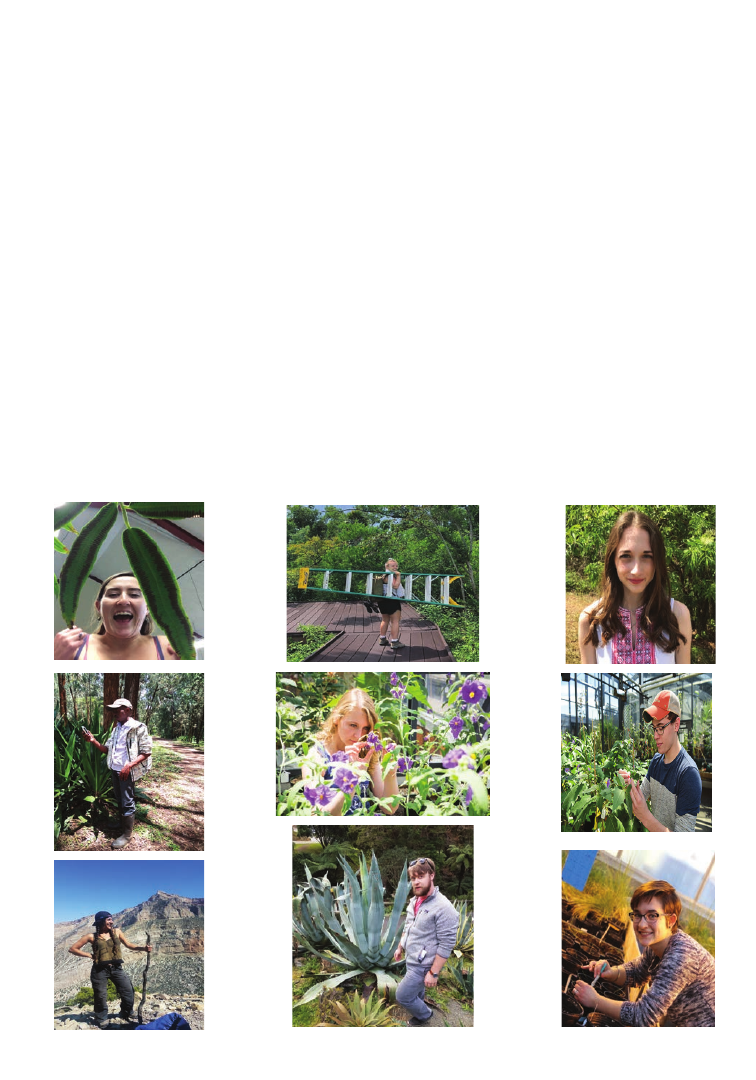
PSB 64 (2) 2018
76
The BSA Young Botanist Awards
The purpose of these awards is to offer individual recognition to outstanding graduating
seniors in the plant sciences and to encourage their participation in the Botanical Society of
America. The 2018 “Certificate of Special Achievement” award recipients are:
Shayda Abidi, Humboldt State University (Advisor: Dr. Mihai Tomescu)
Nicholas Drews, Eastern Michigan University (Advisor: Dr. Margaret Hanes)
Caroline Edwards, Oberlin College (Advisor: Dr. Michael Moore)
Michelle Gaynor, University of Central Florida (Advisor: Dr. Eric Hoffman)
Georgia Hann, Connecticut College (Advisor: Dr. Chad Jones)
Dan Hayes, Bucknell University (Advisor: Dr. Chris Martine)
Laban Kayitete, Arizona State University (Advisor: Dr. Kathleen Pigg)
Mae Lacey, Bucknell University (Advisor: Dr. Chris Martine)
Hanna Makowski, St. Mary's College - Notre Dame (Advisor: Dr. Cassie Majetic)
Mallory Malecek, South Dakota State University (Advisor: Dr. Maribeth Latvis)
Sarah McDonald, University of Guelph (Advisor: Dr. Christina Caruso)
Kelly Pfeiler, Humboldt State University (Advisor: Dr. Mihai Tomescu)
Pasteur Magine Uhaweniman, Arizona State University (Advisor: Dr. Kathleen Pigg)
Andrea Wallace, Hillsdale College (Advisor: Dr. Ranessa Cooper)

PSB 64 (2) 2018
77
The BSA PLANTS Grant Recipients
The PLANTS (Preparing Leaders and Nurturing Tomorrow’s Scientists: Increasing the diversity
of plant scientists) program recognizes outstanding undergraduates from diverse backgrounds
and provides travel grants and mentoring for these students.
Liliana Benitez, New College of Florida (Advisor: Dr. Emily Saarinen)
John Christman III, Christopher Newport University (Advisor: Dr. Janet Steven)
Inesha Ellis, Widener University (Advisor: Dr. Katherine Goodrich)
David Flanery, South Dakota State University (Advisor: Dr. Maribeth Latvis)
Andrew Gonzalez, California State University - Sacramento (Advisor: Dr. Clayton Visger)
Alexis Kantor, University of Colorado-Boulder (Advisor: Dr. Stacey Smith)
Carina Motta, University of California-Santa Barbara (Advisor: Dr. Susan Mazar)
Simone Oliphant, Florida International University (Advisor: Dr. Suzanne Koptur)
Asa Peters, Connecticut College (Advisor: Dr. Chad Jones)
Megan Rasmussen, SUNY-Farmingdale (Advisor: Dr. Eric Morgan)
Keana Tang, California State University - Long Beach (Advisor: Dr. Amanda Fisher)
Nicole Tineo, The College of New Jersey (Advisor: Dr. Wendy Clement)
Matthew Treanor, Plymouth State University (Advisor: Dr. Diana Jolles)
Delecia Utley, Howard University (Advisor: Dr. Janelle Burke)
The BSA Developing Nations Travel Grant Recipients
N. Ivalu Cacho, Instituto de Biología, UNAM, Mexico
Eliezer Cocoltzi, Universidad Veracruzana in Xalapa, Mexico
Orlando Adolfo Jara, Jardín Botánico de Bogotá, Columbia
Satish Khadia, S.D.Agricultural University, India
Nicholas Le Maire, University of Stellenbosch, South Africa
Viviana Londoño Lemos, Universidad de los Andes, Columbia
Maria Laura Pipo, INIBIOMA (UNCo-CONICET), Argentina
Boni Souleymane, University of Parakou, Benin
The BSA Professional Member Travel Grant Recipients
John Chau, University of Johannesburg, South Africa
Verónica S. Di Stilio, University of Washington
Jaime Fagundez, University of A Coruña, Spain
Joseph Gallagher, University of Massachusetts-Amherst
Ed McAssey, University of Georgia
Erik Nilsen, Virginia Tech
Tilottama Roy, Western Missouri State University
Adam Schneider, University of Toronto-Missaussaga, Canada
Laura Skates, University of Western Australia, Australia
Evelyn Williams, Chicago Botanic Garden

PSB 64 (2) 2018
78
Genetics Section Student Research Awards
Genetics Section Student Research Awards provide $500 for research funding and an addi-
tional $500 for attendance at a future BSA meeting.
Danielle Black, University of California-Santa Barbara (Advisor: Dr. Scott Hodges), for the
proposal: Identifying the genetic basis of serpentine adaptation in Aquilegia eximia
Sarah Carey, University of Florida (Advisor: Dr. Stuart McDaniel), for the proposal: Developing
near-universal sex-linked markers for mosses
Developmental & Structural Section Student Travel Awards
Amanda Katzer, University of Kansas (Advisor: Dr. Emily Sessa), for the presentation: How
understanding the evolution of physiological traits and environmental niche can help save the
world’s most threatened plant group
Dustin Ray, University of Connecticut (Advisor: Dr. Cynthia Jones), for the presentation:
Mechanical and physiological traits do not trade off in petioles
Cecilia Zumajo, New York Botanical Garden (Advisor: Dr. Barbara Ambrose), for the
presentation: Expression and functional studies of basal eudicot REPLUMLESS homologs during
flower and fruit development
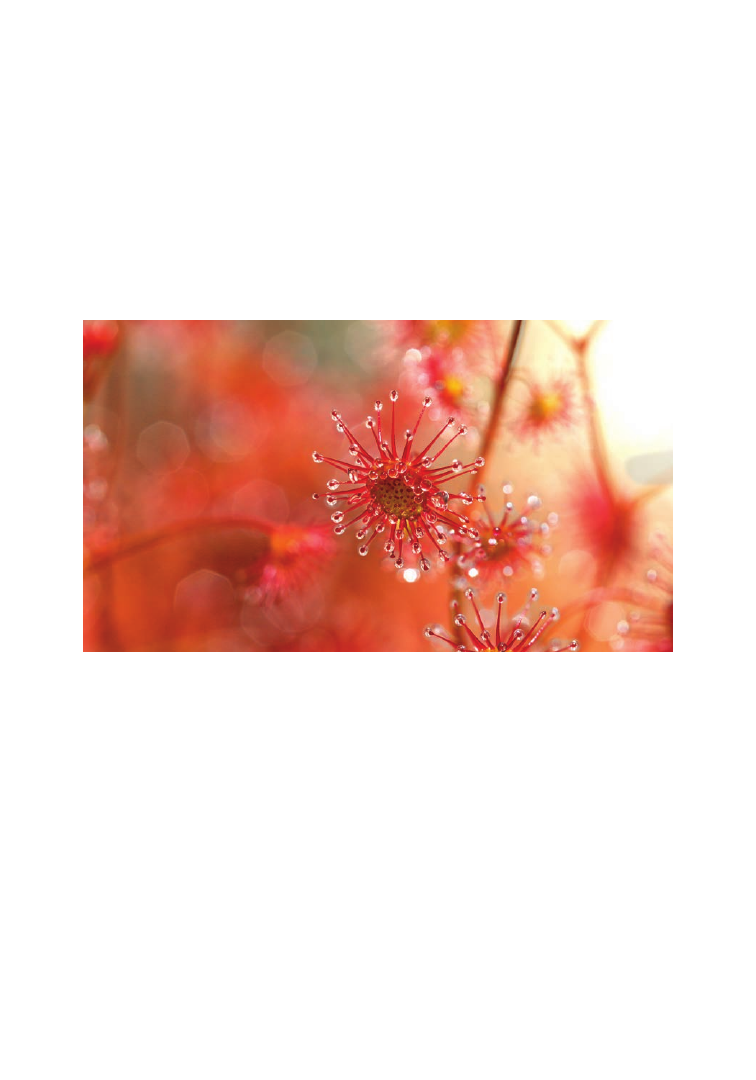
PSB 64 (2) 2018
79
Triarch “Botanical Images” Student Travel Awards
This award provides acknowledgement and travel support to BSA meetings for outstanding
student work coupling digital images (botanical) with scientific explanations/descriptions
designed for the general public.
FIRST PLACE
Rebekah Mohn
University of Minnesota
“Dewy Tentacles”
Glandular trichomes, specialized hairs that excrete mucus, cover the leaf of insect-eating
sundews like this
Drosera menziesii
. Insects become stuck to the gooey liquid excreted at the
tip of each trichome. Once the plant detects the insects by the combination of movement and
chemical changes in the mucous, the leaf and trichomes wrap like tentacles around the insects.
The presence of an insect also triggers the hairs to begin to excrete proteins like chitinases,
which can break down the insect’s body to absorb their nutrients. This provides the plant with
nitrogen and phosphorous which are often limited in the soils were these species grow.
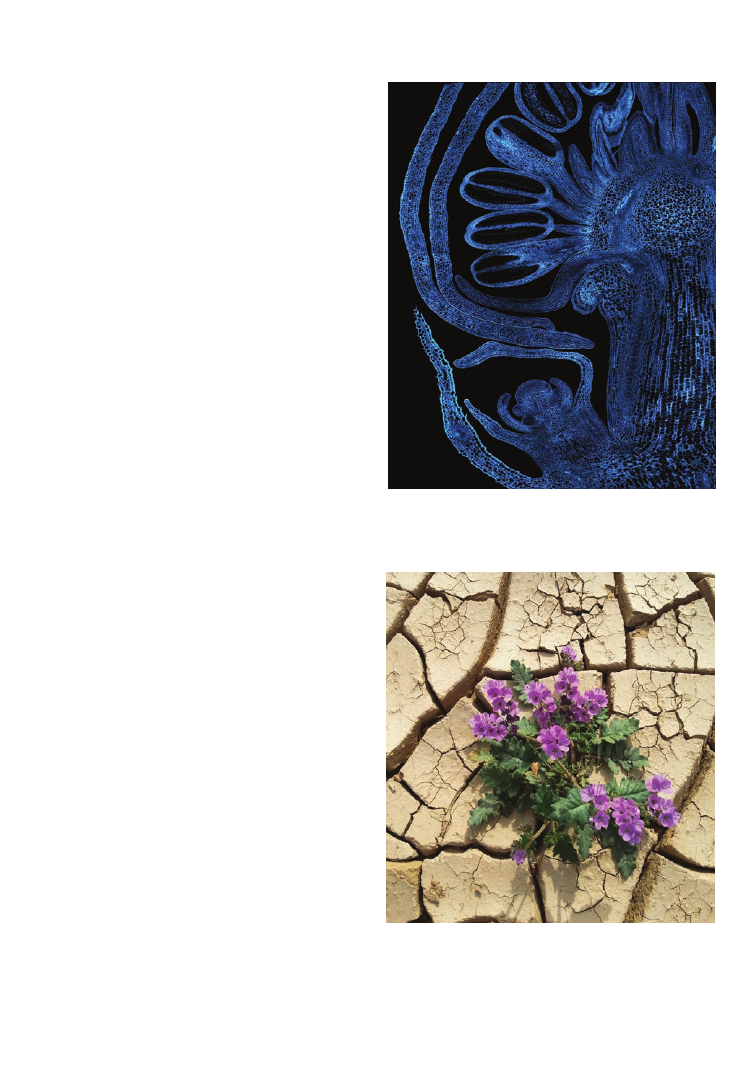
PSB 64 (2) 2018
80
SECOND PLACE
Ya Min
Harvard University
“Floral Morphogenesis”
Plants generate new organs continuously
throughout their entire life spans. Floral
organs are made from a group of stem cells
located in the floral meristems, and new floral
meristems are produces by the flanks of flower-
subtending leaves (bracts). Because plant cells
are bounded by cell walls, we can trace back
every cell division that have occurred during
the process of making a flower from a floral
meristem.
THIRD PLACE
Iona Anghel
University of California-Los Angeles
“Extreme Living”
This image was captured in Death Valley
after a wet winter in the desert in 2016. This
Phacelia species was thriving in the clay pans
of the valley flats. Its presence in this rough
environment highlights the resilience of plant
life, illustrating this species’ ability to grow
quickly before the water dries out in the heat of
the desert spring, as well as its ability to develop
roots through a very dense soil substrate. The
fact that it has reached reproductive maturity
is a testament to its successful adaptation in
this ecology.
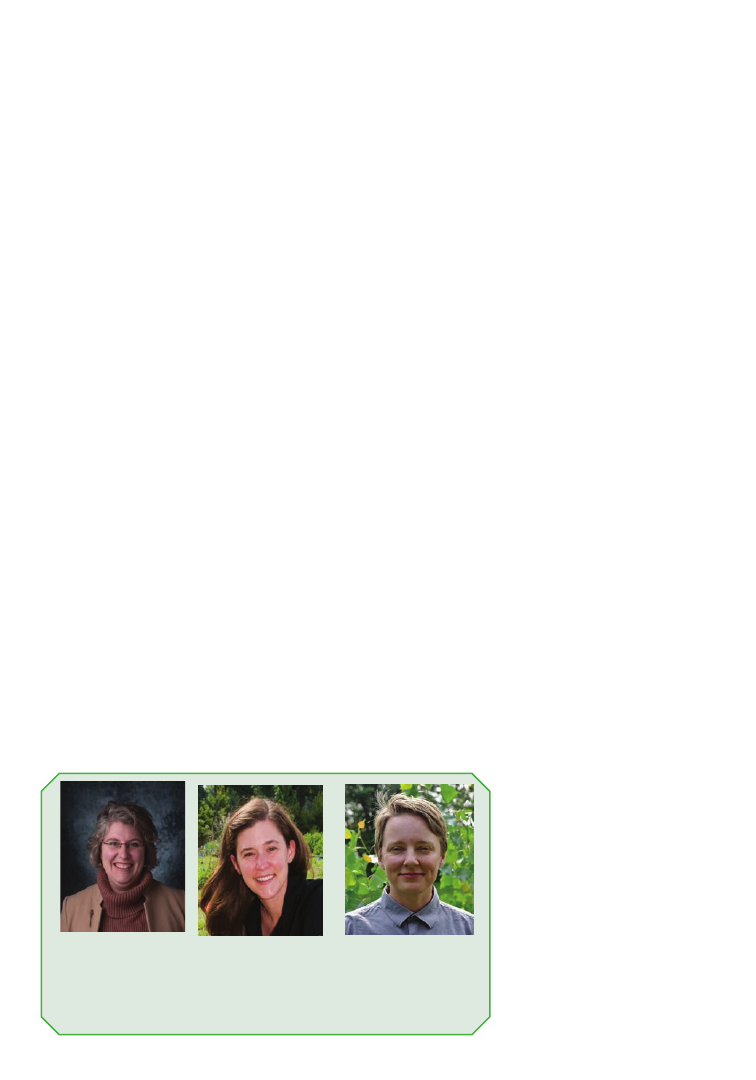
PSB 64 (2) 2018
81
Public Policy News
By Ingrid Jordon-Thaden (University of California Berkeley),
ASPT EPPC Chair, Krissa Skogen (Chicago Botanic Garden),
and Kal Tuominen (Metropolitan State University), BSA PPC
Co-Chairs
The BSA Public Policy Committee is pleased
to announce the 2018 Public Policy Award
recipients: Tanisha Williams from the
University of Connecticut and Timothy
Batz from California State Polytechnic
University, Pomona. In addition, the
ASPT Environmental and Public Policy
Committee awarded a Congressional Visits
Day Travel Award to ASPT member Naomi
Fraga of the Rancho Santa Ana Botanical
Garden. These awards cover travel expenses
for Congressional Visits Day, an annual
AIBS-sponsored event in Washington, D.C.
involving science advocacy training and a
day on Capitol Hill meeting with legislators
and staff. This year, a Communications Boot
Camp for Scientists was also offered as an
optional training. Williams, Batz, and Fraga
share their experiences below.
The BSA PPC has granted two Public Policy
Awards annually since 2013, and the ASPT
EPPC has granted one award annually since
2016. Application guidelines are provided on
the awards pages of the BSA (botany.
2018 Engaging Policy Makers:
BSA Member Involvement and Opportunities
org) and ASPT (https://aspt.net/) websites,
with the next deadline in January 2019.
If you would like to explore the many ways
in which botanists connect their science
to policy before then, please join us at the
BOTANY 2018 workshop, “Using our Science
to Inform Public Policy,” on Sunday, July 22.
We will introduce participants to the shared
work of the BSA PPC and ASPT EPPC, hold a
panel discussion with scientists working at the
intersection of science and public policy, and
run breakout groups to help attendees learn
new skills. This is a great opportunity for
botanists at all career stages to connect with
those involved in science policy and discover
potential entry points to this exciting area of
work!
Timothy Batz’s Experience
The field of botany has profoundly affected
our lives. Countless scientists have toiled
to understand the plant kingdom, from the
tallest tree to the smallest cell. Discoveries
from the plant world have
benefitted us with reliable
harvests, clothing materials,
and medicines—not to
mention the appealing parks
and gardens we all enjoy.
Despite our reliance on these
organisms, most people take
plants, and the science that
studies them, for granted.
This indifference of the
general public and politicians
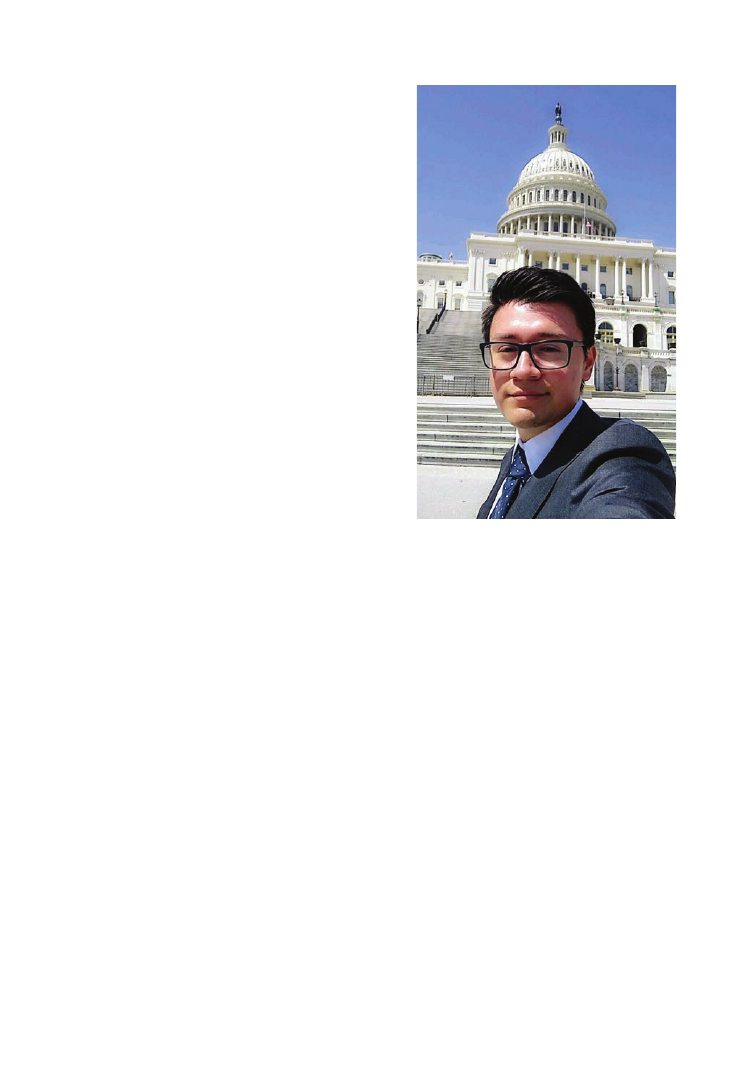
PSB 64 (2) 2018
82
must change. A warming planet coupled with
unprecedented population growth threatens
to greatly impact our lives and the planet itself.
Plants will play a large role in how we adapt
as a society to increasing demands for food
and fuel. Conversely, plants will also need
our help in diminishing the harmful effects
our lifestyles have on their environment. We
need scientifically informed policy to face the
challenges that affect us and the world. For
this reason, I applied for the Public Policy
Award to represent the Botanical Society of
America in Washington DC.
I traveled to the Capitol with fellow botanist
Tanisha Williams to meet with other scientists
interested in promoting scientific investments
to our representatives. Our fields were diverse,
from immunology to ecology and chemistry,
but we all had the common bonds of NSF and
NIH funding. I was surprised to learn that
scientists, like almost every other organization
of people, must lobby to representatives to
voice their concerns directly. Like most of
the other scientists who gathered for this
lobbying event, I had no previous experience
in government. To better prepare ourselves for
this meeting opportunity, we underwent a two-
day communication boot camp led by Dr. Rob
Gropp of the American Institute of Biological
Sciences (AIBS), a non-profit association
dedicated to public policy, education, and
public understanding of science.
After a briefing on the current state of
federal funding as well as communication
techniques highlighting the economic and
societal benefits of science, we engaged in
exercises of radio and television interviews
to practice condensing technical language
into relatable stories for journalists and the
public. After the second day, we had greater
confidence in our ability to reach the ears of
voters and policy makers alike. However, our
objective still seemed daunting. Congress
holds the purse strings to the U.S. Treasury,
and the time had come to appropriate funding
decisions to federal agencies and departments.
Unfortunately, the current administration had
proposed deep cuts to science-based agencies,
including a 20% cut to NOAA and 24% cut
to the EPA. The White House also planned
to rescind science funding allocations for the
2018 fiscal year. Our goal was to ask Congress
to maintain a stable funding level of $8.45
billion (<1% of the $1.2 trillion federal budget)
for the upcoming 2019 fiscal year.
We divided into regional teams to promote
our national scientific effort to as many
representatives as possible. My group
included botanist Naomi Fraga, Ph.D.
student Jo Bairzin, conservationist Dana
Batz in front of the U.S. Capitol during Con-
gressional Visits Day.

PSB 64 (2) 2018
83
Green, and Jeff Brown and Faerthen Felix of
the UC Berkeley Sagehen Field Station. Our
schedule was full of meetings with our district
and state representatives. Being a majority
Democratic state, our plea for science funding
was heard by most congressional staff we
met, especially California Senators Kamala
Harris and Dianne Feinstein. Meeting
the staff of California Republican Doug
LaMalfa offered an opportunity to expand
our discussion beyond usual supporters. I
stressed the importance of NSF funding in
plant biology research that safeguards grape
and rice crops grown in his district against
disease and pests. Jeff and Faerthen promoted
their science to solutions approach in forest
management by emphasizing the economic
benefit of utilizing thinned unwanted trees for
an emerging timber market in the district. We
can only hope that our ten-minute meetings
with staff were summarized and taken into
consideration when the time comes to vote on
appropriations.
Many of us apply to and
utilize federal grants
to conduct important
research, but the data
produced and tested by
those funds often fail to
influence the decisions
of elected officials. The
public image of a lone
scientist working in the
lab requires reinvention.
By experiencing how our government works
in Washington, I realize the need for scientific
literacy in our legislature, especially on matters
of funding and policy. Many of us apply to and
utilize federal grants to conduct important
research, but the data produced and tested
by those funds often fail to influence the
decisions of elected officials. The public image
of a lone scientist working in the lab requires
reinvention. More of us need to communicate
to policy makers and the public at large about
our work if we truly want to make changing
impacts. Scientific literacy should not be
restricted to academic journals and conference
meetings. It is our responsibility to translate
technical language into effective conversation
that is reachable by everyone, from our next-
door neighbors to the President of the United
States. The consequences of ignoring this fact
have repercussions in our environment and
at the voting booth. I would like to thank the
members of the BSA Public Policy Committee
for this incredible opportunity and encourage
readers to participate in the AIBS (https://
www.aibs.org/home/index.html).
Tanisha Williams’s
Experience
I grew up in Washington, DC, and I was bitten
by the policy bug long ago. I have always been
interested in how science influences public
policy, and I have sought opportunities that
would help me communicate effectively with
policy makers. What an honor it was to be
recognized by the Society through the Public
Policy Award!
My first two days in DC were spent at the
offices of the American Institute of Biological
Sciences (AIBS) where I met other graduate
students, postdocs, and field station scientists
seeking to learn more about the role of scientists
in policy and effective communication. Our
communications training included topics like
the curse of knowledge (forgetting that your
audience does not understand the details that
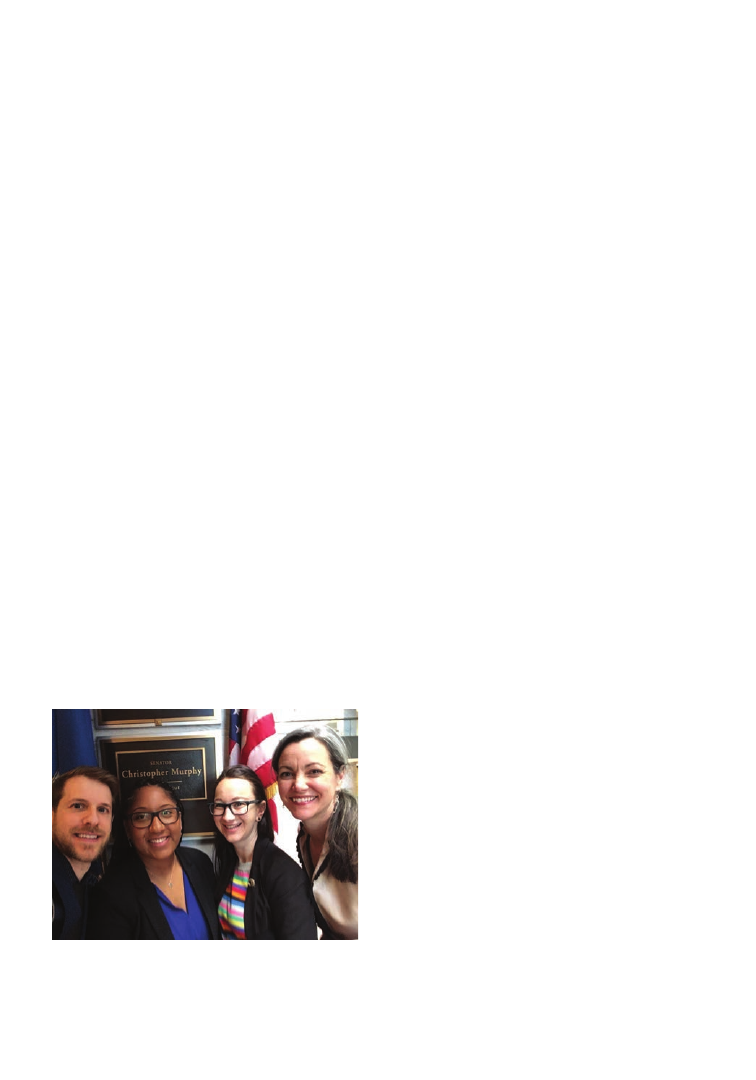
PSB 64 (2) 2018
84
fascinate you, which requires that you tailor
your message to make it easily understood),
crafting stories and elevator pitches, and
media 101 (understanding the diverse types
and roles of media). We also participated in
mock interviews. The trainings demonstrated
that being an effective communicator is not
only important for science policy, but also as
a life skill.
With our trainings complete and elevator
pitches refined, we spent a half day preparing
for the congressional visits. We received
insights on what science policy is, an overview
of the federal budget, and lessons on how to talk
to lawmakers. We also participated in mock
congressional meetings. Once the trainings
were done, we separated into regional teams
to further refine our collective pitches. My
team decided that each scientist would take
the lead for their home state or district, which
meant the leader would introduce the group
and share state- or district-specific support
stories. I was the lead for three congressional
meetings! We were also given talking points
that highlighted the importance of select
Representatives and Senators who voted to
oppose deep cuts to science funding proposed
by Trump’s FY 2018 budget. Besides thanking
the Senators and Representatives for their
service, we also made an ask for FY 2019: We
asked that Congress fund the National Science
Foundation (NSF) at $8.45 billion, which is
needed to continue to fund non-medical basic
research at all academic levels.
On the third day I met with the Connecticut/
New York team in the Longworth House
building to review our message before
our busy day on the hill. We met first with
Representative Faso (R - NY) and one of his
staff members to discuss the importance of
funding science agencies like NSF to support
innovation, education, outreach, and keeping
ahead of the global market. We also met
staff members from the offices of Senator
Kirsten Gillibrand (D - NY), Senator Richard
Blumenthal (D - CT), Senator Chris Murphy
(D - CT), Senator Charles Schumer (D -
NY), Representative John Katko (R - NY),
and Representative Adriano Espaillat (D -
NY). Representative Joe Courtney (D - CT)
welcomed us to his office before attending
another meeting, and we continued our
meeting with one of his staff members. During
each of our eight meetings, I shared exciting
facts about my research and how NSF made
it possible for me to do what I love in science,
international (science) diplomacy, education,
and outreach. I also stressed how important
funding from NSF is to all levels of education
and research through offering stories about
how my home institution, the University
of Connecticut, is using NSF funding to
promote science research and education
through a state-of-the-art collections facility
and teaching greenhouses managed by my
department, Ecology and Evolutionary
Biology. Lastly, I stressed the importance of
such funding to my department, focusing on
how NSF provides undergraduates, graduates,
postdocs, and faculty resources to conduct
Matthew J. Rubin, Williams, Elizabeth Car-
len, and Dr. Elizabeth Long in front of Sen-
ator Chris Murphy’s (CT - D) office.
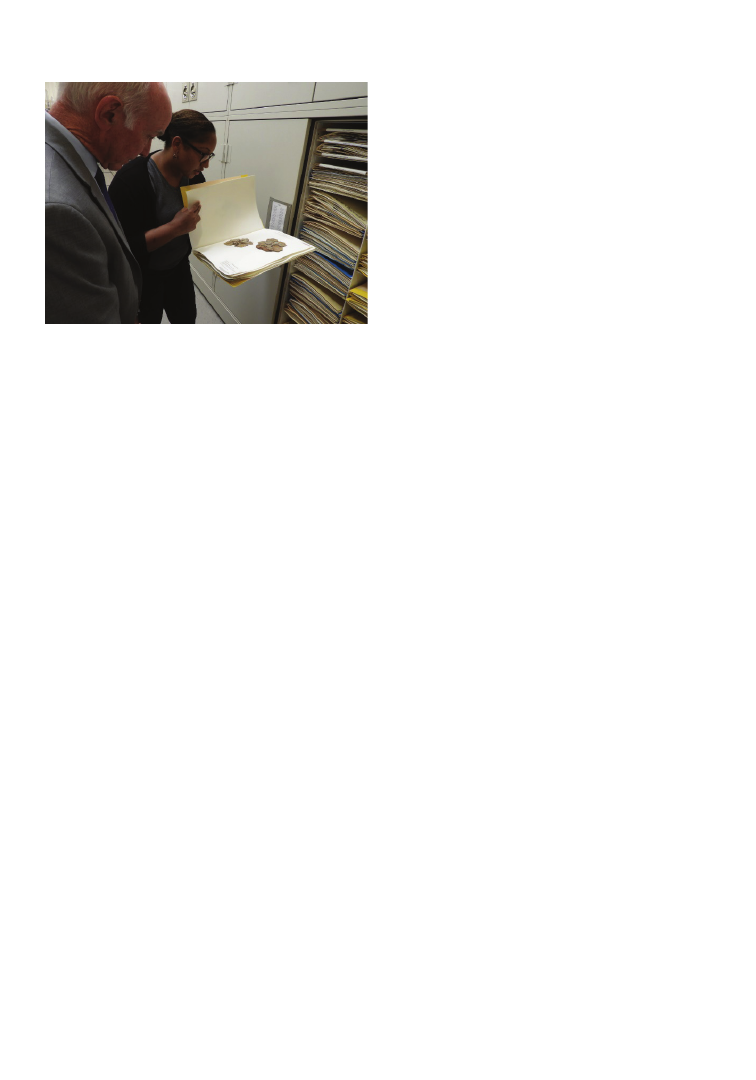
PSB 64 (2) 2018
85
cutting-edge research, both locally and
globally. Most offices were quite supportive of
science and research funding. Their eagerness
showed in their questions about specific NSF
programs that promote science discovery or
diversity, and in their desire to hear tangible
examples that show how important funding
the NSF is to science research and education.
Prior to my trip, I had heard that developing
a relationship with your Representative or
Senator is mostly a matter of continually
showing up and reaching out. It is like the
saying goes, the squeaky wheel gets the oil.
Being active by holding meetings to not
only discuss what issues you are concerned
about, but also thanking your policymaker
for their service helps build a relationship.
It sounds easy, but I did not believe that one
person could build this connection, let alone
a graduate student. Yet only two weeks after
my visit, Congressman Courtney’s office
contacted me and scheduled a visit to my
department of Ecology and Evolutionary
Biology at the University of Connecticut! I
was stunned and delighted that Congressman
Courtney and his staff member remembered
me and wanted to see where I work. It
was a whirlwind tour of my department’s
greenhouses, where Representative Courtney
learned about a few extinct to the wild species
that we have at our facilities, the NSF-funded
collections facility, how I use herbarium
samples to understand the effects of climate
change, and meeting graduate students from
my department. I was amazed how easy it
was to talk with Representative Courtney
and his staff members, and I was delighted
to see how interested they were in learning
more about what my department is doing
and how NSF funds many of our research and
teaching programs. This visit was an amazing
opportunity to start a partnership with
Representative Courtney and his office that
started with BSA! I am truly grateful for the
opportunity to participate in the Congressional
Visits Day, and I thank BSA for providing the
support! I look forward to staying involved
with AIBS and BSA’s Public Policy Committee.
Naomi Fraga’s Experience
As Director of Plant Conservation Programs
at Rancho Santa Ana Botanic Garden in
Claremont, California, I oversee a diverse
program focused on plant conservation. I am
privileged to engage in a spectrum of botanical
work that both spans and links “pure” scientific
research to on-the-ground conservation
efforts. At the center of my work is my desire to
increase the understanding, appreciation, and
conservation of plant diversity. Therefore, I
was incredibly excited to receive the American
Society of Plant Taxonomists (ASPT) travel
grant to participate in Congressional Visits
Day (CVD) hosted by American Institute
for Biological Sciences (AIBS). The event
provided me an opportunity to advance my
goals of being an effective advocate working
on behalf of plant conservation and allowed
me to hone my communication skills toward
Williams explaining to Rep. Joe Courtney how
she used herbarium samples to understand the
effects of climate change on flowering phenolo-
gy within the genus Pelargonium.

PSB 64 (2) 2018
86
increasing my effectiveness as a plant scientist
and conservationist.
Prior to the CVD event I took part in a two-
day science communications training where
I worked on developing my talking points
to prepare for meetings with congressional
staffers. Our goal was to advocate for
the importance of federal funding in the
biological sciences and provide information
on how federal funding is important to our
research. I was also particularly interested in
discussing important policy issues facing plant
conservation in my home state of California.
When I arrived at the training, I was
pleasantly surprised to meet a fellow southern
Californian and plant advocate, Tim Batz from
Cal Poly Pomona (my undergraduate alma
mater). Tim and I had a lot of overlapping
experience and interest, including advocating
for initiatives that increase representation of
underserved groups in STEM fields. On the
actual Congressional Visits Day we had a full
day of meetings set up with congressional
staffers, and I got to work with Tim and an
excellent team of scientists from Arizona and
California.
I was able to start off CVD with a constituent
breakfast hosted by my California State
Senator, Diane Feinstein, who I found to
be incredibly inspirational. Our team had
several meetings scheduled throughout the
day, so we had our work cut out for us! On
CVD I was able to meet with the Legislative
Director for Norma Torres, the representative
for my home congressional district, and staff
from the offices of Diane Feinstein, Kamala
Harris, and John McCain. In addition, we
met with staffers that represent other districts
in California. Overall I found the day to be
very enjoyable and inspirational. I left the
event feeling encouraged and motivated to
stay in contact with my legislators. I came
to better understand the effect that we can
have on policy and budgetary decisions,
both individually and collectively. I would
encourage others to get in contact with their
I came to better
understand the effect
that we can have on policy
and budgetary decisions,
both individually and
collectively. I would
encourage others to
get in contact with their
legislators and possibly
set up a meeting.
legislators and possibly set up a meeting; I
personally found it to be a very empowering
experience. The training combined with CVD
was incredibly educational, and I am very
thankful to have had the experience!

PSB 64 (2) 2018
87
When the month of May rolls around, the
season of professional conferences begins in
earnest for many of us. For your friends in
the BSA Publications office, that often means
attending the annual meetings of the Council
of Science Editors (CSE) and the Society for
Scholarly Publishing (SSP), among others.
This year in early May, Beth Parada and I
attended the CSE meeting in New Orleans,
which had the theme “Publishing in the
Changing Climate of the Research Ecosystem.”
In late May Richard Hund and I went to the
SSP meeting in Chicago, the theme of which
was “Scholarly Publishing at the Crossroads:
What’s working, what’s holding us back, where
do we go from here?”
Every year these two meetings bring together
hundreds of professionals who work in
scholarly publishing—editors and publishers
of scholarly journals and books; commercial
and not-for-profit service providers;
commercial publishers; consultants;
librarians; and others involved or interested
in these endeavors.
Your BSA Ed. folks return from these meetings
energized and woke on new and old issues. We
Publishing at a Crossroads in a
Changing Climate
By Amy McPherson
Director of Publications
of Managing Editor
Botanical Society of
America
ORCID 0000-0001-7904-242X
assume that our authors, reviewers, editors,
and readers and aware of and concerned about
similar issues. Is it true? Are these issues you
are thinking about, too? If not, what are
you
thinking about? Let us know!
Artificial Intelligence and Machine
Learning: These were huge, and provocative,
topics at this year’s conferences. If published
research cannot be read by a machine, it is
virtually undiscoverable. On a practical level,
that is why we are concerned about properly
applied metadata, JATS and BITS XML
structure, proper tagging and formatting of
literature references (machines are counting
citations), persistent identifiers (e.g., ORCid),
among other things, in the context of data and
text mining.
AI is also being used to curate what we see
when searching the internet, and it is being
used by publishers to source new content,
inform and improve content, and suggest
new product development. Algorithms may
review scientific papers more efficiently than
humans. More than once we were told that
for the first time, in 2018, a machine is able to
answer questions more quickly and accurately
than a human. The session “(Don’t) Rage
Against the Machine” highlighted incredible
advances that are being made in technology in
the name of progress, but I left thinking that
we need to be careful. AI is only as good as
the information it receives, so it needs ALL
the information—and who decides how the
machines process it?

PSB 64 (2) 2018
88
Inherent Biases in Digital Technology, and
the Importance of Diversity and Inclusion:
Related to advances in AI and machine
learning, we learned about implicit biases built
into digital technologies. When you search on
Google, are you aware of what informs the
algorithms that bring up the most “relevant”
content? Algorithms are written by people,
and according to Safiya Umoja Noble, in her
excellent SSP keynote and recently published
book (Noble, 2018), they are shaped by and
infused with values that are not impartial or
lacking a position. Not every person or every
work is treated fairly
, and what is even meant
by “fair”? Noble challenged all people in
publishing and academia to address the biases
inherent in the tools we use, the work we
produce, and the decisions we make. (See also
Courtland, 2018, for a fascinating discussion
of the topic.)
Communicating science in a “post-truth”
world: Of course, we are not really living in
a totally Orwellian “post-truth” world (not
yet!), but I think most of us know that we need
to engage the larger community to be less
intimidated by science and to think openly
and critically about what we read and hear
about the world around us.
If we need an example of someone who has
really “gone to the mat” for communicating
science, we just need to look at Michael Mann,
climatologist, professor, and author of many
books, including The Hockey Stick and the
Climate Wars (Mann, 2013). At considerable
personal cost, he is striving to “cut through the
fog of disinformation that has been generated
by the campaign to deny the reality of climate
change”—and we are called to stand up and
do our part, in whatever area of science we’re
in. And we might need to learn effective
ways to engage the broader community.
Steve Mirsky, author of the “AntiGravity”
column in Scientific American and host of the
60-Second
Science podcast, shared ideas for
communicating science that have worked for
him—humor and persuasion. Chris Martine’s
YouTube series “Plants Are Cool Too!” came
to mind for me.
This is meant to be a brief essay, so I am not
going to elaborate on other Big Issues we
learned about—but if any of these, or anything
else, are of interest to you, please let me know
and we can chat at Botany 2018 or we can
explore in a future essay.
Data sharing and accessibility policies: FAIR
data principles, i.e., making sure that data
are Findable, Accessible, Interoperable, and
Reusable (see Force11).
Peer Review: Which system is the best, and why?
Preprint Servers: Is everyone on board—
why or why not? How do they fit in with the
research ecosystem and what comes next?
REFERENCES
Council of Science Editors, https://www.council-
scienceeditors.org/
Courtland, R. 2018. Bias detectives: the research-
ers striving to make alorithms fair. Nature 558:
357-360. doi: 10.1038/d41586-018-05469-3
Force11: The Future of Research Communica-
tions and e-Scholarship. [Website] https://www.
force11.org/about
Mann, M. 2013 [Paperback edition]. The Hockey
Stick and the Climate Wars: Dispatches from the
front lines. Columbia University Press, New York.
Noble, S. U. 2018. Algorithms of Oppression:
How search engines reinforce racism. NYU Press,
New York.
Society for Scholarly Publishers, https://www.
sspnet.org/
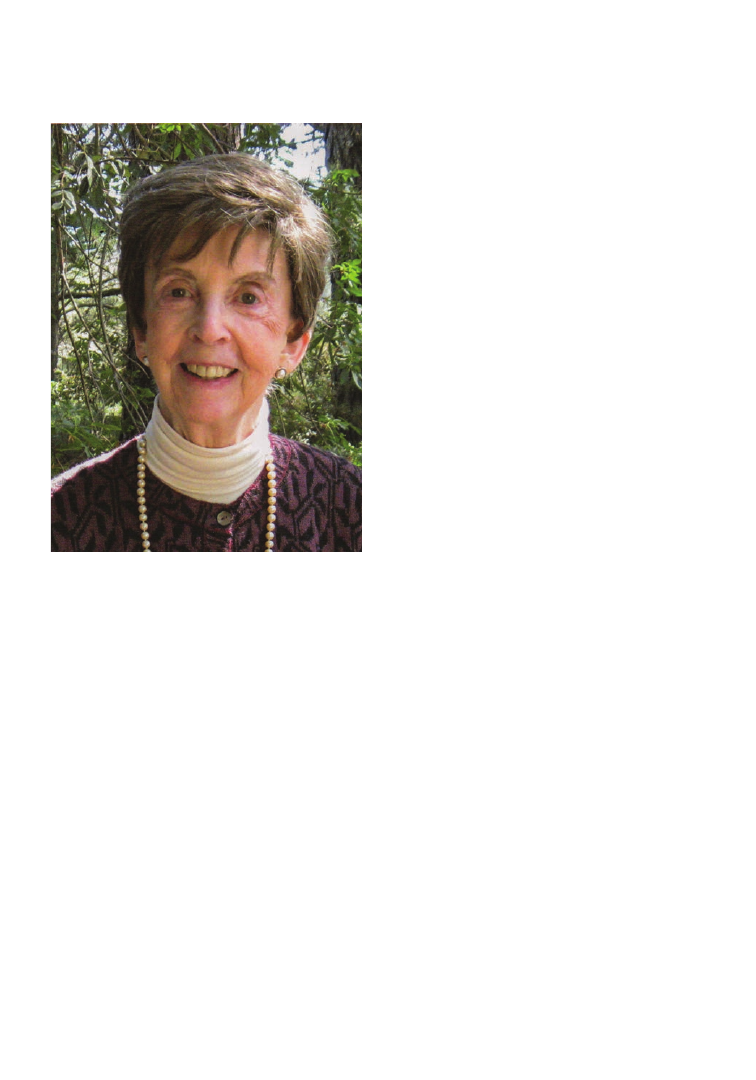
PSB 64 (2) 2018
89
Barbara D. Webster
(1929-2017)
Barbara D. Webster, Professor Emerita in the
Department of Plant Sciences, University
of California, Davis, died September 7,
2017, in Davis, at the age of 88. Born and
raised in the Boston area, Barbara earned
a B. S. in botany from the University of
Massachusetts, Amherst; an M. A. in
biology from Smith College; and a Ph.D. in
biology from Harvard University. An NSF
Postdoctoral Fellowship and a new spouse
took her to Purdue University, where her
career-long research into abscission began in
the laboratory of Prof. A. Carl Leopold. The
scope of Barbara’s research extended from
her Ph.D. research on morphogenesis in
bracken fern to include reproductive biology
and pollination mechanisms in legumes,
effective and ineffective nitrogen fixation in
legumes, environmental stresses in relation to
morphogenesis and yield of crop plants, and,
always, abscission and senescence in higher
plants. Her research approaches combined
anatomy, morphology, ultrastructure, and
physiology.
Barbara arrived in Davis, CA in 1966 without
a job but with a major NSF grant in hand. Her
husband, Grady L. Webster, had been hired as
a full professor in the Department of Botany
at UC Davis. In the early months in Davis,
Barbara was, as she put it, “underemployed”
as a lab technician. In 1967, she was hired as a
Lecturer and Assistant Research Morphologist,
split between the Department of Agronomy
and Range Science and the Department of
Vegetable Crops (now combined into Plant
Sciences). Over the next 12 years, Barbara
held part- and full-time positions, sometimes
paid in soft money and sometimes in hard
money. She pursued research on leaf and
pod abscission in common beans, and
flower, fruit, and seed development in other
crop plants. During her career, she received
research grants from the USDA, USAID, NSF,
and California Dry Bean Advisory Board, and
she and her students and other collaborators
published their work in prominent national
and international botanical and horticultural
journals. Barbara supervised graduate
student research, mentored undergraduates,
and, at intervals, taught an upper division
undergraduate course in crop morphology.
In 1979, Barbara’s appointment was converted
to Professor of Agronomy and Agronomist
in the Agricultural Experiment Station, with
tenure.
Once officially on the faculty at UC Davis,
Barbara trained additional graduate students
In Memoriam

PSB 64 (2) 2018
90
and postdocs, often women and minorities,
and sought out leadership and administrative
opportunities. She served as the Associate
Vice-Chancellor for research from 1989-1992
and before that, as Associate Dean, Division
of Biological Sciences (1981-1982). She served
on and chaired numerous panels, boards,
and committees for the National Science
Foundation, National Research Council,
USDA, Associated Western Universities, W.
K. Kellogg Foundation-Grants, and National
Center for Atmospheric Research. She was
a Senior Fulbright Research Fellow at the
University of Nairobi, Kenya. Barbara was
the first woman elected as Treasurer of the
Botanical Society of America (1977-1981)
and later served as President (1983). She was
a distinguished fellow of the Botanical Society
of America (2008), and a fellow of the AAAS
and the American Society for Horticultural
Science; she received the university medal
from Universidad San Francisco de Quito
(Ecuador), and was a Visiting Scholar,
People’s Republic of China. Locally, Barbara
served as chair of the City of Davis Planning
Commission, Board of Zoning Adjustment
and co-chair of the grants committee of the
Davis Regional Science Center.
For obvious reasons, Barbara had a long-
standing interest in creating and improving
opportunities in academia for women and
other under-represented groups. She was a
frequent contributor to faculty development
workshops for new and junior faculty at
UCD, always emphasizing the importance
of understanding the academic system, of
understanding expectations for professional
advancement, of choosing a mentor, and of
choosing one’s battles (Webster, 1989). She
was a strong advocate for women in science,
particularly women graduate students, and
a vigorous proponent of support networks
and interest groups to enhance collegiality
and share information about resources and
strategies for a successful career in academia.
In the late 1980s and early 1990s, Barbara
also traveled to academic institutions across
the country, where she gave talks on the
challenges for women in the sciences in
general and academia in particular. She was
active in the UCD Women’s Resources and
Research Center Network and a co-founder
of the Faculty Women’s Research Support
Group, in which colleagues met regularly
to provide direction to new women faculty
and to encourage the appropriate balance of
research, teaching, and service to be successful
in the promotion and tenure process.
Barbara retired from UC Davis in December
1992, staying active in the UC Davis Emeriti
Association, the Davis Branch of the League of
Women Voters, and several book groups. She
is survived by her daughter, Susan V. Webster,
the Jane Williams Mahoney Professor of
Art History and American Studies at The
College of William and Mary; her son-in-
law Hernán Navarrete; her sister Dorothy
Sears and brother William Donahue; and
numerous nieces, nephews, grandnieces and
grandnephews. Her brother Robert Donahue
preceded her in death. Grady pre-deceased
her in 2005. In 2006, Barbara and Susan
established the Grady L. Webster Award of
the Botanical Society of America and of the
American Society of Plant Taxonomists in his
honor. The Grady L. Webster Memorial Fund
also was created in 2006 to support research
in the Department of Plant Sciences at UC
Davis. A celebration of Barbara’s life was held
in June, 2018, in the UCD Arboretum.
-Judy Jernstedt, University of California, Davis
LITERATURE CITED
Webster, B. D. 1989. Opening doors for women
in academia. BioScience 39(2): 96-98.
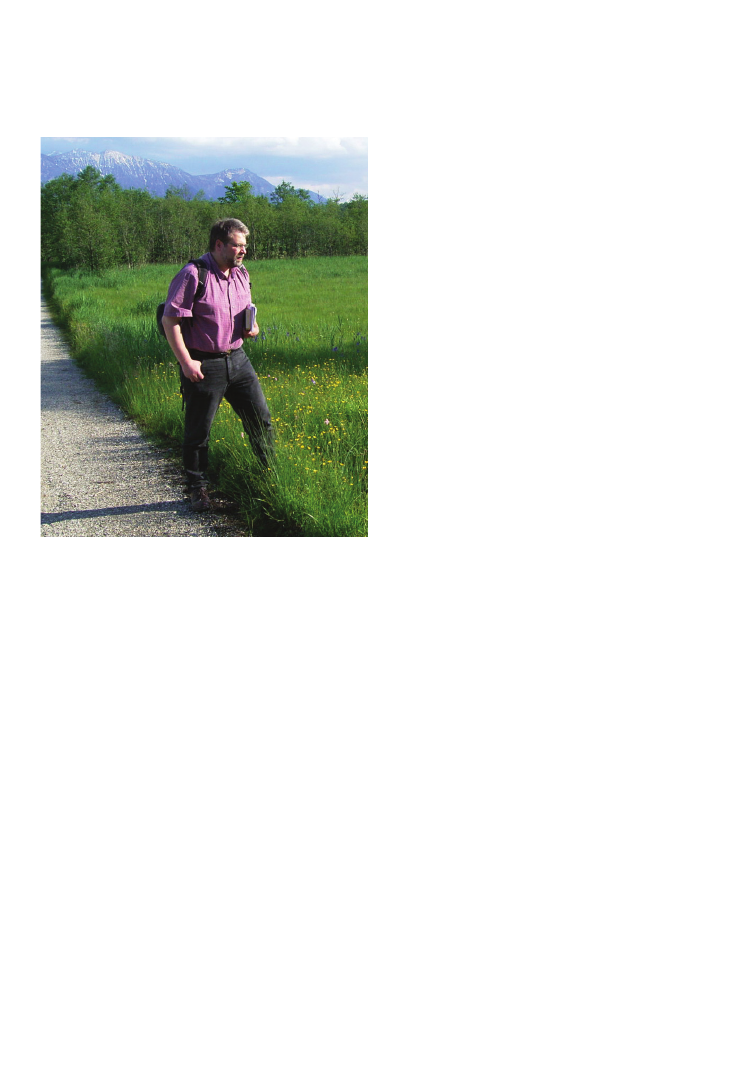
PSB 64 (2) 2018
91
Jochen Heinrichs
(1969-2018)
Jochen Heinrichs, a professor on the faculty of
biology at the University of Munich, Germany,
passed away on April 22, 2018, following
a long battle with an autoimmune disease.
Jochen was born in 1969 in Mönchengladbach
near Düsseldorf and early on developed an
interest in botany and especially bryology. He
earned a master’s degree at the University of
Düsseldorf (1989–1996), with a thesis on the
systematics of a genus of mosses, and then
moved to the University at Göttingen for
his doctoral research under the supervision
of Robbert Gradstein. His thesis, in 2002,
consisted of a taxonomic revision of three
sections of Plagiochila. Still in Göttingen,
Jochen obtained his habilitation (2007)
while working as a curator of the Göttingen
University Herbarium (2001-2012). He
reorganized the collection and initiated the
establishment of a digital herbarium, which he
supervised until he left Göttingen for Munich
in 2013 to assume the position of professor for
Molecular Systematics of Lower Plants at the
Ludwig-Maximilians-University.
Jochen loved field work and participated in
expeditions to Bolivia (1997), Costa Rica
(1999), and Ecuador (2004), during which
he focused mostly on liverworts. Many of
his specimens of liverworts, bryophytes,
and flowering plants have gone to the two
(intercalated) herbaria in Munich, M and
MSB. In spite of his comparatively young age,
Jochen published more than 200 research
articles (see Bibliography in Krings et al.,
2018), with his most influential contributions
addressing the taxonomy of Plagiochila
and liverwort systematics and taxonomy in
general. Jochen was awarded the Sullivant
Award of the American Bryological and
Lichenological Society for the best paper
published in The Bryologist in 2005. By about
2008, Jochen became increasingly interested
in, and fascinated by, fossil bryophytes,
especially the copious record of these plants
in amber, which naturally led to an interest
in the calibration of ‘molecular clock’ and
reconstructions of trait evolution and
geographic range change. Jochen’s research on
amber fossils resulted in more than 40 papers
on liverworts and mosses, as well as ferns,
fungi, and lichens, all beautifully illustrated,
usually with color photos of the fossils. One of
the last manuscripts Jochen was working on
was “A comprehensive assessment of the fossil
record of liverworts in amber,” an invited
contribution to the commemorative volume
In Memoriam

PSB 64 (2) 2018
92
for the late Thomas N. Taylor (1937–2016;
Krings et al., 2018).
Jochen loved teaching, and during his barely
six years at the University of Munich, he
mentored dozens of Bachelor students, several
M.Sc. students, and two Ph.D. students. His
seminars in our institute seminar series
were fresh and fascinating, whether one
cared about liverworts or not. Jochen served
as an editorial board member of several
scientific journal, Editor-in-Chief of the series
Bryophytorum Bibliotheca (since 2005),
and on the Committee for Bryophytes of the
International Association for Plant Taxonomy
(1999–2005).
As described in a fuller appreciation of his
many contributions (with a full list of his
publications; Krings et al., 2018), Jochen
was an outstanding scientist and passionate
person who will long be missed by his friends
and colleagues, not only across Germany but
throughout the world.
-
-Susanne S. Renner,
Systematic Botany and
Mycology, Department of Biology, University
of Munich (LMU), Menzinger Str. 67, 80638
Munich
LITERATURE CITED
Krings, M., Schneider, H., Bechteler, J., Feldberg,
K., Renner, S. S., Schäfer-Verwimp, A., and A.
R. Schmidt. Jochen Heinrichs: March 14, 1969–
April 22, 2018. Plant Systematics and Evolution
https://doi.org/10.1007/s00606-018-1521-4.
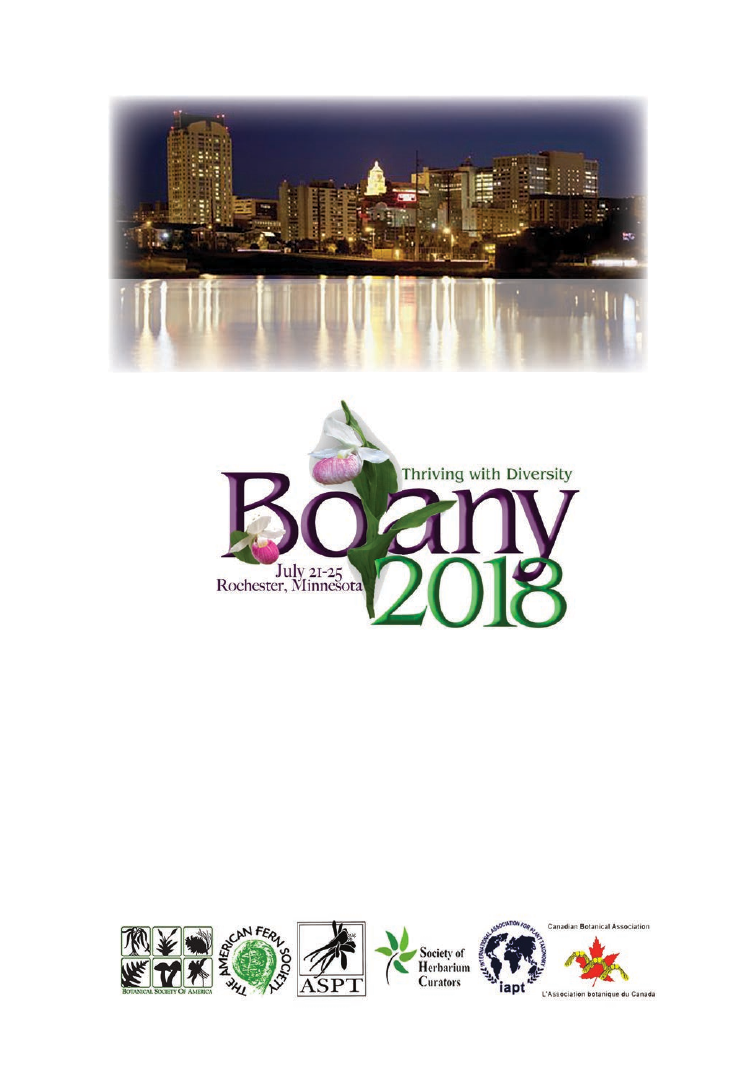
PSB 64 (2) 2018
93
Are you ready ?
Don't miss the best scientific conference of the summer!
Join us in the vibrant city of Rochester, Minnesota!
Timely Symposia and Colloquia
Informative Workshops
Spectacular Field Trips
Over 950 Oral and Poster presentations
Exhibits
Networking Events
Something for everyone!
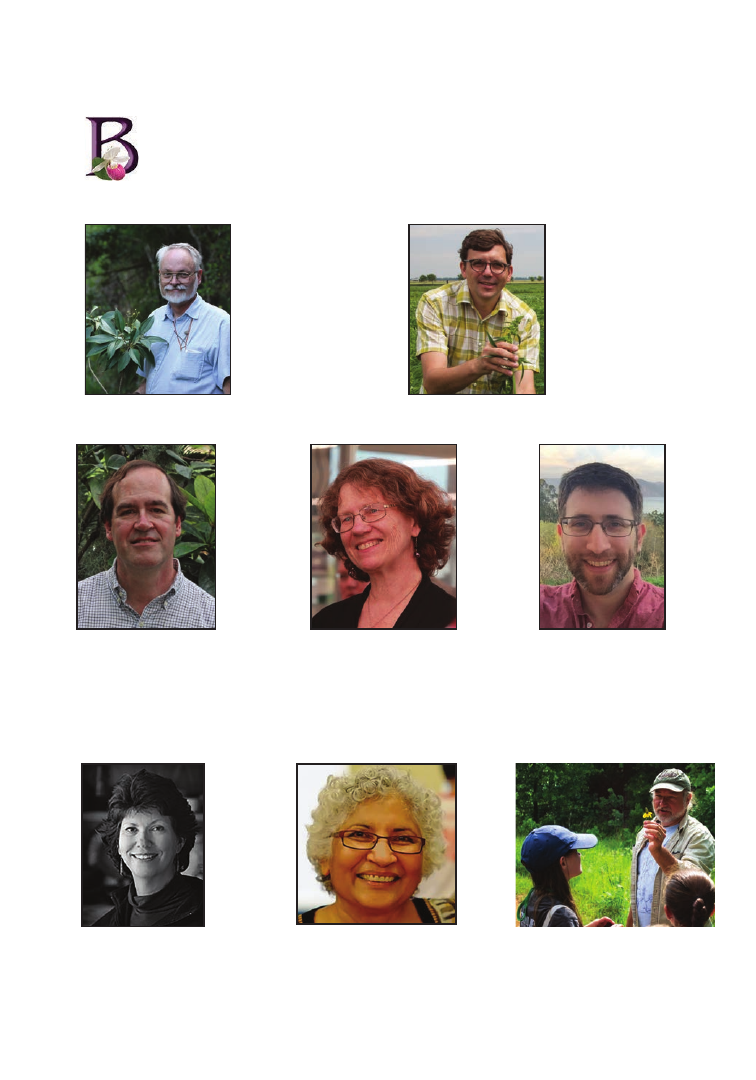
PSB 64 (2) 2018
94
Featured Speakers
Plenary Lecturer
Walter Judd
Flora of
J.R.R. Tolkien’s
Middle-Earth
Regional Botany
Special Lecture
George Weiblen
Annals of Botany
Lecture
Jeffrey Karron
Kaplan Memorial
Lecture
Toby Kellogg
.
Incoming BSA President
Lecture
Andi Wolfe
Pelton Award
Lecture
Neelima Sinha
Emerging Leader
Lecture
Benjamin Blackman
Incoming ASPT President
Lecture
Mark Fishbein
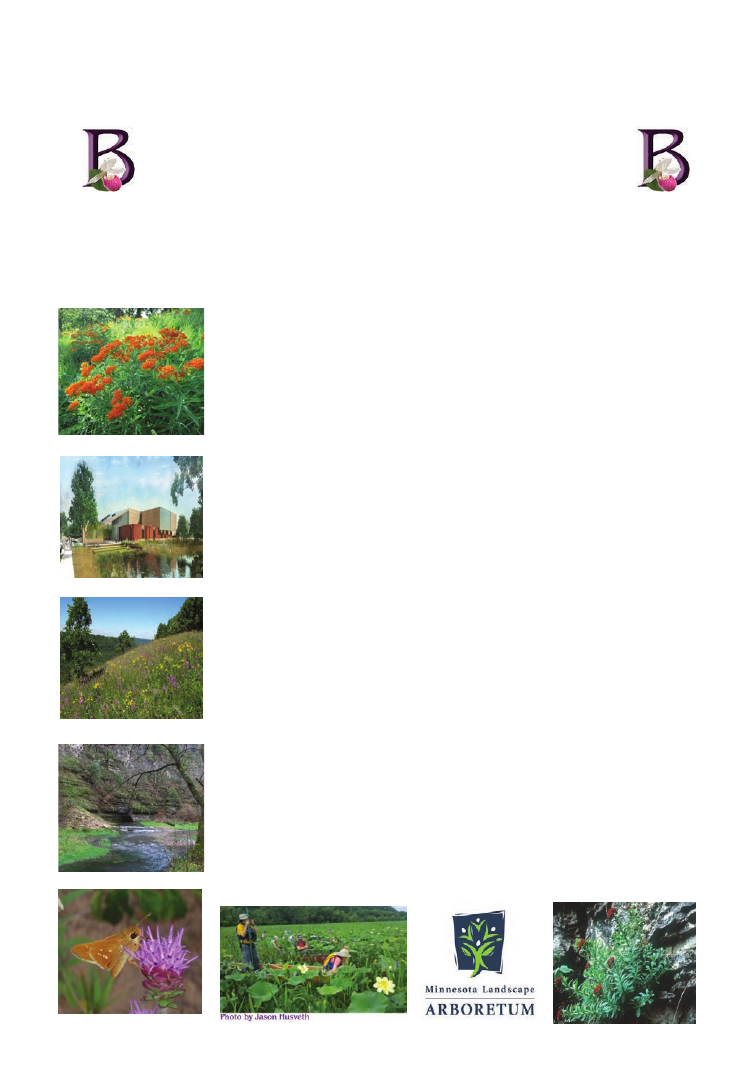
PSB 64 (2) 2018
95
Enhance your Conference experience
Sign up for a field trip and experience the
Botany of the Rochester area!
For complete information, descriptions, and fees, go to:
http://2018.botanyconference.org/field-trips.html
New this year!
Botanical Society of America will reimbuse any student member
up to $100.00 for field trip fees. Sign up early!
Reimbursements are first-come, first-served!
Information on the conference website
Friday Trips
• Join the Fern Foray - Do the overnight adventure or just come
for the day!
Saturday Trips
• Explore the Big Woods and go Kayaking - Check out the video
on the site!
• Visit the Cedar Creek EcosystemScience Reserve
• Collect and identify Sedges at the Whitewater Wildlife
Management Center
• Hike the Weaver Dunes Prairie - and then canoe the marsh
and look for the American Lotus!
• Check out the Glacial Relics and the fire-dependent Plant
communities
Sunday Trips
• Hike through Whitewater State Park
• Visit Mystery Cave State Park
• Walk through the Minnesota Landsape Arboretum and then
Prince's private estate - Paisley Park
• Discover the New Bell Museum, the MIN Herbarium and Surly
Brewing Company
Post-Conference Thursday Trips
• See the Karst bedrock and tour the Whitewater Valley
• Another chance to go Kayaking on the Cannon River

96
SPECIAL FEATURES
By Theresa Culley
Department of Biological Sciences, University of
Cincinnati, 614 Rieveschl Hall, Cincinnati, OH
45221-0006
E-mail: theresa.culley@uc.edu, Tel: 513-556-9705
Manuscript received 1 June 2018; revision accepted 19 June 2018.
Introduction
For researchers looking to publish their work,
there now exists a dizzying array of possible
outlets. Over the past decade, the publication
landscape has exploded from print-based,
subscription journals published by respected
scientific societies
and legitimate publishing
companies to an almost equal number of
disreputable, open-access journals backed
by for-profit companies (Beall, 2012, 2016b;
Shen and Björk, 2015; Beninger et al., 2016;
Laine and Winker, 2017). Known as predatory
journals (Beall, 2012), these journals charge
publication fees with promises of rapid
publication but often have a sham peer review
process, leading to low article quality (Beall,
2016a, b; Eriksson and Helgesson, 2017;
Shamseer et al., 2017). Consequently, these
journals are not accepted for indexing in major
bibliographic databases, like Web of Science or
How to Avoid Predatory Journals
When Publishing Your Work
Key Words
fake impact factor; open access; predatory
journal; predatory publisher.
Acknowledgements
The author thanks R. Hund, B. Parada, and A.
McPherson for their encouragement to write
this manuscript; they were also extremely
helpful in forwarding relevant articles and
blog postings on the subject. Thanks also to
T. Serota, D. Spooner, and two anonymous
reviewers for helpful comments and
suggestions on this manuscript.
PubMed. Many predatory journals purposely
dupe authors—especially young investigators
and academics from low-resource countries—
into submitting manuscripts with deceptive
advertising designed to resemble legitimate
scholarly journals (Beall, 2012, 2016a).

PSB 64 (2) 2018
97
In some cases, predatory publishers even
create counterfeit websites of respected
journals to deceitfully obtain manuscripts—
essentially “hijacking” the legitimate journals
(Tin et al., 2014; Beall, 2016a; Eriksson and
Helgesson, 2017; see https://predatoryjournals.
com/hijacked/). Many predatory publishers
state that they are located in the U.S., Canada,
Australia, and the U.K., but are actually in
other countries (Beall, 2012; Gasparyan et
al., 2015; Shamseer et al., 2017) where many
predatory journals originate. Predatory
publishers have even created sham “meetings”
and “conferences,” in which they divide up
ballrooms in a hotel in a popular tourist city
to hold multiple “conferences” together on the
same weekend, with limited staff and very few
attendees (Hunziker, 2017). In short, these
entities are scams targeting academic authors
for their own financial benefit (Anderson,
2017) and to “generate profits rather than
promote academic scholarship” (Stratford,
2012). Consequently, authors must carefully
navigate where to submit their papers for
scientific dissemination (Barroga, 2015;
Eriksson and Helgesson, 2017).
This proliferation of predatory journals can be
traced to a relatively recent shift in publication
models (Beninger et al., 2016), but the reality
is that anyone with a computer and internet
connection can create a “journal.” In the
past, traditionally printed journals were large
complex operations, financially supported by
personal and library subscriptions. Although
this ensured high quality of published articles,
one disadvantage was that readership was
potentially limited; non-subscribers could
only read articles if they personally paid for
the journal or had access to it through their
institution. The open access model reversed
this idea so that the published paper is
freely available to all readers, after authors
themselves pay the publication cost (typically
called an “article processing charge,” or APC).
Although the intent of the open access model
was honorable, it has now been exploited by
for-profit predatory journals focused solely
on increasing their own income by requiring
author fees (ranging from US$100 to several
thousand dollars) on as many articles as
possible without any concern for quality or
scientific rigor. Although not all open access
journals are predatory—many are indeed
legitimate—all predatory journals are open
access.
The extent of predatory journals is never more
apparent than through “sting operations” in
which bogus manuscripts are submitted to
journals to test whether they would publish a
clearly flawed paper. In one classic example,
a working neuroscientist and anonymous
blogger submitted a nonsensical Star Wars–
inspired study to nine journals in response
to e-mailed invitations (Neuroskeptic, 2017).
Written by the fictional Dr. Lucas McGeorge
and Dr. Annette Kin, the manuscript detailed
“midi-chlorians,” or “microscopic life forms”
said to live inside the cells of Jedi and give them
their powers. If that were not enough to warrant
rejection along with references to “Yoda’s
ataxia” and “Wookie’s Disease,” the manuscript
also included an embedded monologue about
a Dark Sith Lord. Yet, four journals accepted
and published the clearly fictitious paper.
Just a few days after the sting was publicized,
all four journals deleted the paper (which is
available by the author at: https://www.scribd.
com/document/354932509/Mitochondria-
Structure-Function-and-Clinical-Relevance).
In yet another case, a joke manuscript that
consisted entirely of repetitions of seven words
(“Get Me Off Your F------ Mailing List”; http://
www.scs.stanford.edu/~dm/home/papers/
remove.pdf), complete with obviously bogus
figures, was accepted by the International

PSB 64 (2) 2018
98
Journal of Advanced Computer Technology in
2014, but the author declined the fee of $150
(Stromberg, 2014a). At least one anonymous
reviewer rated the manuscript as “excellent.”
Finally, a reporter for the Ottawa Citizen
constructed an entirely fictional manuscript
that combined the topics of soil, cancer
treatment, and Mars by cutting and pasting
text from valid scientific papers. He submitted
the manuscript to 18 journals, and 8 of those
agreed to publish the paper for a fee ranging
from $1000 to $5000 (Stromberg, 2014b).
Clearly, there was no peer review or editorial
oversight in any of these cases.
WHY CARE?
Authors must be aware of these predatory
journals for several reasons (Hunziker, 2017;
Rydholm, 2017), not the least
of which
is their unethical nature, promotion of
counterfeit science, and the “watering down”
and devaluation of solid scientific research.
Furthermore, some predatory journals are not
transparent about their publication process
(Beall, 2016a), sometimes tricking authors
into paying exorbitant fees. An example is as
follows: An author submits a manuscript in
response to a journal’s spam e-mail request,
but the manuscript is immediately published
(indicating no peer review) and the author
is then invoiced a large amount of money
—usually over $1000. If the now-suspicious
author asks to withdraw the manuscript, the
publisher refuses unless a “withdrawal fee” is
paid.
In short, the author must pay either the
publication fee or the withdrawal fee because
the manuscript cannot be submitted elsewhere
since it is already considered published
(Stratford, 2012; Hunziker, 2017).
According
to Beall (2016a), this is akin to holding the
manuscript “hostage” until a fee is paid. In
other cases, predatory journals can charge
fees that are much lower (median = $100 per
article) than the open access fees of higher
quality legitimate journals ($2500 to $3000;
Shamseer et al., 2017). In this way, predatory
journals can attract more authors and publish
more articles, garnering more profit for the
journal at the expense of quality.
Publishing in a predatory journal can also be
detrimental to a researcher’s career because
institutions are now recognizing their low
quality. Specifically, articles in illegitimate
journals are increasingly being discounted
from the publication record of scientists
seeking employment or promotion. For
example, the Department of Biological
Sciences at the University of Cincinnati
recently revised their promotion and tenure
requirements to specifically exclude articles
published in predatory journals. The concern
for institutions is that unscrupulous authors
may intentionally pad their dossiers by
sending their manuscripts to these fake
journals because of guaranteed acceptance
(Beall, 2017; Kolata, 2017). This also applies
to unknowing authors who may be duped into
submitting an article to a predatory journal.
The ongoing proliferation of predatory
journals also causes confusion among authors
and readers, endangering the reputation
of legitimate journals. For example, some
legitimate open access journals in developing
countries or journals that are newly launched
may be improperly labeled as “predatory”
(Regier, 2018). This can further exacerbate
existing biases in scholarly publishing against
non-Western and non-English studies, even
though these legitimate journals may serve as
important publishing outlets in critical areas
of the world.
So how can researchers—especially those just

PSB 64 (2) 2018
99
beginning their publishing career—know
where to publish their work and specifically,
how to avoid inadvertently submitting their
manuscripts to an inferior, predatory journal?
SIGNS OF PREDATION
The first list of predatory publishers and
stand-alone journals appeared in 2012 as a
blog titled Scholarly Open Access by Jeffrey
Beall, a scholarly communications librarian at
the University of Colorado (Beall, 2012). Beall
had become concerned about the proliferation
of low-quality, for-profit, online-only journals
that masqueraded as legitimate publishing
outlets. He first coined the term “predatory”
in reference to these publishers and journals
(Beall, 2016a). The impetus for his list started
in the 1990s when many academic libraries
in North America, facing declining library
budgets and increasing subscription prices
along with the appearance of many new
academic fields, were forced to become more
selective in their journal subscriptions (Beall,
2017). As poor-quality, predatory journals
began to increase in number, Beall created
his list to share this information with other
librarians who were considering how to refine
their subscription lists. Known as “Beall’s List,”
this resource became very popular, although
it had a limitation in that some publishers
could have a mix of predatory and seemingly
legitimate journals. Unfortunately, Beall shut
down his blog in 2017 following pressure
from his employer, caused in part by threats
of lawsuits by some of the very publishers he
had identified as “predatory” (Beall, 2017).
Although an archived Beall’s List is still being
updated today by an anonymous researcher
(see
Chawla, 2018
), listing of predatory
journals has now been taken over by Cabell’s
International (http://www2.cabells.com),
a well-regarded publisher of a directory of
journals. In early 2017, Cabell debuted a
Blacklist as well as a Whitelist (Anderson,
2017;
Chawla, 2018
). In contrast to Beall’s
List, Cabell’s Blacklist is not freely available
but requires a subscription, with prices set
institutionally.
The publishing community has also been
working to address the issue of predatory
journals and publishers. In 2013, the
Committee on Publication
Ethics (COPE)
developed
Principles of Transparency and Best
Practice in Scholarly Publishing
,
which included
16 guidelines for member organizations
on how to best promote transparency and
scientific rigor (COPE, 2014). These guidelines
are also helpful for authors in confirming the
scientific validity of any journal. For example,
they require member journals to conduct
peer-review using experts in the field (not
only the editorial staff), to possess a journal
name that cannot be easily confused with
another
journal (and thus mislead authors),
and full disclosure of names, affiliations, and
contact information for the editorial board
and staff
. If any journal or publisher violates
one or more of these points, it must address
the issue satisfactorily or risk losing their
membership in COPE,
the Directory of Open
Access Journals (DOAJ), the Open Access
Scholarly Publishers Association (OASPA
),
and/or the World Association of Medical
Editors (WAME).
In addition, several legitimate publishers
and library groups started an initiative
in 2015 called ThinkCheckSubmit (
http://
thinkchecksubmit.org)
to educate authors
about what to look for when selecting a
journal
in which to publish
(Beall, 2016b). Another
resource to identify deceptive journals or
publishers was created by the Council of
Science Editors (2018). However, even these
resources do not prevent unethical, predatory

PSB 64 (2) 2018
100
journals from continuing to market to and
engage unsuspecting (or deceitful) authors.
Based on published resources (e.g., COPE,
2014; Tin et al., 2014; Beall, 2016a,b; Beninger
et al., 2016; Eriksson and Helgesson, 2017;
Hunziker, 2017; Laine
and Winker, 2017;
Shamseer et al., 2017; Council of Science
Editors, 2018), I created a combined checklist
to help authors identify whether a given
journal is predatory or legitimate.
COMMON RED FLAGS OF
A PREDATORY JOURNAL
Authors should be wary of journals containing
more than one of the following flags when
considering where to submit their work for
publication:
Journal Information:
• Journal name could be easily confused with
a different legitimate journal
• Only a small number of articles are pub-
lished per year, with articles typically of poor
quality
• Focus of the journal is very broad, often
encompassing more than one field of study
that are usually not treated together
• Title of the journal includes “International,”
“World,” “American,” “European,” “British,”
“Innovative,” or “Advanced” [Note that this
also pertains to some legitimate journals.]
• Editorial board is not clearly defined or
consists of an inordinately large number of
researchers (many non-experts) from dif-
ferent locations around the world
• Claims an unrealistic peer review-to-publi-
cation turnaround time (e.g., one week)
• Articles are sent to their editorial board for
“peer review” rather than to ad-hoc experts
in their field
• Asks the recipient to also send their resume
to be considered for their editorial board
• Falsely claims to be indexed by databases
such as Web of Science, PubMed, or SCO-
PUS
• Falsely claims to be a member of the Open
Access Scholarly Publishing Association
(OASPA) or COPE, or if an online journal,
deceptively claims to be registered in the Di-
rectory of Open Access Journals (DOAJ)
• Direct marketing e-mails often contain
spelling errors, grammatical mistakes, and
the use of pretentious and ostentatious
words (“honored”, “impressive”, “eminent”)
• E-mails requesting submissions are sent
multiple times, spamming potential authors
• In the e-mail, authors are asked to send their
manuscript as an attachment without any
indication of a website for verification of the
authenticity of the journal; the e-mail ad-
dress may be personal (i.e., a gmail address)
Website:
• Appearance and/or content of website may
mimic another journal or publisher’s website
• Website contains many grammatical errors
and/or images with poor resolution (having
been copied from other online sites)
• Publisher has no functional telephone num-
ber or postal address, or consists of a resi-
dential address
• Full names of editors and their affiliations
are not provided
• Names and contact information of editori-
al staff are not provided; editorial assistant

PSB 64 (2) 2018
101
may only be known by their first name or
a combination of two typical American first
names
• The periodicity of publication is not clearly
stated and/or is inconsistent
• Peer reviewing process is not adequately de-
scribed
• Uses words such as “impact factor” or “in-
dex factor” for non-existent organizations;
or mentions indices, such as Google Scholar
(which does not consider the quality of any
listed articles) or Index Copernicus
• Does not clearly indicate information about
the ownership and/or management of a
journal
• Copyright information is not readily appar-
ent or provided on the website; publisher
may in fact retain the copyright
• No clear statement about research integrity
and how misconduct will be dealt with; no
statement about conflicts of interest of edi-
tors, reviewers, and authors
• No clear statement of archiving or how ac-
cess to journal content will be preserved in
perpetuity (if the journal is no longer pub-
lished), such as in CLOCKSS or PubMed
Central
Finances:
• Author charges are either
unclear or are not
stated on the website.
• If posted, APCs are either extremely high
(several thousand dollars) or extremely low
(e.g., $60–$100)
• Authors are required to pay a fee (often ex-
cessive
) in order for the paper to be first sent
for “review”
• The advertising policy is not clearly stated
• The method of access for readers, including
subscription fees or pay per view, is not pro-
vided
A TEST CASE
To better understand the challenges faced
by researchers seeking a publication outlet, I
collected all e-mails I received over a three-
month period (October 2017 to January 2018)
that invited submission of a manuscript to a
journal. From these e-mails, I extracted and
compared the journal names, publishers,
characteristics of the e-mail (sender, contact
information, grammar, etc.), and frequency
of contact. I then used the checklist above,
Beall’s List of publishers and some stand-alone
journals, and Cabell’s Blacklist of journals
to determine whether the journal/publisher
referenced in each message was legitimate or
predatory.
In all, I received 86 e-mails during
the 103-
day
collection period, ranging from 0 to
4 e-mails per day. The e-mails originated
from 68 journals from at least 30 publishers
(in 11 cases, the publisher was not apparent;
Table 1), and some journals sent multiple
e-mails. The largest number of e-mails were
received on a Tuesday (n = 19), followed by
Monday (17), Thursday and Friday (16 each),
Wednesday (9), Saturday (7), and Sunday
(2). The most common publishers behind
these e-mails were OMICS International
(including SciTechnol and Insight Medical
Publishing) with invitations to submit to 16 of
their journals, sometimes repeated. The next
most common publishers were Open Access
Publishers (OAP) with invitations to 5 of their
journals and Science Research Publishing with
3 journals. OMICS International and OAP
are considered predatory by both Beall and

PSB 64 (2) 2018
102
Cabell, and their e-mails were characteristic
of the checklist above. In particular, OMICS
International was labeled by Beall as “the
worst of the worst” (see also Stratford, 2012).
Eriksson and Helgesson (2017) also reported
how OMICS International is particularly
skilled at manipulating their reported “impact
factor,” and Stratford (2012) emphasized that
their websites are often deceptive.
Of the 86 e-mails that I received, only 9
(10.5%) were determined to be from legitimate
journals and the remaining 77 (89.5%) were
from questionable sources. Of these, 57
(66.3%) e-mails originated from a predatory
journal or publisher as identified by Beall and/
or Cabell, and 21 (23.3%) e-mails contained
many of the characteristics of predatory
journals (see checklist above), but did not
appear on the Beall or Cabell lists. Even if
multiple requests from the same publisher
were excluded, only 11.8% of e-mails could
be tracked to a legitimate journal with 88.2%
originating from a known or presumed
predatory journal or publisher (consisting of
64.7% listed on Beall and/or Cabell and 23.5%
with characteristics of predatory journals).
During my review of these emails, the most
common red flags that indicated a predatory
journal were as follows:
1. Inappropriate E-mail Presentation and
Tone: Predatory journals often have an
international origin and as such, may spam
researchers with repeated e-mails that are
replete with grammatical errors, odd word
choices, effusive praise, and nonsensical
sentence structure. Noteworthy examples
include (boldface as in the original message):
Dear Dr. Theresa M Culley,
Good Morning…..!
I hope your morning is as bright as your smile!
Well, in order to apply ISSN we are in need of one
Research Article. Is it possible for you to support us
with your eminent work? In fact, we are offering
best partial waiver for the first 5 articles which are
received foremost.
Your trust in my efforts is the highest form of our
motivation, I believe in you that your eminent
manuscript brings out the best citation to our
Journal.
Predict to hear your optimistic response.
Regards,
JOJ Horticulture & Arboriculture (JOJHA)
Dear Dr. Theresa M. Culley,
Greetings from SciFed Journal of Astrophysics.
We just wanted to take a minute to wish you peace
and prosperity.
On behalf of SciFed Journal of Astrophysics,
we would like to invite you to publish your
recent research work for the second issue.
SciFed Journal of Astrophysics Journal accepts
articles in the form of Research Articles/Review
Articles/Case Reports/Short Communications etc.
Please kindly share your recent research paper related
to Journal of Astrophysics.
We hope you will respond to this invite with a yes and
will allow us to have one of the brilliant and most
gifted minds of this century.
We are looking forward to hearing from you.
If you have any concerns, we will be glad to assist you.
Best Regards,
George Philip
Assistant Scientific Editor
SciFed Journal of Astrophysics

PSB 64 (2) 2018
103
2. Promises of a Quick Review and Acceptance:
One e-mail I received from the International
Journal of Management and Economics
Invention promised notification of acceptance
within 2 to 3 days of submission and online
publication within 24 hours—despite the
publisher’s statement that “RAJ is committed
to peer review integrity and practices the
highest standards of ethical publishing….”
Notably, the charge for U.S. authors was
$100 per article, to be paid through PayPal.
The website for World Journal of Research
and Review (https://www.wjrr.org/page/faq)
mentions that it only takes 3 to 4 working
days for the review process and that online
publication is 1 to 2 days after “registration”;
payment is by credit card or PayPal.
3. Odd Editorial Office Contacts: Another
common characteristic of predatory journals
is that e-mails to authors are commonly
signed by an editorial assistant with either a
single name followed by an abbreviation for
the last name (Murray L or Amanda T) or two
common English names put together (e.g.,
George Phillip, John Abraham, Isaac Brian).
However, my favorite senders were “Monalisa,”
the Assistant Managing Editor of the Journal
of Plant Sciences and Agricultural Research,
and “Scarlett Johansson,” the purported
journal coordinator of the new Journal of
Environmental Research (not to be confused
with Elsevier’s legitimate Environmental
Research).
4. Large Number of Editorial Board Members:
Predatory journals typically have a very long
list of editors or editorial board members,
often from a scattering of different topical
areas (Shamseer et al., 2017). In some cases,
the “editors” may turn out to be reputable
scientists who have no idea that their
name and information has been purloined
Dear Dr. T M Culley,
Hope all is well at your end.
Apologize for bothering in your busy schedule.
We are delighted to inform you that, we are
planning to release our Upcoming issue by
the End of Current month and require
your kind support to do this in due time.
We are planning to get ISSN number to our journal
within 2months for which we have to publish more
Research and Review articles as per the guidelines
of Cope. Hence, we need your kind support, as
we have gone through your profile in online and
very much delighted & surprised by your eminent
articles which are quite interesting and informative.
Where, you are an eminent author to our journal,
we kindly request you to contribute your manuscript
to increase the scope of our journal or else you can
suggest your friends/colleagues/students to submit
their manuscripts towards our Journal. Kindly
follow the below link for online submission
h t t p s : / / w w w . m e d w i n p u b l i s h e r s .
c o m / s u b m i t - m a n u s c r i p t . p h p
If you are unable to submit article by the given
timeline, kindly send us 2 Page Editorial/Mini
Review/Short communication/Opinion. Hope
it would not consume your much valuable time.
We are positive that this Journal will offer you an
enriching experience and hope to achieve great
successful endeavors.
Kindly acknowledge this email receipt
within 24 hours.
Await your reply.
Kind Regards
Lori Elizabeth
Assistant Managing Editor
Genomics & Gene Therapy International
Journal (GGTIJ)
MedWin Publishers
Email: genomics@medwinpublishers.com
If you wish to not to receive our e-mails, kindly
unsubscribe

PSB 64 (2) 2018
104
(Gasparyan et al., 2015). For example, in
2016 I received an e-mail from Biological
Systems: Open Access, published by OMICS
International, requesting a review article.
The e-mail caught my attention because it
was very poorly written with grammatical
mistakes, yet reportedly was from their
Editor-in-Chief—a name that I happened to
recognize as a researcher at a neighboring
university. When I contacted him, the
person had no idea that his information and
photograph had been surreptitiously used
in this manner, having been copied from his
university website. Several years ago, I politely
declined a request to join an editorial board of
a journal, mentioning that it was completely
outside my area of expertise and I was already
too busy as an editor-in-chief—to which the
journal asked me to reconsider, mentioning
that I did not need to do anything at all. In yet
another example involving a sting operation,
a resume from a fictitious scientist named
Anna O. Szust (based on the Polish word for
“a fraud”) was submitted to 360 journals to
serve on their editorial board; 40 predatory
journals accepted her as an editor (some
offers were conditional on receiving payment)
and 4 journals appointed her as editor-in-
chief—with at least one mentioning that she
would have “no responsibilities” (Sorokowski
et al., 2017). Finally, the fictional Dr. Lucas
McGeorge mentioned earlier in the Star Wars
sting operation was subsequently sent an
unsolicited e-mail to serve on the editorial
board of a different journal (Neuroskeptic,
2017).
5. Misleading Statements of Importance and
False Impact Factors: Predatory journals
sometimes provide a fake impact factor to
misrepresent their importance (Beall, 2016b;
Gasparyan et al., 2015; Beninger et al., 2016;
Eriksson and
Helgesson, 2017; Hunziker,
2017). Impact factors are calculated each
year by Clarivate Analytics (which took over
the calculations from Thomson Reuters),
and it can take at least two years for a journal
to be selected
to be included in their well-
regarded Journal Citation Report (JCR).
However, Thomson Reuters originally never
trademarked the name “impact factor,”
so a number of companies (such as Index
Copernicus) have emerged to supply bogus
“impact factors” to predatory journals
(Eriksson and Helgesson, 2017; Shamseer et
al., 2017). Furthermore, predatory journals
may claim inclusion in an irrelevant indexing
service that does not
include any measure of
article quality, such as Google Scholar (Beall,
2016a). To check the authenticity of reported
metrics, the group known as Stop Predatory
Journals provide a list of such indexing services
(https://predatoryjournals.com/metrics/).
Some predatory journals
also state falsely on
their websites that they are registered in the
Directory of Open Access Journals (DOAJ),
which can be easily checked (
https://doaj.org)
.
Finally, Digital Object Identifiers (DOIs) are
provided for materials regardless of their
quality, so the fact that a journal provides
DOIs for their articles should never be taken
as an external recognition of the importance
of that journal.
One of my favorites is the following e-mail from
the predatory journal American International
Journal of Contemporary Research. It was
sent from “Emily Michael” and has even been
updated to include that the journal is indexed
in Cabell’s. It is certainly included there—but
on their Blacklist. The underlined and bold-
faced portions are as in the original e-mail.

PSB 64 (2) 2018
105
Call for Papers
American International Journal of Contemporary Research
ISSN 2162-139X (Print), ISSN 2162-142X (Online)
DOI: 10.30845/aijcr
American International Journal of Contemporary Research (AIJCR) is an open access, peer-reviewed and
refereed multidisciplinary journal published by
Center for Promoting Ideas (CPI), USA.
The main objective
of AIJCR is to provide an intellectual platform for the research community. AIJCR aims to promote contemporary
research in business, humanities, social science, science and technology and become the leading journal in the world.
The journal publishes research papers in three broad specific fields as follows:
Business and Economics
Management, marketing, finance, economics, banking, accounting, human resources management,
international business, hotel and tourism, entrepreneurship development, business ethics, development studies
and so on.
Humanities and Social Science
Anthropology, communication studies, corporate governance, criminology, cross-cultural studies, demography,
education, ethics, geography, history, industrial relations, information science, international relations, law,
linguistics, library science, media studies, methodology, philosophy, political science, population Studies,
psychology, public administration, sociology, social welfare, linguistics, literature, paralegal, performing arts
(music, theatre & dance), religious studies, visual arts, women studies.
Science and Technology
Astronomy and astrophysics, Chemistry, Earth and atmospheric sciences, Physics, Biology in general,
Agriculture, Biophysics and biochemistry, Botany, Environmental Science, Forestry, Genetics, Horticulture,
Husbandry, Neuroscience, Zoology, Computer science, Engineering, Robotics and Automation, Materials
science, Mathematics, Mechanics, Statistics, Health Care & Public Health, Nutrition and Food Science,
Pharmaceutical Sciences, and so on.
The journal is published both in print and online versions.
AIJCR publishes original papers, review papers, conceptual framework, analytical and simulation models, case
studies, empirical research, technical notes, and book reviews.
AIJCR is indexed with and included in Cabell’s, EBSCO, Ulrich’s , IndexCopernicus International, and
Gale. Moreover the journal is under the indexing process with ISI, ERIC, ProQuest, Scopus, DOAJ and Econlit.
DOI
®
number
Each paper published in American International Journal of Contemporary Research is assigned a DOI
®
number.
The DOI of this journal is 10.30845/aijcr.
AIJCR is inviting papers for Vol. 8 No. 2 which is scheduled to be published on June 30, 2018. Last date of
submission: June 20, 2018. However, an early submission will get preference in case of review and publication
process.
Send your manuscript to the editor at editor@aijcrnet.com
For more information, visit the official website of the journal www.aijcrnet.com
With thanks,
Dr. Andrew Lessard
The Chief Editor
American International Journal of Contemporary Research
Contact: editor@aijcrnet.com

PSB 64 (2) 2018
106
6. Invitations to Submit to Irrelevant Journals:
Although most journals e-mailing to solicit a
manuscript were usually of some relevance to
my own research as a botanist, there was also
a subset of highly irrelevant journals. These
included the SciFed Journal of Astrophysics
(which sent three identical requests and
another this May, asking why they have not
heard back from me), Advances in Automobile
Engineering, and Journal of Stem Cells and
Regenerative Therapy, to name a few.
Some
of these journals also sent insistent, follow-up
e-mail solicitations, often directly referring to
one of my own unrelated publications by title.
WHAT TO DO NEXT
The appearance of new predatory journals will
undoubtedly continue as long as researchers
remain ambivalent, ignorant, or accepting of
this publishing trend. As one of their main
targets, junior scientists such as graduate
students writing their first paper need to be
especially wary of predatory journals. Given
that I
,
as a full professor with over 18 years
of publishing articles
,
received so many
requests from predatory journals, it would be
interesting to determine if it might differ for
graduate students, post-doctoral researchers,
and junior tenure track faculty members
in
the United States. Authors in countries
with limited financial resources may also be
attracted to these journals because the cost
is often much lower than legitimate journals.
For example, a review of articles published in
predatory journals from 2010–2014 revealed
that 75% of the authors were from Africa or
Asia (Shen and Björk, 2015). However, it is
important to remember that legitimate, open
access journals from these regions of the world
can also be improperly labeled as “predatory,”
so lists such as those above should be used
with caution with non-Western and non-
English journals (Regier, 2018).
As emphasized here, authors should avoid
submitting their manuscripts to these
illegitimate journals, but there are also other
implications of the proliferation of predatory
journals. First, when authors are searching
for relevant citations to include in their own
manuscripts, they now must decide which
articles are valid to cite and which to ignore
(Beall, 2016a); it is not enough to always
simply trust in the reputation of the journal
itself. In addition, fake literature will continue
to infiltrate academia as students and others
unknowingly reference illegitimate articles
found on the internet. Third, the onus now
falls upon academic search committees to
carefully vet the curriculum vitae of their
job applicants to avoid applicants who pad
their publication record with articles in low-
quality, predatory journals (Kolata, 2017).
Finally, the scientific
community still needs
to consider the role of paid editing services
for non-English speaking authors (Gasparyan
et al., 2015). In the end, authors, reviewers,
and editors must remain vigilant about the
predatory journals and publishers. This is
the only way that we can thwart persons and
companies who wish to
devalue science for
their own personal profit.
LITERATURE CITED
Anderson, R. 2017. Cabell’s new predatory jour-
nal blacklist: A review. The Scholarly Kitchen.
Available at: https://scholarlykitchen.sspnet.
org/2017/07/25/cabells-new-predatory-jour-
nal-blacklist-review/ [accessed May 29, 2018].
Barroga, E. 2015. Predatory publishing practices
corrode the credibility of science. Journal of Ko-
rean Medical Science 30: 1535-1536.
Beall, J. 2012. Predatory publishers are corrupting
open access. Nature 489: 179.

PSB 64 (2) 2018
107
Beall, J. 2016a. Dangerous predatory publishers
threaten medical research. Journal of Korean Med-
ical Science 31: 1511-1513.
Beall, J. 2016b. Best practices for scholarly au-
thors in the age of predatory journals. Annals of
The Royal College of Surgeons of England 98: 77-
79.
Beall, J. 2017. What I learned from predatory
publishers. Biochemia Medica 27(2): 273-278.
Beninger, P.G., J. Beall, and S.E. Shumway. 2016.
Debasing the currency of science: The growing
menace of predatory open access journals. Journal
of Shellfish Research 35: 1-5.
Chawla, D.S. 2018. The undercover academic
keeping tabs on ‘predatory’ publishing. Nature
555: 422-423.
Committee on Publication Ethics – COPE.
2014. Principles of transparency and best prac-
tice in scholarly publishing. Version 2. Available
at: https://oaspa.org/principles-of-transparen-
cy-and-best-practice-in-scholarly-publishing/
[accessed May 29, 2018].
Council of Science Editors. 2018. Predatory or
deceptive publishers – recommendations for
caution. Available at: https://www.councilscien-
ceeditors.org/resource-library/editorial-policies/
cse-policies/approved-by-the-cse-board-of-direc-
tors/predatory-deceptive-publishers-recommen-
dations-caution/ [accessed June 16, 2018]
Eriksson, S. and G. Helgesson. 2017. The false
academy: predatory publishing in science and
bioethics. Medicine, Health Care and Philosophy
20: 163-170.
Gasparyan A.Y., M. Yessirkepov, S.N. Diyano-
va, and G.D. Kitas. 2015). Publishing ethics and
predatory practices: A dilemma for all stakehold-
ers of science communication. Journal of Korean
Medical Science 30: 1010-1016.
Hunziker, R. 2017. Avoiding predatory publishers
in the post-Beall world: Tips for writers and edi-
tors. AMWA Journal 32: 113-115.
Kolata, G. 2017. Many academics are eager
to publish in worthless journals. The New York
Times Oct. 30. Available at: https://www.nytimes.
com/2017/10/30/science/predatory-journals-aca-
demics.html [accessed May 29, 2018].
Laine C. and M.A. Winker. 2017. Identifying
predatory or pseudo-journals. World Associa-
tion of Medical Editors. Available at: http://www.
wame.org/News/Details/18 [accessed May 29,
2018].
Neuroskeptic. 2017. Predatory journals hit by ‘Star
Wars’ Sting. Discover. Available at: http://blogs.
discovermagazine.com/neuroskeptic/2017/07/22/
predatory-journals-star-wars-sting/#.Wv4f_S_
Gx0t [accessed May 29, 2018].
Regier, R. 2018. The institutionalized racism of
scholarly publishing. A Way of Happening: a Re-
search Library Blog. Available at: https://away-
ofhappening.wordpress.com/2018/06/09/the-in-
stitutionalized-racism-of-scholarly-publishing/
[accessed June 18, 2018]
Rydholm, A. 2017. Beware of predatory journals.
Acta Orthopaedica 88(6): 576.
Shamseer L., S. Moher, O. Maduekwe, L. Turn-
er, C. Barbour, R. Burch, J. Clark, J. Galipeau, J.
Roberts, and E.J. Shea. 2017. Potential predato-
ry and legitimate biomedical journals: Can you
tell the difference? A cross-sectional comparison.
BMC Medicine 15: 28.
Shen C. and B.-C. Björk. 2015. ‘Predatory’ open
access: A longitudinal study of article volumes
and market characteristics. BMC Medicine 13: 230.
Sorokowski P., E. Kulczycki, A. Sorokowska, and
K. Pisanski. 2017. Predatory journals recruit fake
editor. Nature 543: 481-483.
Stratford, M. 2012. ‘Predatory’ online journals
lure scholars who are eager to publish. The Chron-
icle of Higher Education, March 4, available at:
https://www.chronicle.com/article/Predatory-On-
line-Journals/131047 [accessed May 29, 2018].

PSB 64 (2) 2018
108
Stromberg, J. 2014a. “Get Me Off Your F------
Email List” is an actual science paper accepted
by a journal. Vox. Available at: https://www.vox.
com/2014/11/21/7259207/scientific-paper-scam
[accessed May 29, 2018].
Stromberg, J. 2014b. A reporter published a fake
study to expose how terrible some scientific jour-
nals are. Vox. Available at: https://www.vox.
com/2014/4/24/5647106/a-reporter-published-
a-fake-study-to-expose-how-terrible-some [ac-
cessed May 29, 2018].
Tin, L., B. Ivana, B. Biljana, I. B. Ljubica, M.
Dragan, and S. Dušan. 2014. Predatory and fake
scientific journals/publishers – a global outbreak
with rising trend: A review. Geographica Pannon-
ica 18: 69-81.
Table 1. Journals that sent 68 e-mails to the author inviting journal submissions over a 103-day
period. Shown for each journal is the publisher, sender of the e-mail invitation (Sender), and the
following characteristics for each e-mail: fitting much of the criteria in the checklist above (Classic
example), containing multiple grammar and spelling mistakes (Mistakes), containing one or more
statements of effusive praise (Effusive praise), the sender listed as a single name or a combination
of common American or British names (Simple sender name), whether the e-mail is from a jour-
nal from an unrelated field (Non-relevant field), and the number of times an e-mail was received
(N). Journals are arranged by publisher in alphabetical order and grouped according to whether
they are considered predatory by Beall, Cabell, both Beall and Cabell, or are not listed by either
but contain characteristics of predatory entities, and legitimate journals.

PSB 64 (2) 2018
109
Cl
ass
ic
ex
am
pl
e
Mis
ta
kes
Effus
iv
e
pr
ai
se
Sim
pl
e
sen
der
na
me
N
on-r
el
e-
va
nt fi
el
d
N
Jo
urna
l N
ame
Pu
blis
he
r
Sen
der
Lis
te
d b
y B
ea
ll On
ly
X
1
Jo
ur
na
l o
f B
io
m
as
s t
o B
io
fue
l
Av
es
tia Pu
bli
shin
g, I
nt
er
na
tio
na
l
A
SET
Inc
.
Pr
of
. S
ey
ed G
h. E
tem
ad (CEO)
X
1
Jo
ur
na
l o
f B
io
m
edic
al En
gin
eer
in
g
an
d B
ios
cien
ces
Av
es
tia Pu
bli
shin
g, I
nt
er
na
tio
na
l
A
SET
Inc
.
Pr
of
. S
ey
ed G
h. E
tem
ad (CEO)
X
X
X
X
X
1
In
ter
na
tio
na
l A
rc
hi
ves o
f C
linic
al
Ph
ar
m
aco
log
y
ClinM
ed
Chr
ist
op
her A (E
di
to
ria
l o
ffice)
X
X
1
Jo
ur
na
l o
f M
ole
cu
la
r B
io
log
y a
nd
Te
chniq
ues
El
yn
s Pu
bli
shin
g G
ro
up
Sp
an
da
na. M (A
ssi
sta
nt M
an
ag
in
g
Edi
to
r )
X
X
X
X
1
Cur
ren
t O
pinio
n in G
yn
eco
log
y
an
d O
bs
tet
rics
G
ra
tis O
pen A
cces
s Pu
bli
sh
er
H
enr
y N
ic
ho
la
s (E
di
to
ria
l Office)
X
X
X
1
Jo
ur
na
l o
f P
ha
rm
aceu
tics a
nd
Th
era
peu
tics
G
ra
tis O
pen A
cces
s Pu
bli
sh
er
H
enr
y N
ic
ho
la
s (E
di
to
ria
l Office)
X
X
X
1
Jo
ur
na
l o
f A
lter
na
tiv
e C
om
ple
-
m
en
ta
ry & I
nt
eg
ra
tiv
e M
edicin
e
H
era
ld S
ch
ol
ar
ly O
pen A
cces
s
Emm
a L
yn
ch
X
X
1
Br
iti
sh J
our
na
l o
f R
es
ea
rc
h
In
sig
ht M
edic
al Pu
bli
shin
g (O
MI
CS)
Pr
of
es
so
r Y
ok
oya
m
a K
en
ji (E
di
to
r)
X
X
X
X
1
Jo
ur
na
l o
f En
vir
onm
en
ta
l R
e-
se
arc
h
In
sig
ht M
edic
al Pu
bli
shin
g (O
MI
CS)
Sc
ar
let
t J
oh
an
ss
on (
Jo
ur
na
l C
oo
r-
din
at
or)
X
1
Jo
ur
na
l o
f P
la
nt S
cien
ces a
nd A
gr
i-
cu
ltura
l R
es
ea
rc
h
In
sig
ht M
edic
al Pu
bli
shin
g (O
MI
CS)
M
on
ali
sa (A
ssi
sta
nt M
an
ag
in
g
Ed
itor
)
X
X
X!
X
X
2
G
en
omics & G
en
e Th
era
py I
nt
er
-
na
tio
na
l J
ou
rna
l
M
edW
in Pu
bli
sh
er
s
Lo
ri E
liza
bet
h (A
ssi
sta
nt M
an
ag
-
in
g E
di
to
r)
1
Jo
ur
na
l o
f A
dva
nces in P
la
nt B
i-
olog
y
O
pen A
cces
s Pu
b (O
AP)
Jo
hn A
bra
ha
m (E
di
to
ria
l Office)
1
Jo
ur
na
l o
f A
lter
na
tiv
e M
edicin
e
an
d M
in
d B
od
y P
rac
tices
O
pen A
cces
s Pu
b (O
AP)
Jo
hn A
bra
ha
m (E
di
to
ria
l Office)
X
2
Jo
ur
na
l o
f F
er
tili
ty B
io
m
ar
ker
s
O
pen A
cces
s Pu
b (O
AP)
Jo
hn A
bra
ha
m (E
di
to
ria
l Office)
X
X
2
Jo
ur
na
l o
f P
re
ven
tiv
e M
edicin
e
an
d C
ar
e
O
pen A
cces
s Pu
b (O
AP)
Jo
hn A
bra
ha
m (E
di
to
ria
l Office)
X
X
1
Th
e J
our
na
l
O
pen A
cces
s Pu
b (O
AP)
Jo
hn A
bra
ha
m (E
di
to
ria
l Office)
X
X
X!
X
X
3
SciF
ed J
our
na
l o
f A
str
op
hysics
Scien
tific F
edera
tio
n
G
eo
rg
e P
hi
lip (A
ssi
sta
nt S
cien
tific
Ed
itor
)
X
X
1
Jo
ur
na
l o
f S
oi
l S
cien
ce a
nd P
la
nt
H
ea
lth
SciT
ec
hn
ol (O
MI
CS)
Ko
m
al G
up
ta (
Jo
ur
na
l C
oo
rdin
a-
tor
)
X
1
In
ter
na
l M
edicin
e R
ev
ie
w
Un
kn
ow
n
A. L
esn
evs
ky
i, M.D
. (S
enio
r E
di
-
tor
)
X
X
X
X
1
U
nk
no
w
n N
ame
Sift D
es
k G
ro
up
D
av
is (A
ss
t.E
di
to
ria
l M
an
ag
er)
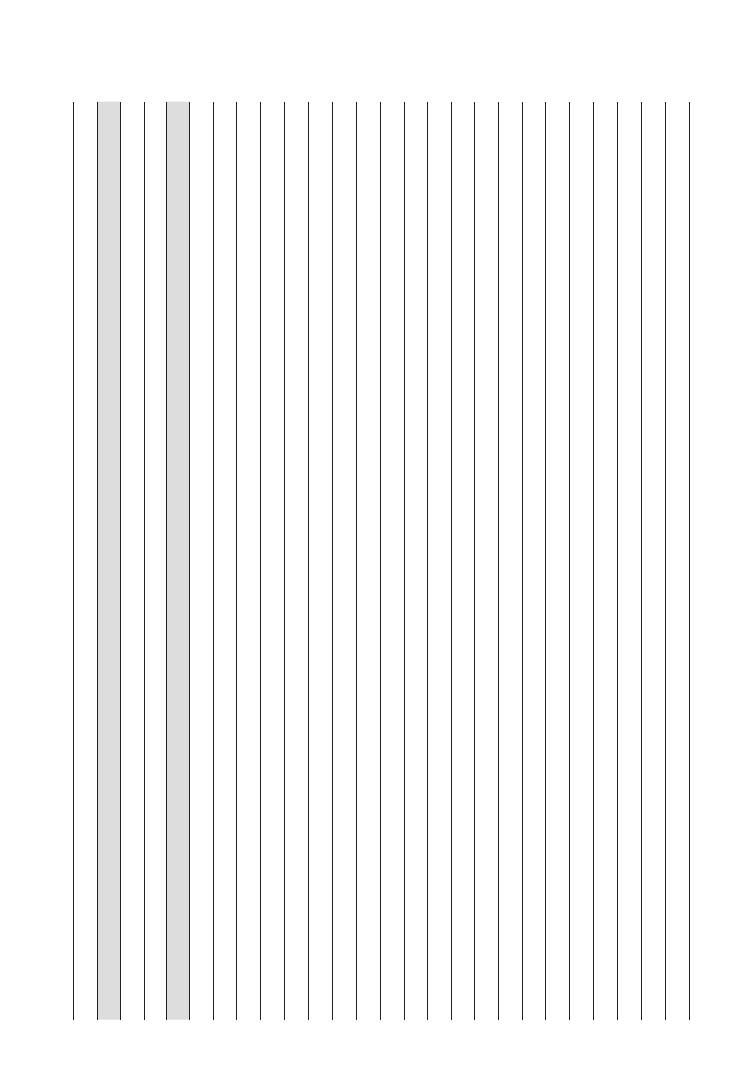
PSB 64 (2) 2018
110
X
X
X
1
In
ter
na
tio
na
l M
ul
tidi
sci
plin
ar
y
Res
ea
rc
h J
our
na
l
Ta
thQ
eef S
cien
tific Pu
bli
shin
g
IJEA
S T
ea
m
Lis
te
d b
y C
ab
el
l On
ly
X
1
In
ter
na
tio
na
l J
our
na
l o
f R
es
ea
rc
h
in En
vir
onm
en
ta
l S
cien
ce
A
RC
N
ar
es
h B (E
di
to
ria
l A
ssi
sta
nt )
X
X
X
X
1
Jo
ur
na
l o
f I
nv
es
tiga
tiv
e G
en
omics
M
edCra
ve G
ro
up
Is
aac B
ria
n
Lis
te
d b
y B
oth B
ea
ll a
nd C
ab
el
l
X
1
Jo
ur
na
l o
f G
eog
ra
ph
y a
nd E
ar
th
Scien
ces
A
m
er
ic
an R
es
ea
rc
h I
ns
tit
ut
e f
or P
olic
y
D
ev
elo
pme
nt
Ex
ec
uti
ve
Ed
ito
r
X
4
In
ter
na
tio
na
l J
our
na
l o
f A
pp
lie
d
Scien
ce a
nd T
ec
hn
olog
y
C
en
ter f
or P
ro
m
ot
in
g I
de
as (CP
I)
Dr
. J
or
ge J
. Sa
nt
ia
go-A
vi
les (C
hief
Ed
itor
)
X
X
1
In
ter
na
tio
na
l J
our
na
l o
f H
um
an
-
ities a
nd S
oci
al S
cien
ce
C
en
ter f
or P
ro
m
ot
in
g I
de
as (CP
I)
Dr
. J
. Sa
br
in
a M
im
s-C
ox (Th
e
Chief E
di
to
r)
3
A
m
er
ic
an I
nt
er
na
tio
na
l J
our
na
l o
f
Bio
log
y
A
m
er
ic
an R
es
ea
rc
h I
ns
tit
ut
e f
or P
olic
y
D
ev
elo
pme
nt
G
en
eva
M
cN
ic
ho
ll, o
n
be
ha
lf
of
Edi
to
r-in-C
hief
1
In
ter
na
tio
na
l J
our
na
l En
vir
on
-
m
en
ta
l & A
gr
ic
ul
tura
l S
cien
ce
Bio A
ccen
t
Ev
ylen
e
X
X
1
In
ter
na
tio
na
l J
our
na
l o
f E
duc
at
io
n
an
d H
um
an D
ev
elo
pm
en
ts
C
en
ter f
or G
lo
ba
l R
es
ea
rc
h D
ev
elo
p-
m
ent
Dr
. C
la
yt
on K
enn
ed
y
X
X
X
1
Jo
ur
na
l o
f E
ar
th
an
d En
vir
onm
en
-
ta
l S
cien
ces
Ga
vin Pu
bli
sh
er
s
Ca
th
y W
illi
am
s (E
di
to
ria
l C
oo
r-
din
at
or)
X
X
X
1
Fo
res
tr
y R
es
ea
rc
h a
nd En
gin
eer
-
in
g: I
nt
er
na
tio
na
l J
our
na
l
M
edCra
ve G
ro
up
Reg
in
a L
aws
ol
1
N
et J
our
na
l o
f A
gr
ic
ul
tura
l S
ci
-
en
ce
N
et J
our
na
ls
Pr
of
. K
adr
iy
e C
ag
la
ya
n (E
di
to
r)
1
Ad
va
nces in Cr
op S
cien
ce a
nd
Te
chn
olog
y
O
MI
CS
G
lo
ry H
ar (E
di
to
ria
l C
oo
rdin
at
or)
X
X
X
X
X
1
Jo
ur
na
l o
f B
io
an
al
ysi
s & B
io
m
ed
-
icin
e
O
MI
CS
Kr
ist
en N
ico
le (
Jo
ur
na
l C
oo
rdi
-
nat
or
)
X
X
X
X
1
Jo
ur
na
l o
f E
co
log
y a
nd T
oxico
log
y
O
MI
CS
A
len
a S. (
Jo
ur
na
l co
or
din
at
or)
X
X
X
2
Jo
ur
na
l o
f P
hy
log
en
et
ics & E
vo
lu
-
tio
na
ry B
io
log
y
O
MI
CS
M
an
ag
in
g E
di
to
r
X
X
1
Res
ea
rc
h & R
ev
ie
ws: J
our
na
l o
f
Bo
ta
nic
al S
cien
ces
O
MI
CS
St
el
la M
ar
is (
Jo
ur
na
l C
oo
rdin
at
or)
X
1
Ad
va
nces in A
ut
om
ob
ile En
gi
-
ne
er
in
g
O
MI
CS
A
nn
a W
ats
on (
Jo
ur
na
l C
oo
rdin
a-
tor
)
x
1
Jo
ur
na
l o
f R
es
ea
rc
h a
nd D
ev
elo
p-
m
ent
O
MI
CS
Jenn
y B
ro
w
n (M
an
ag
in
g E
di
to
r)
X
X
X
2
Jo
ur
na
l o
f B
io
di
ver
sit
y M
an
ag
e-
m
en
t & F
or
es
tr
y
SciT
ec
hn
ol (O
MI
CS)
Shi
ba K
al
ya
n (
Jo
ur
na
l C
oo
rdin
a-
tor
)
X
X
X
X
1
Jo
ur
na
l o
f P
la
nt P
hysio
log
y & P
a-
th
olog
y
SciT
ec
hn
ol (O
MI
CS)
A
ss
oci
at
e M
an
ag
in
g E
di
to
r
X
X
1
VEGE
TOS: A
n I
nt
er
na
tio
na
l J
our
-
na
l o
f P
la
nt R
es
ea
rc
h
SciT
ec
hn
ol (O
MI
CS)
A
na
nd
a T (
Jo
ur
na
l C
oo
rdin
at
or)
X
X
1
Jo
ur
na
l o
f B
io
ch
emi
str
y a
nd B
io
-
te
chn
olog
y
Ser
ies C
omm
unic
at
io
ns
A
nn
ab
el W
ils
on (E
di
to
ria
l A
ssi
s-
ta
nt
)
X
X
X
1
SD
RP E
ar
th S
cien
ces & En
vir
on
-
m
en
ta
l S
tudies
Sift D
es
k G
ro
up
Dr
. R
en
at
o A
len
ca
r

PSB 64 (2) 2018
111
X
1
Jo
ur
na
l o
f S
tem C
el
ls a
nd R
eg
en
-
era
tiv
e Th
era
py
Zyg
oS
cien
t R
es
ea
rc
h I
nsig
hts, I
nc.
Emi
ly W
ats
on (E
di
to
ria
l A
ssi
sta
nt)
Pr
es
ume
d P
re
da
to
ry
X
X
1
6t
h A
nn
ua
l I
nt
er
na
tio
na
l C
onf
er
-
en
ce o
n C
hemi
str
y, C
hemic
al En
-
gin
eer
in
g & C
hemic
al P
ro
ces
s
G
lo
ba
l S
cien
ce a
nd T
ec
hn
olog
y F
or
um
M
or
ega
na
ra
j
(P
rog
ra
mm
e
M
an
-
ag
er)
X
X
X
X
1
Jo
ur
na
l o
f P
la
nt S
cien
ce a
nd P
hy
-
to
pa
th
olog
y
H
eig
ht
en S
cien
ce Pu
blic
at
io
ns C
or
po
-
ra
tio
n
M
ur
ra
y L
X
X
X
X
X
1
Jo
ur
na
l of
P
ol
lut
ion
O
MI
CS
Ch
an
du N (M
an
ag
in
g E
di
to
r)
X
2
Jo
ur
na
l
of
Pl
an
t G
en
et
ics
an
d
Br
ee
din
g: O
pen A
cces
s
O
MI
CS
Jo
hn B
ro
w
n (
Jo
ur
na
l C
oo
rdin
at
or)
X
X
2
A
m
er
ic
an J
our
na
l o
f B
ios
cien
ce
an
d B
io
en
gin
eer
in
g
Scien
ce PC
Edi
to
ria
l Office
X
X
1
N
at
ura
l S
cien
ce
Scien
tific R
es
ea
rc
h Pu
bli
shin
g
Ms. LIU M
en
gzh
u (M
an
ag
in
g E
d-
itor
)
X!
X
1
In
ter
na
tio
na
l J
our
na
l o
f P
ha
rm
a-
co
vig
ila
nce
Sy
m
biosi
s
Vic
to
r D
anie
l
X
X
1
Jo
ur
na
l o
f P
ha
rm
aceu
tic
al C
hem
-
ist
ry & C
hemic
al S
cien
ce
Un
kn
ow
n
Kr
ist
in H
an
le
y (
Jo
ur
na
l C
oo
rdi
-
nat
or
)
X
X
X
2
Jo
ur
na
l o
f M
ar
in
e B
io
log
y a
nd
Aq
ua
tic R
es
ea
rc
h
Un
kn
ow
n
Jennif
er B
ro
w
n (A
ss
oci
at
e M
an
ag
-
in
g E
di
to
r)
X!
X
X
X
1
Jo
ur
na
l o
f A
qu
at
ic S
cien
ces a
nd
O
ce
an
og
ra
ph
y
Un
kn
ow
n
Reu
ben M
ar
k (A
ss
oci
at
e M
an
ag
-
in
g E
di
to
r)
X
X
X
X
1
W
or
ld J
our
na
l o
f R
es
ea
rc
h a
nd
Re
vi
ew
Un
kn
ow
n
WJRR J
our
na
l T
ea
m
X
X
1
A
gr
ic
ul
tura
l R
es
ea
rc
h & T
ec
hn
ol
-
og
y: O
pen A
cces
s J
our
na
l
Un
kn
ow
n
So
phi
a M
at
hi
s
X
X
1
In
ter
na
tio
na
l J
our
na
l o
f En
vir
on
-
m
en
ta
l M
oni
to
rin
g a
nd A
na
lysi
s
Un
kn
ow
n
Edi
to
ria
l Office
X
X
1
Let
ter
s in H
ea
lth a
nd B
io
log
ic
al
Scien
ces
Un
kn
ow
n
Ka
th
er
in
e (E
di
to
ria
l A
ssi
sta
nt)
X
X
X
X
2
Tra
nsy
lva
ni
an R
ev
ie
w
Un
kn
ow
n
X
X
X
1
In
ter
na
tio
na
l J
our
na
l o
f M
an
ag
e-
m
en
t a
nd E
co
no
mics I
nv
en
tio
n
Un
kn
ow
n
Jo
ur
na
l M
an
ag
er
Le
gi
tima
te J
ourna
ls
1
AIMS G
en
et
ics
AIMS P
res
s
Dr
. C
hen
g B
i (M
an
ag
in
g E
di
to
r)
X
2
Cur
ren
t P
ha
rm
acog
en
omics &
Per
so
na
lize
d M
edicin
e
Ben
th
am S
cien
ce
Pr
of
. A
dr
iá
n L
ler
en
a (E
di
-
to
r-in-C
hief
)
1
Fr
on
tier
s in B
io
log
y
H
ig
her E
duc
at
io
n P
res
s a
nd S
pr
in
ger
H
on
gj
un S
on
g P
h.D
. (E
di
-
to
r-in-C
hief
) a
nd X
ue
li Zh
an
g
(M
an
ag
in
g E
di
to
r)
1
Fo
res
ts
M
DP
I
1
Ad
va
nces in B
ios
cien
ce a
nd B
io
-
te
chn
olog
y
Scien
tific R
es
ea
rc
h Pu
bli
shin
g
Ms.
Jiao
jiao Y
ao
(A
lice) (E
di
to
ria
l
A
ss
ist
an
t)
1
A
m
er
ic
an J
our
na
l o
f P
la
nt S
cien
c-
es
Scien
tific R
es
ea
rc
h Pu
bli
shin
g
Ms. D
EN
G J
in
g (
Jo
y) (E
di
to
ria
l
A
ss
ist
an
t)
1
Lif
e: Th
e E
xci
tem
en
t o
f B
io
log
y
Sel
f-p
ub
lishe
d
Jo
rg
e A. Sa
nt
ia
go-B
la
y, P
hD

PSB 64 (2) 2018
112
The only instrument in the
world that uses Rapid Sensing
™
Technology for fast A-C
i
curves
and survey measurements.
www.licor.com/6800
LI-6800 Portable
Photosynthesis System
Stinziano JR, Morgan PB, Lynch DJ, Saathoff
AJ, McDermitt DK, and Hanson DT. (2017)
The rapid A-C
i
response: photosynthesis in
the phenomic era. Plant, Cell & Environment,
40:1256-1262. doi: 10.1111/pce.12911
See the open access
Rapid A-C
i
Response
(RACiR
™
) Method paper
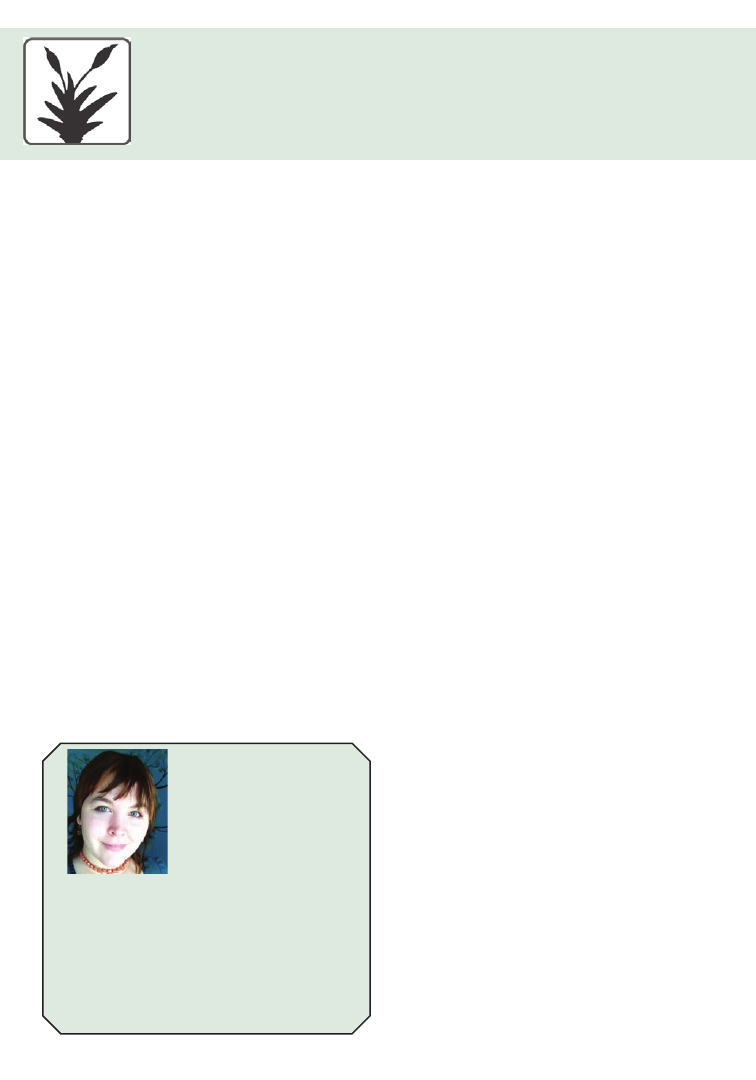
113
SCIENCE EDUCATION
By Dr. Catrina Adams,
Education Director
BSA Science Education News and Notes
serves as an update about the BSA’s educa-
tion efforts and the broader education scene.
We invite you to submit news items or ideas
for future features. Contact Catrina Adams,
Education Director, at cadams@botany.org.
PlantingScience
participates in NSF’s
STEM for All Video Showcase
“I’m just also enthusiastic about plants, more
than I ever was before – because they are
awesome, actually. I’m sorry I missed that, but
I’ll catch up now.” – PlantingScience teacher
and Digging Deeper participant
“I’m there to inspire [students] to be better
scientists, but they inspire me that the
future is actually going to be awesome.” –
PlantingScience early-career scientist liaison
and Digging Deeper participant
Come watch PlantingScience’s new 3-minute
video with footage from interviews with
teachers and early career scientists from last
Education News and Notes
summer’s collaborative teacher/scientist
professional development workshop.
PlantingScience joins 214 other NSF-funded
projects from the DRK-12 and C-STEM
programs in the 2018 showcase. This year’s
theme is “Transforming the Educational
Landscape.” If you are curious to see how
PlantingScience and the Digging Deeper
professional development program are
impacting teachers and changing the education
landscape for the better, please watch our
3-minute video at:
http://stemforall2018.
videohall.com/presentations/1086
Last year’s award-winning video provides
an overview of the Digging Deeper project
and an outline of the research design, which
can still be accessed at http://stemforall2017.
videohall.com/presentations/922.
Make a Difference in
Secondary Education:
Sign up as a Planting-
Science Mentor or Join the
Master Plant Science Team
Are you looking for ways to impact the
future of botany? To pay forward the
mentoring and enthusiasm that made you the
passionate botanist you are? Mentoring with
PlantingScience takes about an hour a week and
can be done from anywhere with an internet
connection. The fall session starts September
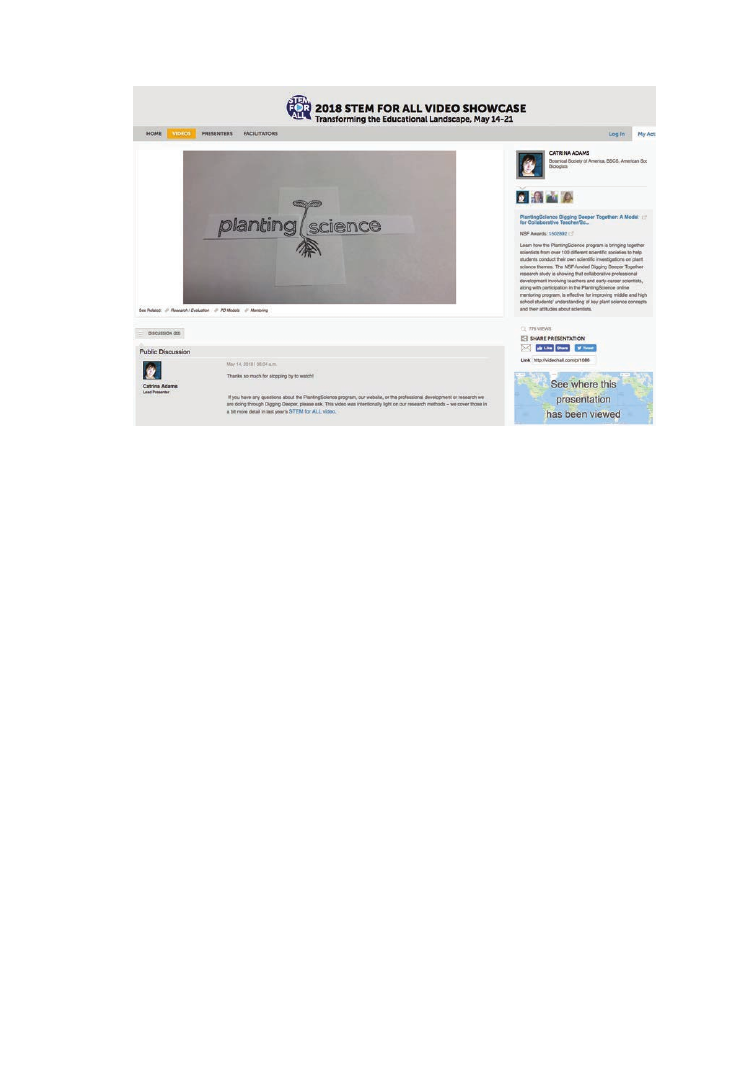
PSB 64 (2) 2018
114
15. Sign up at https://plantingscience.org/
mentorjoin/mentorjoinmain and complete
your profile by September 10 for the best
chances for team matches. Teachers appreciate
the personal attention and motivational boost
you give to small student teams, and it is an
excellent way to polish your mentoring skills
around investigation design and practice
communicating with young and diverse
learners. You can choose to mentor projects
that fit nine broad themes in plant biology.
Check out our Star Project Gallery for
examples of student/mentor conversations
at https://plantingscience.org/psprojects/
starprojectgallery.
Graduate students and post-doctoral
researchers: does mentoring with
PlantingScience sound exciting to you? Do
you have good communication skills already
and some experience with or a strong interest
in helping secondary students and teachers?
If so, consider the next step: becoming a part
of our Master Plant Science Team and serving
as a teacher/scientist liaison. We provide
special training in what it takes to excel as an
online mentor and reveal behind-the-scenes
aspects of how the program works. First,
you’ll get to mentor several teams to learn the
ropes and practice mentoring with diverse
groups of students. Then you are paired with
one of our participating teachers to help the
teacher get the most from the program, make
sure the teacher’s mentors get the classroom
and scheduling context they need to be
good mentors, and help to keep the student/
scientist conversations going strong. It is an
excellent opportunity to see how a variety of
mentoring styles play out with students and
a powerful way develop your own mentoring
and communication style. Liaisons make the
program possible! In exchange for your extra
help, we sponsor your BSA membership for
the year and provide a 50% discount off of
meeting registration. Learn more and apply
by August 6 at https://plantingscience.org/
joinmpst.
Screenshot from the STEM for ALL 2018 Video Showcase.

PSB 64 (2) 2018
115
On the fence? Learn more about the program
from participating mentors, teachers, and
liaisons at Botany 2018’s PlantingScience
mentor workshop on Sunday, July 22,
from 10
a.m. to noon.
Many thanks to the following BSA MPST
2017-2018 members for their hard work and
dedication: Alex Rajewski, Anna Sugiyama,
Ben Scott, Christopher Fiscus, Derek Denney,
Dr. Chris J. Meyer, Elizabeth Lombardi,
Elizabeth Stunz, Foong Lian Chee, Irene
Liao, Jacob Suissa, Jaime Schwoch, Kate
Eisen, Laura Klein, Liliana Belmonte, Morgan
Gostel, Ojo Funmilola Mabel, Rachel Meyer,
Sarah Wike, Stephanie Conway, Sukuan Liu,
and Tania Jogesh.
Upcoming Education
Conferences
Life Discovery – Doing Science Education
Conference, March 21-23, 2019:
Microbiomes to Ecosystems: Evolution and
Biodiversity across Scale, Space, and Time
BSA co-sponsors the Life Discovery – Doing
Science Education Conference, a stand-alone
education conference for high school and
undergraduate biology educators. The call for
proposals is opening in July, so sign up soon
to present your ideas. This is an interactive
conference with many opportunities to
network and share ideas with colleagues
interested in biology education.
About the conference theme: Our knowledge
about the Earth’s biodiversity across space,
time, and scale is expanding rapidly. New tools,
like remote sensing, are creating new data
sources, while other tools, like digitization, are
freeing traditional datasets from the cabinets
and drawers of labs and collections and
making them accessible online. How do we
teach students about biodiversity at different
scales and contexts with these new data, tools,
and resources? How do we best enable and
develop the next generation of 21st-century
scientists and create data-driven educational
programs aligned to national initiatives such
as Next Generations Science Standards and
Vision and Change for Undergraduate Biology
Education? The Life Discovery – Doing
Science Biology Education Conference will
build on the 2017 data theme and challenge
educators to create opportunities for their
learners to explore our theme across:
Scale: Through new technologies, we can
study biodiversity scaling from an individual’s
microbiome to the Earth’s biomes. How
do we help students explore biodiversity
concepts and evolution at different scales and
investigate interactions across scales?
Space: We now have access to environmental
and biodiversity data spanning habitats, eco-
systems, and landscapes. How do we help our
students think in broader geographical con-
texts about evolution, biodiversity, ecology,
and conservation?
Time: We have the ability to look at life on
earth across geologic time through the fossil
record and through digitized natural history
collections. How do we approach big ques-
tions like how have populations, species, and
communities evolved over time and how will
big-scale processes like climate change and
human impacts affect biodiversity in the fu-
ture?
For more information and to see the request
for proposals, please visit http://www.esa.
org/ldc/.
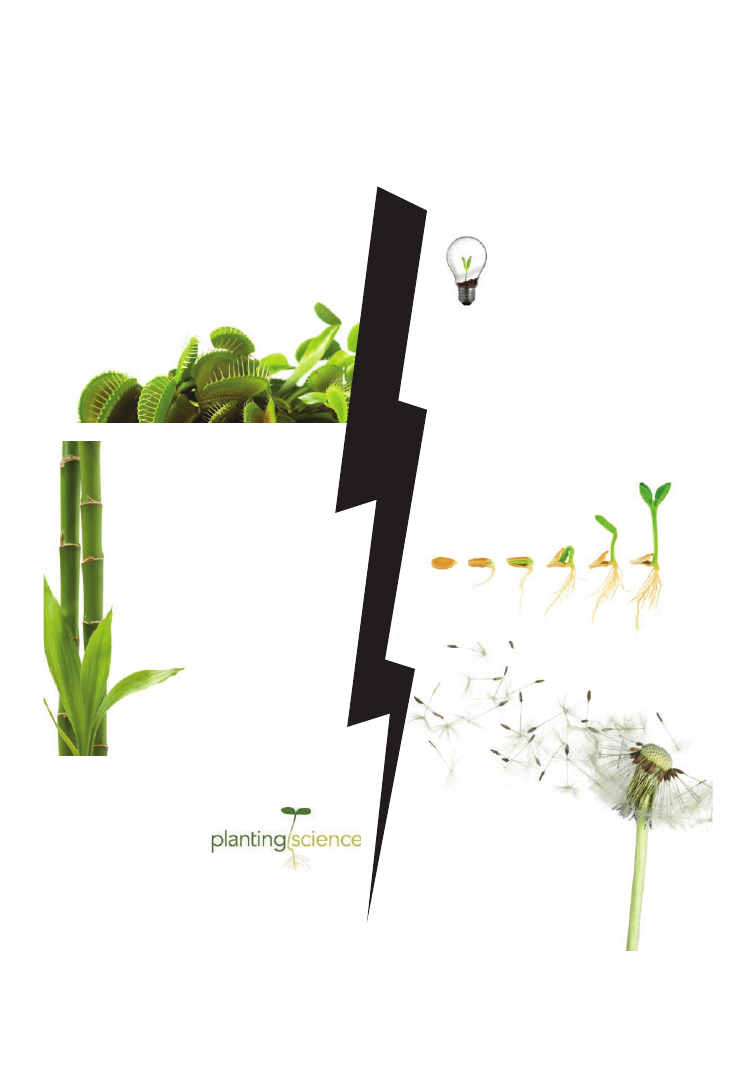
PSB 64 (2) 2018
116
High-Speed
BOTany
For Everyone!
Your colleagues have
developed innovative
ways to share botany with
students and the public. Pick
up effective education and
outreach ideas you can use
to share your passion for
plants.
Join us for high-speed
presentations, hors
d’oeuvres, and plenty of time
for conversation.
germinating
ideas
new
new
new
ideas
approaches
data
and anything else not ready for
a full talk.
Two different lightning talk sessions at Botany 2018.
Pick up new ideas 3 minutes at a time!
Monday
7-9PM
Wednesday
3:45-5:30PM
at the
reception
2
unique
options!
Sequential talks with discussion
at the end for
feedback and refreshments.

PSB 64 (2) 2018
117
FROM THE
PSB
ARCHIVES
60 years ago: Charles E. Bessey was memorialized in the pages of PSB more than 40 years after his death in
February 1915. His love of teaching and his scholarly contributions are highlighted, as are some of the more
unique aspects of his personality.
“I have talked with scores of Bessey’s students, over the course of a half-century, and in every instance
they have told me of some inspiring occasion or statement, often profound sometimes homely, in classroom
or elsewhere, that inspired them and endeared the man to them forever. The intensely infectious, and always
wholesome enthusiasm of the man left their lasting stamp upon thousands of men and women who never
went beyond the Freshman course with him. To this day few of them could distinguish between parenchyma
and sclerenchyma, or tell the difference between Chroococcus, Cystopteris, and Chenopodium. But they all
proudly testify to the lasting effect of a bit of meristem that he left forever implanted in their future lives,
whether, in after college days they became bankers, lawyers, merchants, teachers, clergymen, politicians,
biologists, foresters, botanists, geneticists, phytopathologists, or virologists!”
-Pool, Raymond J. “Professor Charles Edwin Bessey, Master Teacher “ PSB 4(5): 7-8
50 years ago: Editor Adolph Hecht thanked Bill Stern for filling in as “Temporary Editor” and alerted read-
ers to a problem that persists to this day, as the current editor can attest.
“May I take this opportunity to thank Dr. Bill Stern for the superb job he did as ‘Temporary Editor.’ One
might assume that this was very easy for Bill to do since he himself had been Editor for several years preced-
ing my current term. . . Among other problems was his need to “scrounge” for appropriate copy to fill our
usual eight pages at quarterly intervals. This continues to be my problem, yet surely the botanists of America
are engaged in many activities that deserve to be brought to the attention of our readers.”
-Hecht, Adolph. “Notes From The Editor” PSB 14(3): 4
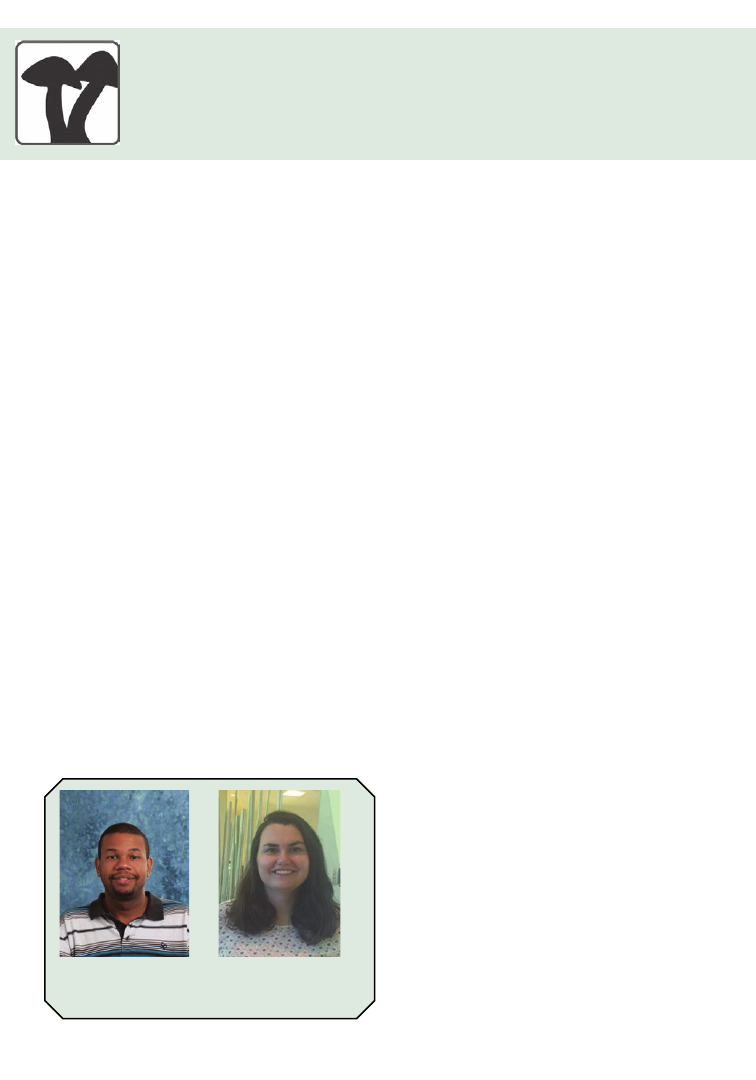
118
STUDENT SECTION
By James McDaniel and Chelsea Pretz,
BSA Student Representatives
The annual BOTANY conference is just
around the corner! With 6 days of formal
talks, dual poster sessions, workshops, field
trips, social events, networking, and more,
you’re probably wondering how you can get
the most out of this year’s experience. Well,
don’t worry because we’ve got you covered in
our student-focused guide below.
Travel and Lodging
1.
Travel Grants: Although it is too late to apply
for BSA-related travel grants this year, please keep
these opportunities on your radar for spring 2019!
You can find a consolidated list of these awards as
well as details pertaining to them online at
http://
botany.org/
.
Once you reach the website,
click the “Awards” tab and then scroll down and
click the “Travel Awards for Students” tab. A list
will pop up with links to each of the following:
Navigating BOTANY 2018: A Guide
for Student Members
• PLANTS grants continue to thrive, thereby
ushering in a new cohort of undergraduates
each year from talented and diverse back-
grounds. The PLANTS program has been
funded by the NSF and BSA since BOTA-
NY 2010, covering the normal costs of trav-
el, registration, food, and accommodations
at the meeting.
• Triarch “Botanical Images” Awards pro-
vide acknowledgement and travel support
to BSA meetings for outstanding student
work in the area of creating beautiful botan-
ical digital images. If you already use images
of plants in your research, why not submit
some of your favorites to show them off?
• Section Awards: There are numerous sec-
tions within the BSA that provide travel
awards to the annual BOTANY conference.
Please be sure to check with your sections
online for more details!
• Vernon I. Cheadle Awards are generally
awarded to students who will be presenting
in a session sponsored by the Developmen-
tal and Structural Section, so please plan ac-
cordingly!
• Finding a Roommate: Are you looking to
save $$$ by splitting hotel costs at BOTA-
NY 2018? Chec
k out BSA’s nifty roommate
finder tool at http://images.botany.org/
roommate.shtml. It can b
e a great way to
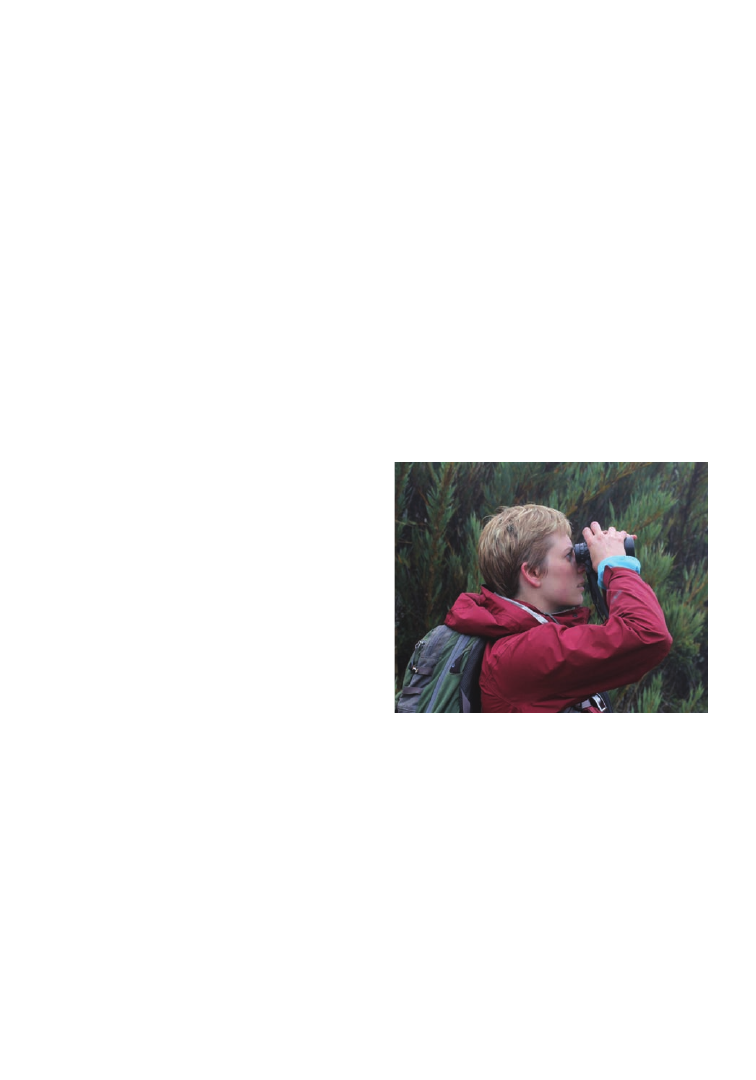
PSB 64 (2) 2018
119
connect with your peers, make new friends,
and forge life-long professional connections!
Also, for more information on discounted
hotel rates, check out:
http://www.botany-
conference.org/hotels.html.
Volunteer at the Conference: Did you know
that you can earn your early registration fee
back if you volunteer to assist BSA staff at the
conference? In fact, the conference couldn’t
happen without the gracious help of students
who ru
n the registration booth, monitor
ticketed events, and make sure that sections,
symposia, and colloquia run smoothly. For
more information about this wonderful
opportunity, be sure to read your BSA
newsletters that come via e-mail and keep
tabs on the conference website (http://www.
botanyconference.org/)!
Events for Students
If you have already registered for BOTANY
2018, it is incredibly easy to add events
to your conference registration! Navigate
to the conference website at
http://www.
botanyconference.org/
and click the link
“Register Online for Botany 2018”. Once you
are re-directed to the registration page, then
click “Modify Registration”. Please note that
while some events are free, all of them are
reasonably priced!
Workshops
• “Job Search Transparency: Learning the
Unwritten Rules to Land your Dream Job”,
led by your friendly neighborhood BSA stu-
dent representatives and a diverse group of
panelists who will make brief introductions
and then open up the floor with an infor-
mal question-and-answer session between
the panelists and attendees. The goal of this
workshop is to help young professionals
navigate and move forward from graduate
school or postdoctoral positions on a pos-
itive career trajectory. (Free, but please reg-
ister!)
• “The Elevator Speech: Crafting an Effective
Pitch that Highlights your Research and Il-
lustrates the Broader Impacts”, led by the
BSA student reps and featuring tips from
our keynote speaker Amanda Grusz, shown
below, who will provide helpful tips on craft-
ing an effective elevator speech followed by
a breakout session to allow attendees the
opportunity to revise and modify their own
elevator speeches. (Free, but please register!)
• “Tips for Success: Applying to Graduate
School”, led by Anna Monfils, is a panel dis-
cussion designed to introduce undergradu-
ate students to the specific requirements for
applying to graduate programs in plant biol-
ogy. (Free, but please register!)
Student Involvement in Botany Luncheon –
A Focus on Botanical Career Opportunities
• What can you do with a degree in botany?
Make sure that you are present at the annual
Student Luncheon to find out! We will kick
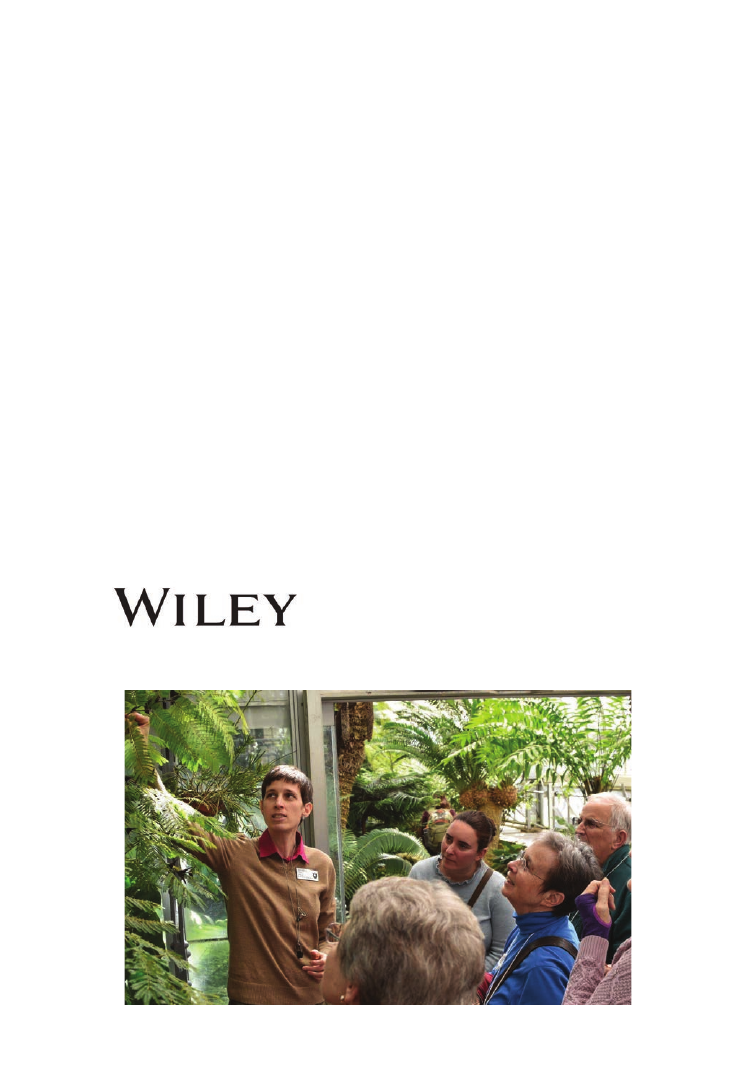
120
off the event with a short talk, “
Following
Your Plant (or other!) Passion
”, from our
keynote speaker, Susan Pell, pictured be-
low at left, the Science and Public Programs
Manager at the U.S. Botanic Garden. Then
you will get a chance to chat with panelists
from various career paths in a “speed-dat-
ing” format. FYI, the panelists usually have
insider information on open positions for
graduate school or careers. ($10 - includes a
catered lunch)
Student Social and Networking Event
• This event is an annual favorite! This year we
will be at Grand Rounds in Rochester, Min-
nesota. This venue is a short walk from the
Rochester Civic Center and features good
food and local brews. Sponsored in part by
Wiley—come catch up with old friends and
meet new ones while enjoying craft brews
and snacks. ($10 - includes a drink ticket)
Undergraduate Student Networking
Event
• This is our second annual Undergraduate
Student Networking Event, which will be
held at the beginning of the conference on
Sunday evening. This event was a great suc-
cess last year! Not only will it provide attend-
ees with an excellent opportunity to meet
fellow undergrads, but it will also allow indi-
viduals to make some new friends/contacts
to help them navigate through the rest of the
conference. You’ll also get a chance to hear
about different career paths! (Free – food will
be included!)
Poster Session
• Whether you are presenting your own
work or just there to see what other people
are working on, this is a great time to talk
science, learn about cutting-edge plant re-
search, and meet people! Poster sessions will
happen on July 23. Be sure to check out a
detailed schedule on the web at http://2018.
botanyconference.org/engine/search/ or via
the Botany Conference app, which will be
available soon! (Free - no ticket required)
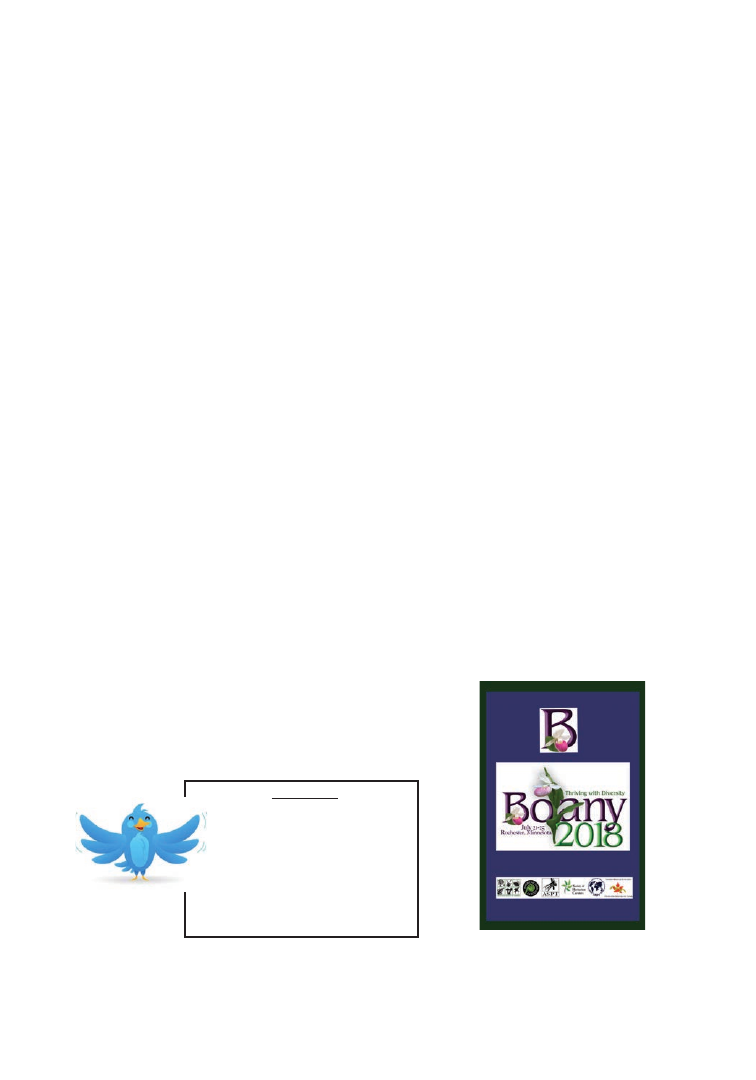
121
Field trips
• Rochester has a rich history and diverse lo-
cal ecosystems, which you can explore first-
hand with local experts! This year, a whop-
ping 13 field trips (one overnight) are being
offered over the span of four days (Friday,
Saturday, Sunday, and Thursday). Whether
you have a knack for hiking, collecting, kay-
aking, or exploring, we bet there’s a field trip
tailored for you! Discover sedges and other
flora of the area, visit the new Bell Museum
and MIN Herbarium, wander through the
Minnesota Landscape
Arboretum, or vis-
it Paisley Park—Prince’s private estate! For
more information about individual field
trips, please check out the following link:
http://www.botanyconference.org/field-
trips.html/. (Prices vary)
For most ticketed events, it’s not too late to
register! Tickets for these events are easy to
add to your conference registration: Navigate
to the conference website at http://www.
botanyconference.org/ and click the link
“Register Online for Botany 2018”. Once you
are re-directed to the registration page, click
“Modify Registration”. You can also register
for events at the registration booth once you
arrive at the conference; however, events tend
to fill up fast, so plan accordingly!
The BOTANY Conference App
• Schedule Planner: With so many events
co-occurring during the conference, plan-
ning each day can be a daunting task! How-
ever, with the BOTANY conference app, you
will have the freedom to effortlessly browse
talks and events as well as create your own
easily accessible schedule to stay on track.
The app for this year has not been released
yet, so make sure to read your BSA newslet-
ters that come via e-mail and keep tabs on
the conference website (
http://www.botany-
conference.org/)
for more details!
• Share your BOTANY experience: Social
media allows you to share your experiences
at the conference, and the number of tweets,
posts, likes, and shares are growing every
year. The social media aspect lets you share
your photos and thoughts throughout the
conference, and it can also be a way to share
your work and increase your visibility. It’s a
great way to see what is going on and keep
tabs on all of your conference buddies! Keep
an eye on the hashtags to use this year, but
be sure to use #BOTANY2018 in your posts!
Do you Tweet?
Be sure to join the conversation!
Follow the conference at
#BOTANY2018
We will be tweeting room changes,
restaurant reviews, conference tips, and
other bits of information through
Twitter and our conference App.
Stay in touch - even if you can't be with us in Rochester!
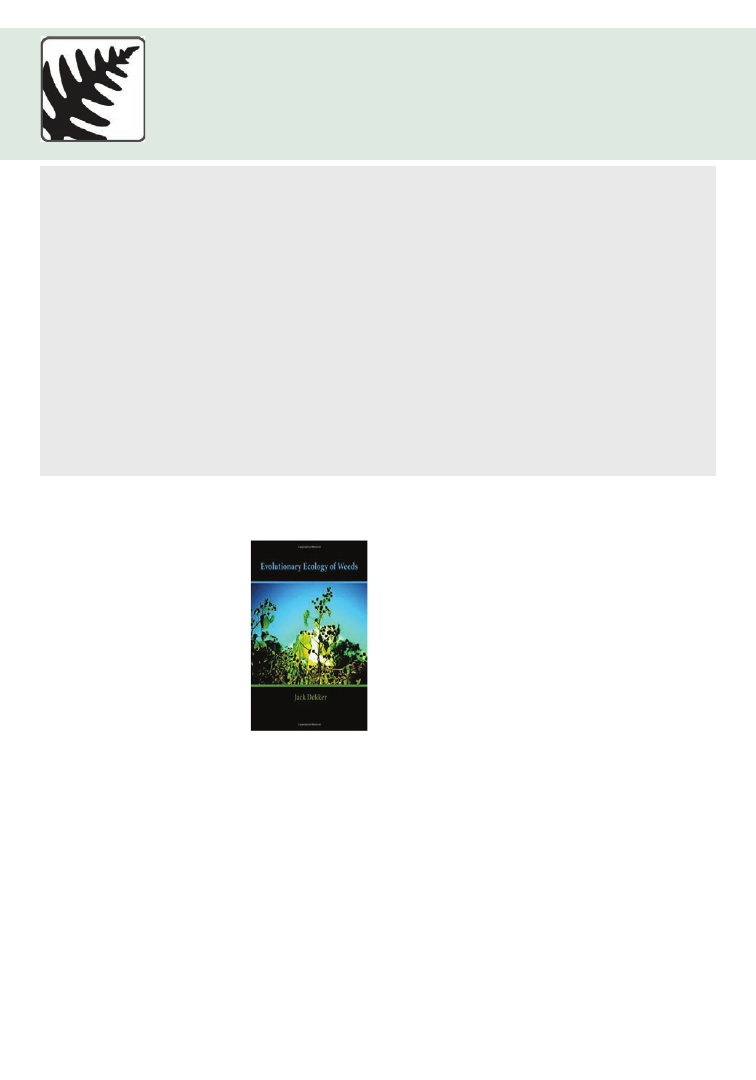
122
BOOK REVIEWS
Ecology
Evolutionary Ecology of Weeds ......................................................................................................................122
Discoveries in the Garden ..................................................................................................................................124
Economic Botany
Ethnobotany, a Phytochemical Perspective ..............................................................................................125
The Food Explorer. The true adventures of the globe-trotting botanist who
transformed what America eats ......................................................................................................................127
Historical
Nature’s Colony: Empire, Nation and Environment in the Singapore Botanic Gardens ..130
Systematics
Catalogue of the Vascular Plants of New York State ........................................................................132
Evolutionary Ecology of
Weeds, ed 2
Jack Dekker
2016. ISBN: 978-1-53540-107-4
Paperback, US$60.00. 552 pp.
CreateSpace Independent Pub-
lishing Platform, San Bernardi-
no, California, USA
Weeds are typically the first
plants I learn when I have
traveled to a new area for work because of
their abundance and propensity for upland
habitats. Several species that I am familiar
with in the East also occur out West, which
would follow the pattern of settlers moving
across the country. Dr. Dekker makes this
point early on: the story of weeds is the story of
humans and how we have moved and brought
agriculture to different areas throughout the
world. Weeds, unless they are invasive, haven’t
been a focus of any of the work that I’ve done,
but reading this book has given me a broader
perspective.
ECOLOGY
The book is separated into seven units
containing nineteen chapters. There are also
selected readings, references cited, and an
indexed glossary. There is a summary and
foreword to kick things off, with a table of
contents in between.
Unit 1 is the nature of weeds. This unit only
contains one chapter, but explains how many
of the plants that we now consider weeds
are related to plants and their seeds that are
consumed. The history of weeds is the history
of agriculture, and many weedy plants have
relatives that are still consumed to this day.
A list of such species is provided with crop
species and their associated weed relatives
(pp. 52-76).
Unit 2, “The evolution of weed populations.”
is described within Chapters 2-5. There is a
focus on natural selection and adaptations
that have made weedy species able to persist
and occupy opportunity spacetime. Natural
selection has included human intervention
where the attempt to control weeds has

PSB 64 (2) 2018
123
produced stronger variants. This also includes
a lot of things discussed in detail later in the
book but mainly a plant that can colonize
quickly after a disturbance and sometimes lay
dormant in the seed bank germinating when
the conditions improve.
Unit 3, “Adaptation in weed life history,” is
described within Chapters 6-8. Adaptations
are further discussed as are abilities like
exploiting locally available opportunity,
growth form, and strategy per conditions. I
don’t know that a plant can have a strategy,
but morphological adaptations to survive in
different conditions are discussed. Seed size
and number is also discussed here and later
in the book. A plant has finite resources and,
depending upon conditions, the seed size and
number can adjust over time to the habitat
conditions to increase survival potential.
Unit 4, “Adaptation in local plant
communities,” is described within Chapters
9-10. The concept of a “weed guild” is
introduced, which would pique the interest
of my birder friends, I believe. That’s the only
other place that I have heard that term used
is by birders, but it seems to fit weeds as well
for species that have similar adaptations and
habitat preferences. I also appreciated the
biogeography theories as an area of study that
needs to be further explored.
Unit 5, “Complex adaptive weed systems,” are
described within Chapters 11-13. This unit
dives into the features of weedy vegetation
and complex adaptive system (CAS). CAS
includes how the many parts of an organism
or community of organisms work together to
adapt to the environment in which a species
exists.
Unit 6, “Representation of weed biology,” is
described within Chapters 14-16. Discussion
includes statistical analysis and how it doesn’t
fit these species due to the dynamics and
adaptive capabilities of the group and how the
assumptions used are typically incorrect. The
cultural chapter, Chapter 16, is interesting in
that it discusses how species are studied and
how perception and opinion have been too
heavily intertwined with weed science
Unit 7, “Weed case history,” is described
within Chapters 17-19. This unit gives a
thorough investigation into species that the
author has studied throughout his career and
is an in-depth look into the Setaria species,
Brassica napus, and Abutilon theophrasti. The
life histories, morphology, and adaptations
are included within this discussion along with
species associations. It would be hard to find
a better synopsis of decades worth of research
into these groups and species.
This would be a great text for an undergraduate
course in weed evolution. There are a few
references to Wikipedia that should probably
be sourced elsewhere, since it’s not a peer-
reviewed source. I would also like to see more
selected readings and the addition of chapter
review questions since there is no companion
text with possible assignments if I were using
it to teach. All things considered, this would
be a great resource for someone looking for
more information on this topic and on the
case study species in particular.
-David W. MacDougall, CWB® Consulting
Biologist
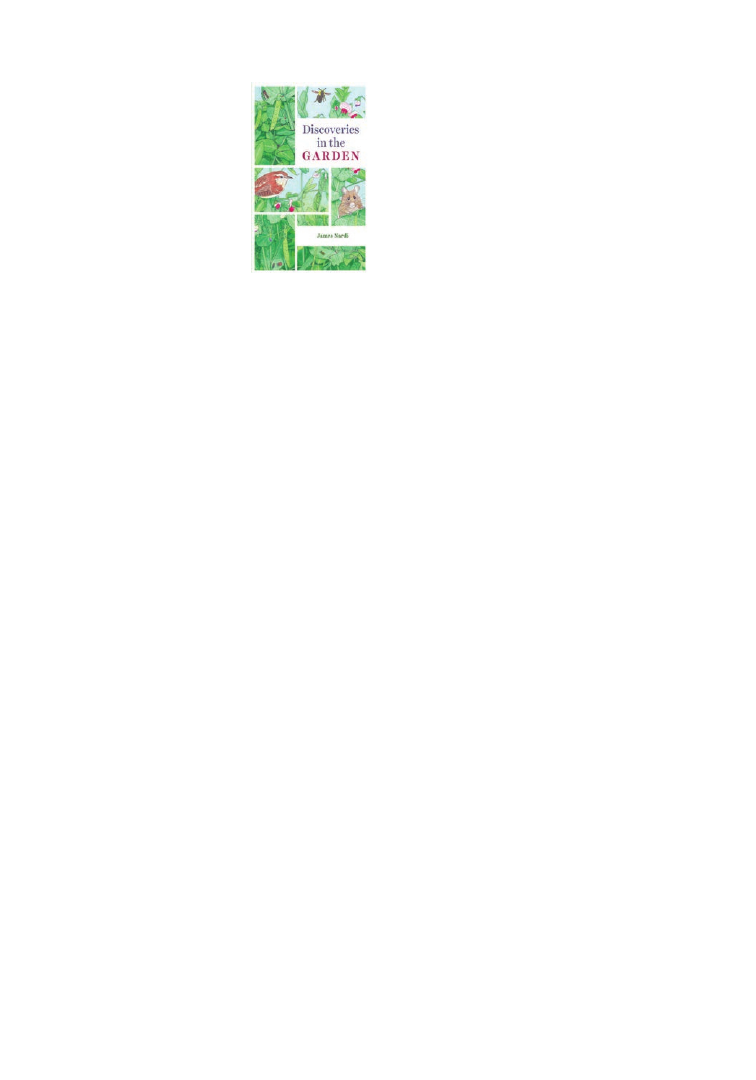
PSB 64 (2) 2018
124
Discoveries in the
Garden
James Nardi
2018.
ISBN: 978-0-22653-166-3
Paperback, US$25.00; 280 pp.
The University of Chicago Press,
Chicago, Illinois, USA
For many burgeoning
botanists, the garden is
the birthplace of a fascination with plants.
Dr. James Nardi’s new book, “Discoveries in
the Garden”, harnesses this sentiment and
expands on it, giving us a wonderful tour of
plant form and function while magnifying
plant and animal interactions through the lens
of the backyard garden. Through his use of
illustration, anatomical photographs, at-home
experiments, and thoughtful prose, Nardi
introduces an abundance of information
without losing the captivating appeal of plants.
The first few chapters take us on a journey
through a plant’s life from seed to flower,
ranging from belowground roots to
aboveground stems, leaves, and flowers. These
chapters focus on the development of the plant,
emphasizing different organs and anatomical
structures, as well as the triggers that help
plants “know” when and how to grow. Chapter
4 gives an elegant breakdown of pollination,
fruit development, and the alternation of
generations in plants, representing concisely
one of the more complex and confusing
concepts in plant biology.
With the basics covered, Nardi transitions
into the more in-depth topics of energy
collection and plant mobility in Chapters
5 and 6. Photosynthesis is broken down
into its respective chemical components,
including a comparison of C
3
and C
4
plants.
He then introduces us to the macro- and
micronutrients that plants obtain from the
soil. These explanations are complemented
by suggested at-home experiments that use
different fertilizers to illustrate how plants
utilize these nutrients. Next, the familiar
growth of tendrils and vines is tidily explained
and contrasted with the daily movements of
leaves and flowers: a fascinating peek into the
world of plant behaviors.
“Wisdom of the Weeds”, Chapter 7, uses
the unique perspective of “weedy” plants to
illustrate several plant phenomena, including
asexual reproduction, competition, and seed
dispersal. This chapter highlights some of the
reasons weedy plants are so successful and
gives us pause to see these more common
plants in a different, perhaps more positive,
light.
Chapters 8 and 9 discuss plant chemicals. In
sophisticated detail, Nardi reflects on plant
pigments, odors, and oils; their utility to the
plant; and their utility to humans through
dyes, fragrances, and nutrition. A section
on companion gardening advises the home
gardener perfectly, with insights into ecological
competition and large-scale agriculture.
The book concludes with a discussion of non-
plant garden inhabitants, focusing on bacteria,
fungi, and insects. The inclusion of species
interactions and ecosystem functioning here
places the plant in the context of a community
with its biotic counterparts. Nardi emphasizes
belowground soil dynamics and the living
components of soil health—an aspect of the
garden that may be overlooked by the casual
observer.
In each chapter, Nardi does an excellent job
of incorporating aspects relevant to a variety
of target audiences. The prose of the book is
appropriate for all audiences, while sections
titled “Observe” will have the home gardener
and plant enthusiast looking at their yards
in a new light. Sections titled “Hypothesize”
suggests different aspects of the plant to look

PSB 64 (2) 2018
125
at or manipulate, predictions to make, and
experiments to help answer these questions.
Some of the experiments seem simple and
require little more than the materials a typical
gardener would have access to. More intricate
experiments are also proposed, requiring
more time and some basic scientific equipment
(petri dishes, dissecting microscope, etc.). The
diversity in recommended experiments allows
the reader to pick and choose according to
their own interests or teaching purposes.
The aesthetic appeal of the book adds a new
dimension to the biology it describes. The
scientific figures and anatomical pictures of
plants lend insights to the casual gardener
that might otherwise only be found in a more
technical textbook. The beautiful and detailed
illustrations, artfully drawn by Nardi, show
the complexity and diversity of the nature
found right in our backyards. Nardi uses a
rich yet simple prose and quotes from writers,
scientists, and philosophers to convey his
message and puts the detailed science a more
well-rounded context. He breaks down the
scientific terminology into its roots in Latin
and Greek, which helps to describe concepts in
layman’s terms, and will delight the language
aficionado.
Nardi’s focus on a traditional North American
or European garden allows him to add a more
personal feeling to the book as he references
his own home garden in Illinois. Despite his
regional specific experience, the scientific
principles and many of the references to
crop plants and ecology will resonate with a
global audience. Nardi explains the science of
plants in a clean, charismatic and cultivated
way that can be enjoyed by plant enthusiasts
and gardeners of all scientific backgrounds.
“Discoveries in the Garden” is a wonderful
read.
-Nora Mitchell, Department of Biology,
University of New Mexico, Albuquerque, New
Mexico, USA
ECONOMIC BOTANY
Ethnobotany, a Phyto-
chemical Perspective
Barbara M. Schmidt and Diana
M. Klaser Cheng, Eds.
2017. ISBN: 978-1-11896-190-2
Hardcover, US$150.00; E-Book
$120.99. 357 pp.
John Wiley & Sons Ltd., Hoboken,
NJ, USA
Intended as a textbook for advanced
undergraduate or graduate students, there are
many things to like about this book, which
examines the chemistry of plant medicines,
dyes, fibers, flavors, poisons, and insect
repellants, among other useful botanicals.
Since both editors have industry connections
(B.M. Schmidt, Global Leader of Plant
Biology, L’Oreal USA; D.M. Klaser Cheng,
Senior Scientist, Nutrasorb, LLC and Visiting
Scientist, Rutgers University), a logical
focus is to unite botany, ethnobotany, and
phytochemistry with inputs of applied botany
to industry.
The first chapter, one third of the book,
introduces ethnobotany. Key topics include
the history of plant exploration, current
issues such as conservation and intellectual
property rights, and a brief review of plant
anatomy. Focus on plant taxonomy highlights
especially significant, economically important
plants. Valuable attention is paid to herbaria
and voucher specimens.
Discussion about intellectual property is
appreciated, as present-day researchers
face hurdles even to collect voucher
specimens for basic research in taxonomy,
systematics, and chemotaxonomy. Collection
for bioprospecting is lightly covered,
including the complexities arising from the
Convention on Biological Diversity, “benefit

PSB 64 (2) 2018
126
sharing,” and “capacity building”—although
considering the authors’ work with industry,
that issue may have arisen. I was impressed
by this warning (p. 21): “…in some ways,
ethnobotany is unintentionally at odds with
conservation and the rights of indigenous
people. Publishing descriptions of valuable
plant species and traditional knowledge as a
free exchange of scientific information could
contribute to economic exploitation of the
area and rob the people of potential economic
benefits. The question of whether traditional
knowledge should be made public is a topic of
much debate. Information in public domain is
free for development by commercial interests
unless a patent application is filed before
publication. So, academics must err on the
side of caution when publishing potentially
sensitive information.”
The achievements of plant-derived drugs
are many and should be celebrated, but
many obstacles are put before present-day
collectors—so it is unclear whether success
stories revealed in the text will be achievable
any longer. This may be an historical look at
past discoveries.
The uniqueness of this book is its focus on
phytochemistry. Fundamentals of secondary
metabolism, as well as traditional and
modern methods of plant extraction and
chromatographic techniques, are summarized
in 30 pages.
The remaining two thirds of the book offers
a history of plants native to each region and
features “Case Studies” about selected plants
that changed the course of human history
from each continent. Africa holds Achillea
millefolium, vanilla, and traditional treatments
for HIV in South Africa. The Americas feature
agave, quinoa, maqui (Aristotelia chilensis; an
ancient Mapuche medicine with antidiabetic
potential), and betalains from Chenopodium
quinoa.
Asia, the largest continent, holds the longest
list of authors (12). Case Studies include the
ethnobotany of teeth blackening in southeast
Asia, Artemisia and human health, the sacred
plants Betula utilis (bhojpatra) and Quercus
oblongata (banj) from Uttarakhand, and
neem-based insecticides.
European plants include Lavandula stoechas
among Anatolian people, fascinating
pages devoted to ‘Mad Honey,’ indigo, and
insecticides based on plant essential oils.
Oceania contributes Musa spp., a traditional
treatment for diarrhea, and kavalactones from
kava (Piper methysticum) root.
References placed directly behind each section
enable users to peruse sources straightaway.
The book closes with a 10-page botanical index
and 18-page subject index, including chemical
constituents, common names, geography,
and prominent persons. Lovely illustrations
about ethnobotanical applications enrich the
textbook greatly.
The book has 28 contributors; the chapter about
Asia has 12; about Africa, 6. Multiple authors
multiply the possibility of misinformation,
requiring the editors and publication staff to
catch and correct contradictions.
I am surprised to observe so few figures and
photos are credited. Other editorial issues:
equivalent illustrations of Digitalis purpurea
(p. 85; p. 94), whereas illustrations of hundreds
of other economic plants are omitted. More
worrisome, the Near East is defined as the
center of origin for sesame and millet (pp.
233-234): “The Indus Valley Civilization (i.e.,
Harappan Civilization, c. 3300-1300 BCE)…
grew crops that most likely originated in
neighboring regions such as wheat, barley,
peas, lentils, flax, mustard, sesame, and millet.
Compared to other centers of diversity, few
row crops originated in South Asia,” omitting
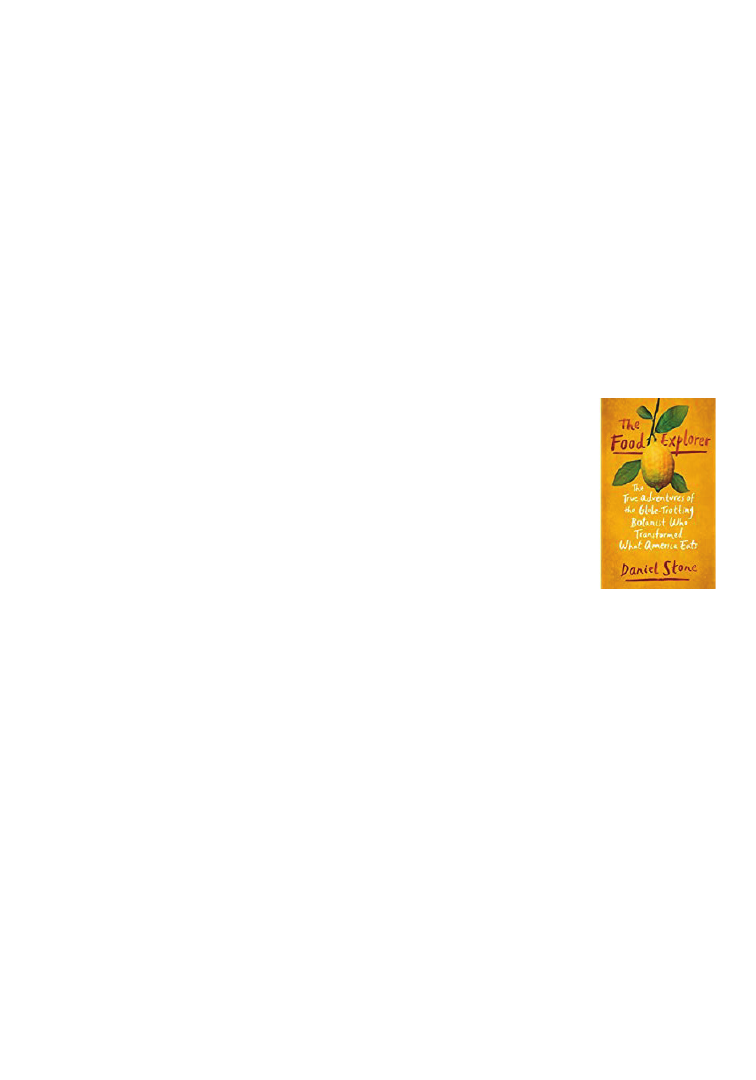
PSB 64 (2) 2018
127
sesame from Table 6.3, ‘Crops that originated
in South Asia’. Also oddly, sesame is listed
in Table 4.1 (p. 149) among ‘Crops that
originated in Northern Africa’! References
show alternative studies. Some coordination
was missing, allowing these discrepancies to
creep in.
–Dorothea Bedigian, Research Associate, Mis-
souri Botanical Garden, St. Louis, Missouri,
USA
References
Bedigian, D. 1988. Sesamum indicum L. (Peda-
liaceae): Ethnobotany in Sudan, crop diversity,
lignans, origin, and related taxa. In P. Goldblatt
and P.P. Lowry, Eds. Modern Systematic Studies
in African Botany 25: 315-321. AETFAT Mono-
graphs in Systematic Botany, Missouri Botanical
Garden, St. Louis, MO.
Bedigian, D. 2003. Evolution of sesame revisited:
domestication, diversity and prospects. Genetic
Resources and Crop Evolution 50: 779-787.
Bedigian, D. 2014. A new combination for the In-
dian progenitor of sesame, Sesamum indicum L.
(Pedaliaceae). Novon 23(1): 5-13.
Bedigian, D. 2015. Systematics and evolution in
Sesamum L. (Pedaliaceae), part 1: Evidence re-
garding the origin of sesame and its closest rel-
atives. Webbia: Journal of Plant Taxonomy and
Geography 70(1): 1-42.
Bedigian, D., D.S. Seigler and J.R. Harlan. 1985.
Sesamin, sesamolin and the origin of sesame. Bio-
chemical Systematics and Ecology 13: 133-139.
Bestel, S., G.W. Crawford, L. Liu, J. Shi, Y. Song,
and X. Chen. 2014. The evolution of millet do-
mestication, Middle Yellow River Region, North
China: Evidence from charred seeds at the late
Upper Paleolithic Shizitan Locality 9 site. The
Holocene 24(3): 261-265.
Deng, Z., L. Qin, Y. Gao, A.R. Weisskopf, C.
Zhang, and D.Q. Fuller. 2015. From Early Do-
mesticated Rice of the Middle Yangtze Basin to
Millet, Rice and Wheat Agriculture: Archaeobo-
tanical Macro-Remains from Baligang, Nanyang
Basin, Central China (6700–500 BC). PLoS One
10(10): e0139885.
Lu H., J. Zhang, K. Liu, N. Wu, Y. Li, K. Zhou,
M. Ye, T. Zhang, H. Zhang, X. Yang, L. Shen,
D. Xu and Q. Li. 2009. Earliest domestication of
common millet (Panicum miliaceum) in East Asia
extended to 10,000 years ago. Proceedings of the
National Academy of Sciences 106(18): 7367-
7372.
The Food Explorer: The
true adventures of the
globe-trotting botanist
who transformed what
America eats
Daniel Stone
2018. ISBN 978-1-10199-058-2
Hardcover, US$28.00 (Canada
$37.00); 416 pp.
Dutton, New York.
The Food Explorer presents a uniquely
American story, documenting events that
contributed to the wealth of food plants
and other valuable plant life available to
residents in the United States today. David
Fairchild (1869–1954) was responsible for
the introduction of more than 200,000 exotic
plants and varieties of established crops into
the United States between 1894 and 1904,
including avocados, dates, mangos, nectarines,
pistachios, pomegranates, seedless grapes,
soybeans, bamboos, and flowering cherries.
Certain varieties of wheat, cotton, and rice
became especially economically important.
Stone’s biography recounts Fairchild’s
fascinating travel adventures acquiring the
familiar foods we eat and plants we now
utilize without question. He traces early plant
introduction to the United States by David

PSB 64 (2) 2018
128
Fairchild and close professional associates,
Frank Meyer and Wilson Popenoe.
Fairchild grew up in Kansas in post-Civil
War 19th century. Having studied botany and
horticulture at Kansas College, he created a
way to combine his love of plants and travel
into a job with the nascent U.S. Department
of Agriculture. At the age of 22, he created
the Section of Foreign Seed and Plant
Introduction, which he led for 37 years. He
traveled to more than 50 countries on every
continent, in search of worthwhile seeds and
cuttings. At the time, such travel was rare,
in an era when international travel was very
challenging and done by ship.
Barbour Lathrop, a wealthy philanthropist
whom Fairchild met on an ocean liner,
financed his travels. Fairchild met people
from all levels of society; some were hostile.
He committed botanical espionage; he
succumbed to typhoid, got arrested in
Corsica, was shot with arrows, and nearly fell
off a mule on a narrow path beside a deep
canyon in the Andes while looking for quinoa.
Ultimately, Fairchild developed a strategy of
talking with people, visiting markets, and
learning by observing what people are eating
and what they were growing. Since much
economic endeavor in the United States at
that time depended on farming, the growth of
America was aligned with the expansion and
improvement of agricultural commodities.
Through Fairchild, and blessed by a variety
of ecological zones, the United States was
transformed to have a diversified food system,
providing rich dietary choices.
Some amusing events are recounted,
just as originally told by Fairchild in his
autobiography, The World Was My Garden
(1938).
In 1902, he was traveling in Asia,
looking for mangos that would thrive in the
United States. He bought big baskets of several
cultivars, but the loads in his baskets of whole
fruits were deemed to be too large to board
onto the ship and the steamer was about to
depart. Realizing that the items he needed to
send home were only seeds, not whole fruit,
Fairchild rounded up a group of local boys
on the pier, paying them to eat the fruit and
give him the seeds, which he hastily packed
in charcoal.
Stone also delves into the life and psyche of
Frank Meyer, who was hired by Fairchild as
a field explorer once Fairchild had married
and settled down to his permanent post in
Washington D.C. Meyer was a zealously
dedicated collector who traveled in China
extensively, much of it on foot, through
regions where locals hated foreigners
intensely. Eventually danger, deprivation,
disappointment, loneliness, and isolation
resulted in Meyer’s descent into depression.
Fairchild was unable to help and unable to
provide the necessary supportive counsel.
Meyer’s trajectory was tragic.
Through Charles Marlatt, a childhood
acquaintance of Fairchild who had matured
as an entomologist, the reader gets a balanced
view but is warned about the downside of those
endeavors, because the tons of samples sent
home to Washington were not quarantined
and thoroughly inspected. Therefore, plant
diseases and pests were imported too, such as
the codling moth, Hessian fly, asparagus beetle,
hop-plant louse, cabbage worm, wheat-plant
louse, pea weevil, Croton bug, boll weevil,
San Jose scale, gypsy moth, brown-tail moth,
Argentinian ant, and alfalfa-leaf weevil. It was
nearly impossible to control problems once
they were released into the ecosystem.
The plant importation trend introduced
a series of errors. Spotted knapweed is an
aggressive noxious biennial that suppresses
native grasses and has now spread to 7 million

PSB 64 (2) 2018
129
acres. Grazing animals avoid it. Leafy spurge
now inhabits 2.5 million acres, and only
some types of goats can eat it. As a result,
biological deserts are expanding and are
extremely expensive to eliminate. Among
the gravest ecological catastrophes caused
by imported plants was chestnut blight. It
was first noticed on American chestnut trees
at New York’s Bronx Zoo in 1904. At that
time, chestnuts were a canopy species in 8.8
million acres of eastern forest. They were
majestic, providing an abundance of food for
wildlife. Chestnut wood was rot resistant, did
not warp or shrink, and was useful in many
ways, such as for ornamental interior wood
trim. Spores of the blight fungus spread so
that within 40 years, the American chestnut
was a threatened species. Four billion trees
died. Marlatt argued that the blight could have
been prevented if the federal government had
wisely quarantined and inspected all imported
plants. Fairchild thought this was a ridiculous
idea, impeding the speed of progress for no
good reason. Marlatt was vindicated when
Congress passed the Plant Quarantine Act
in 1912, and inspections were the domain of
the Federal Agricultural Board, which Marlatt
controlled.
But missing from these pages is a more
considered, analytical assessment about
the perils of plant introduction. Stone fails
to mention any cautionary notes against
bio-piracy—the theft of another country’s
botanical heritage—nor present-day rigorous
regulations by governments protecting their
valuable genetic resources. Stone’s narrative
style is rambling, with many meandering
digressions. It may appeal to an audience of
amateurs with culinary interests or armchair
travelers. However, for any serious seeker,
Fairchild’s own autobiography is the source
Stone rephrases. Several of Fairchild’s many
archival black-and-white photographs are
reproduced, along with eight lovely botanical
illustrations in color on quality paper stock,
of Corsican citron, cashew nut, papaya,
mangosteen, avocado, grapes, mango, and
watermelon. Nine pages of a bibliography, 47
pages of notes, and an 11-page index close the
book.
–Dorothea Bedigian, Research Associate,
Missouri Botanical Garden, St. Louis, Missouri,
USA
Literature Cited
Fairchild, D., E. Kay, and A. Kay. 1938. The World
Was My Garden: Travels of a Plant Explorer. C.
Scribner’s Sons, NY.Top of FormBottom of Form
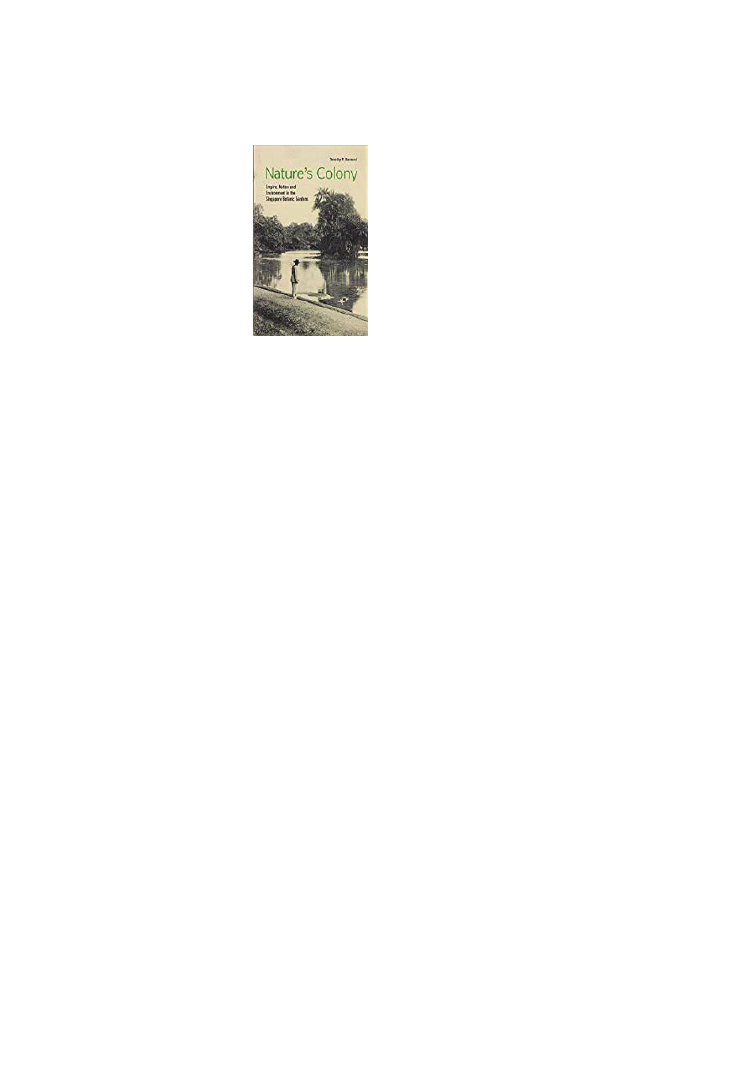
PSB 64 (2) 2018
130
HISTORICAL
Nature’s Colony: Empire,
Nation and Environment
in the Singapore Botanic
Gardens
Timothy P. Barnard
2016. ISBN: 978-981-4722-22-3
Paperback, SGD$34.00. 304 pp.
NUS Press, Singapore
As an institution connected
with a diminutive insular
city-state in Southeast Asia, the Singapore
Botanic Gardens might seem an esoteric subject
for a history monograph. Environmental
historian Timothy Barnard’s Nature’s
Colony: Empire, Nation and Environment
in the Singapore Botanic Gardens makes
a compelling case otherwise. In Barnard’s
handling, the Garden serves as an intriguing
case study in the transition from colonial
to postcolonial botany, in the relationship
between science and state administrative
priorities, and in the ecological management
of a growing metropolis. On the whole, this
is an enjoyable and meticulously researched
book that makes a worthy contribution to the
history of 19th- and 20th-century botany.
For decades subsequent to Singapore’s
founding as a British East India Company
trading post in 1819, European residents
cultivated only a narrow range of commercially
valuable crops. It was not until 1859, when
a well-heeled association of gardening
enthusiasts resolved to establish a “pleasure
garden” (23) on the model of an English estate,
that the Singapore Botanic Gardens came into
existence at its present location. This was a
bourgeois colonial institution through and
through, with restricted access for non-white
and less affluent clientele. In 1874, insufficient
revenues prompted the government to assume
jurisdiction over the garden, whereupon
scientifically trained botanists from Kew
were—for the first time—hired as primary
caretakers. Under the tutelage of Henry
Murton, and later, Nathaniel Cantley, the
Garden acquired a herbarium, arboretum,
and zoological menagerie, and played an
important role in biodiversity conservation
and reforestation. Henry Nicholas Ridley,
the first to hold the title of garden Director,
brought the Garden unprecedented renown by
making it a center for rubber cultivation and
experimentation. This marked the beginning
of the end of the Garden’s dependence on Kew,
as it came increasingly to be seen as a hub of
botanical expertise in a “polycentric network
of science” (169).
By the time Isaac Henry Burkill took on the
directorship in 1912, rubber’s fortunes had
waned, prompting a shift in emphasis from
economic botany to herbarium-based study.
The burgeoning study of orchids, beginning
especially with the directorship of Richard
Eric Holttum in the 1920s, was another sign of
changes underway. These enthusiasms spilled
outside the Garden, in fact, when elite Chinese
and European Singaporeans undertook
sophisticated orchid cultivations of their own.
Orchids took on particular significance after
independence, when hybrids concocted in
the Garden’s laboratories and named after
foreign notables came to serve important
symbolic cultural and diplomatic functions.
Independence also brought challenges,
however, as colonial-era institutions like the
Garden seemed progressively out of place.
Under the rubric of what Barnard calls
“developmental botany” (not to be confused
with similarly named studies of evolutionary
plant biology), this scientific institution
was thus subordinated to the needs of a
modernizing and industrializing nation-state.
Under such constraints, it reverted to the status

PSB 64 (2) 2018
131
of a kind of “recreational park” headed by a
“chief administrator” rather than a “director”
(244). Beginning in 1988 under the leadership
of Tan Wee Kiat, however, who reclaimed the
title of “Director,” the Garden experienced
something of a renaissance spearheaded
by orchid horticulture, conservation, and
experimentation. This rehabilitation ran
full circle when the Singapore Botanic
Gardens achieved UNESCO heritage status
in preparation for the 50th anniversary of
independence, and perhaps even more so
when Nigel P. Taylor—lately of Kew—took up
the directorship in 2011.
Depending on their disciplinary standpoint,
readers may experience occasional points of
frustration. More rigorous interrogation of
sources would have helped to contextualize
some of the author’s primary and archival
materials, not least the repeated reference
to “coolies”—meaning indentured laborers
or slaves, and now considered a highly
derogatory title in many parts of the world—a
term used throughout the early chapters
without qualification. In light of the Garden’s
role as a clearinghouse for plant knowledge
in a highly bioculturally diverse region of
the globe, further discussion of indigenous
knowledge in relation to the collection of
plants—beyond cursory reference to the
“native assistants” (159) who served on
botanical expeditions—would have been
welcome as well. Barnard’s thesis regarding
the role played by the Singaporean Botanic
Gardens in an increasingly “polycentric”
botanical network independent from Kew
and Britain, moreover, would have been well
served by some analysis of the influence of
American botanists in the region, especially
during the Cold War. Finally, given the wealth
of archival research that clearly informs this
work, it is disappointing not to see a more
detailed breakdown of manuscript sources in
the book’s bibliography.
These issues notwithstanding, Nature’s Colony
is a useful work that will interest a diverse
and interdisciplinary readership. Readers
will especially appreciate the book’s studious
attention to vernacular and Latin plant
nomenclature, as well as its gardener’s eye
for horticultural detail. Barnard’s regard for
the hands-on particulars of working with
plants—from Ridley’s method of “calling”
rubber from Hevea brasiliensis (140-1) to the
innovative laboratory process of germinating
orchid seeds without the normally required
symbiotic fungi—is similarly refreshing.
Additionally, many of the anecdotes
recounted by the author are absorbing in their
own right, such as his description of how a
Japanese botanist named Kwan Koriba helped
to save the Singapore Botanic Gardens from
depredation during World War II, and the
almost slapstick-worthy attempts to recapture
a crocodile that escaped from the zoological
gardens. Environmental humanists, for their
part, will welcome the book’s analysis of the
postmodern “greening” of one of world’s most
urbanized societies. Historians of botany,
finally, have gained a proficient survey of
an important botanical institution and an
invaluable starting point for future research.
-Geoff Bil, University of British Columbia

PSB 64 (2) 2018
132
SYSTEMATICS
Catalogue of the
Vascular Plants of New
York State
David Werier
2018. ISBN 978-0-9996525-0-3
Hardcover, US$35.00; Volume
27; 544 pp. + iv
Memoirs of the Torrey Botanical Society
For my research in the Adirondack Mountains
of northern New York, I have relied heavily on
the digital atlas of the New York flora at http://
www.newyork.plantatlas.usf.edu/ of which
David Werier is one of the authors. Catalogue
of the Vascular Plants is a greatly expanded
and meticulously documented outgrowth of
this work. This book is a resource for anyone
interested in the plants of New York State. It
is also an exemplar of how to compile a flora.
An introduction, methods, results, and
acknowledgements comprise the volume. The
introduction includes a summary of floristic
work in the state—starting, appropriately,
with John Torrey—followed by methods.
Here we find how the author studies taxa
from reliable published sources, a survey of
herbaria, and his personal familiarity with the
flora. Synonymy is treated with similar rigor.
There is a documented flora of 1993 native
species for New York State including hybrids
and infraspecific taxa.
A great amount of detail is given to the
nativity of plants with discussions on where
they might or might not persist. If non-native
plants are included, the state flora consists
of 3524 species, meaning that a remarkable
43% of the total flora are non-native plants
and plants of unknown status (uncertainty
as to the taxon being native or non-native).
Also included is the state ranking of rare and
endangered plants.
The bulk of the book consists of three
“appendices.” The first appendix is Accepted
Taxa. For each taxon there is the common
name, synonymy, and a voucher—a
designated herbarium specimen documenting
the presence of that species in the state. The
second appendix, Excluded List, is a likewise
detailed listing of plants that should be
considered as non-native. The third appendix,
Expected List, includes plants that can be
expected based on reports from contiguous
and nearby states. Both the excluded and
the expected list are well-documented with
literature and herbarium references.
Extensive references and a comprehensive
index of common and scientific names
conclude this well-edited, sturdily bound
volume.
The Torrey Botanical Club is to be commended
for publishing this work, continuing their
tradition of supporting floristic work in
the Northeastern United States. It is an
appropriate production for the society’s 150th
anniversary.
Catalogue of the Vascular Plants of New
York State will be a requisite resource for
professional botanists, ecologists, and
resource managers interested in the dynamic
flora of the state.
-Lytton John Musselman, Department of
Biological Sciences, Old Dominion University,
Norfolk, Virginia 23529-0266
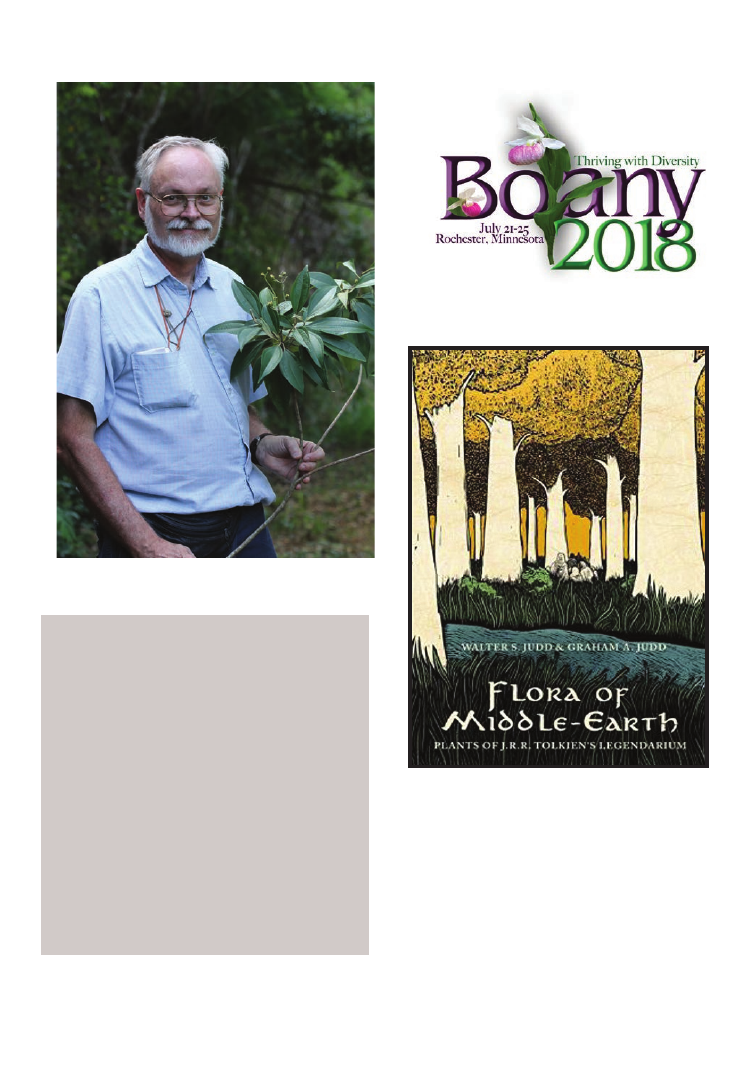
PSB 64 (2) 2018
133
Come and Meet
Walter Judd,
Plenary Speaker
and
Graham Judd
at Botany 2018
Sunday, July 22, 7:30 pm
with a book signing
immediately afterward
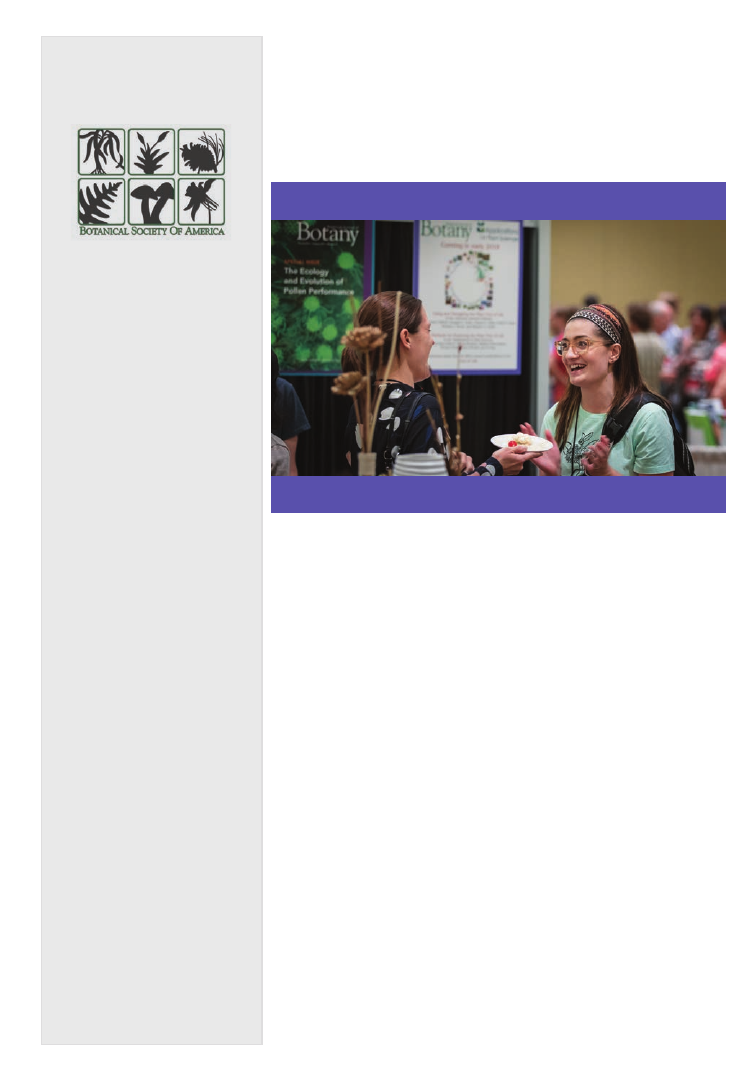
Plant Science Bulletin
Featured Image
The Botanical Society of
America is a membership soci-
ety whose mission is to: pro-
mote botany, the field of basic
science dealing with the study
& inquiry into the form, func-
tion, development, diversity,
reproduction, evolution, & uses
of plants & their interactions
within the biosphere.
ISSN 0032-0919
Published quarterly by
Botanical Society of America, Inc.
4475 Castleman Avenue
St. Louis, MO 63166-0299
Periodicals postage is paid at
St. Louis, MO & additional
mailing offices.
POSTMASTER:
Send address changes to:
Botanical Society of America
Business Office
P.O. Box 299
St. Louis, MO 63166-0299
bsa-manager@botany.org
The yearly subscription rate
of $15 is included
in the membership
Address Editorial Matters (only) to:
Mackenzie Taylor, Editor
Department of Biology
Creighton University
2500 California Plaza
Omaha, NE 68178
Phone 402-280-2157
psb@botany.org
Plant Science Bulletin
SUMMER 2018 Volume 64 Number 2
Although BOTANY conferences are always full of fantastic
speakers, informative talks and posters, and social events
in the evenings, the greatest benefit is the chance meeting,
the unexpected conversation, and the sudden partnership
or collaboration. BOTANY conferences are great for new
connections and old friendships—and we can't wait to see
everyone at our upcoming conferences!
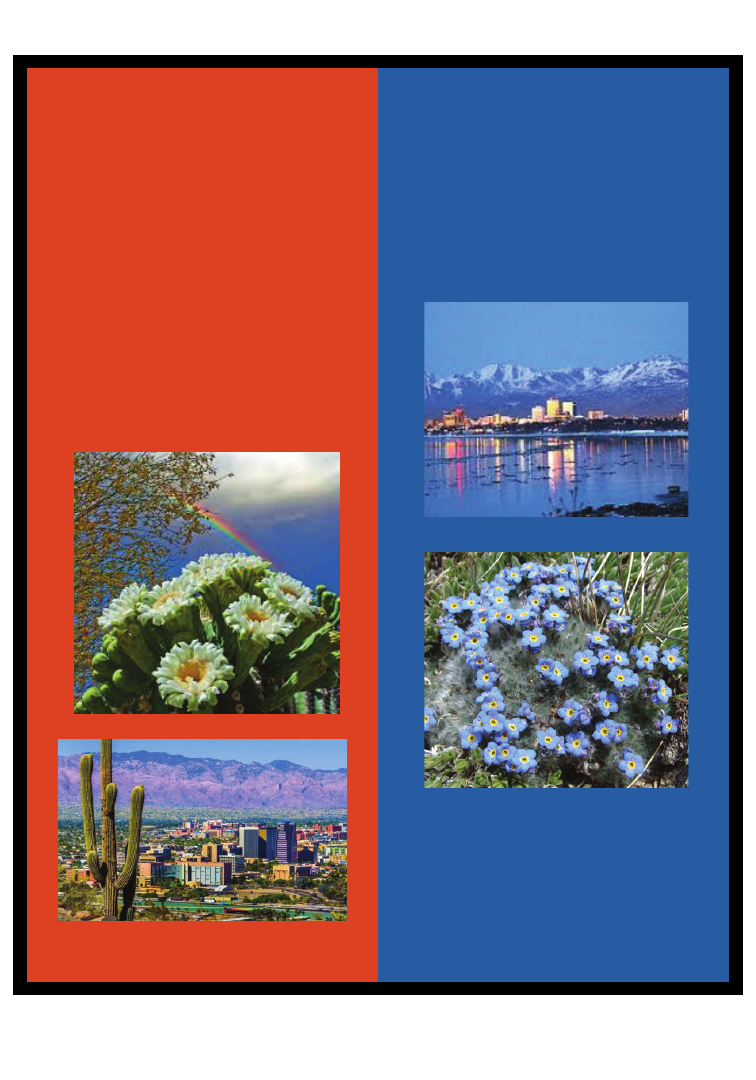
Plan your Botany Summers
Now!
Botany 2019
Tucson, Arizona
July 27 - 31, 2019
Botany 2020
Anchorage, Alaska
July 18 – 22, 2020
Fire and Ice!